inbox and environment news: Issue 548
July 31 - August 6, 2022: Issue 548
National Tree Day 2022: July 31
Northern Beaches Clean Up Crew: Whale Beach - Sunday July 31st
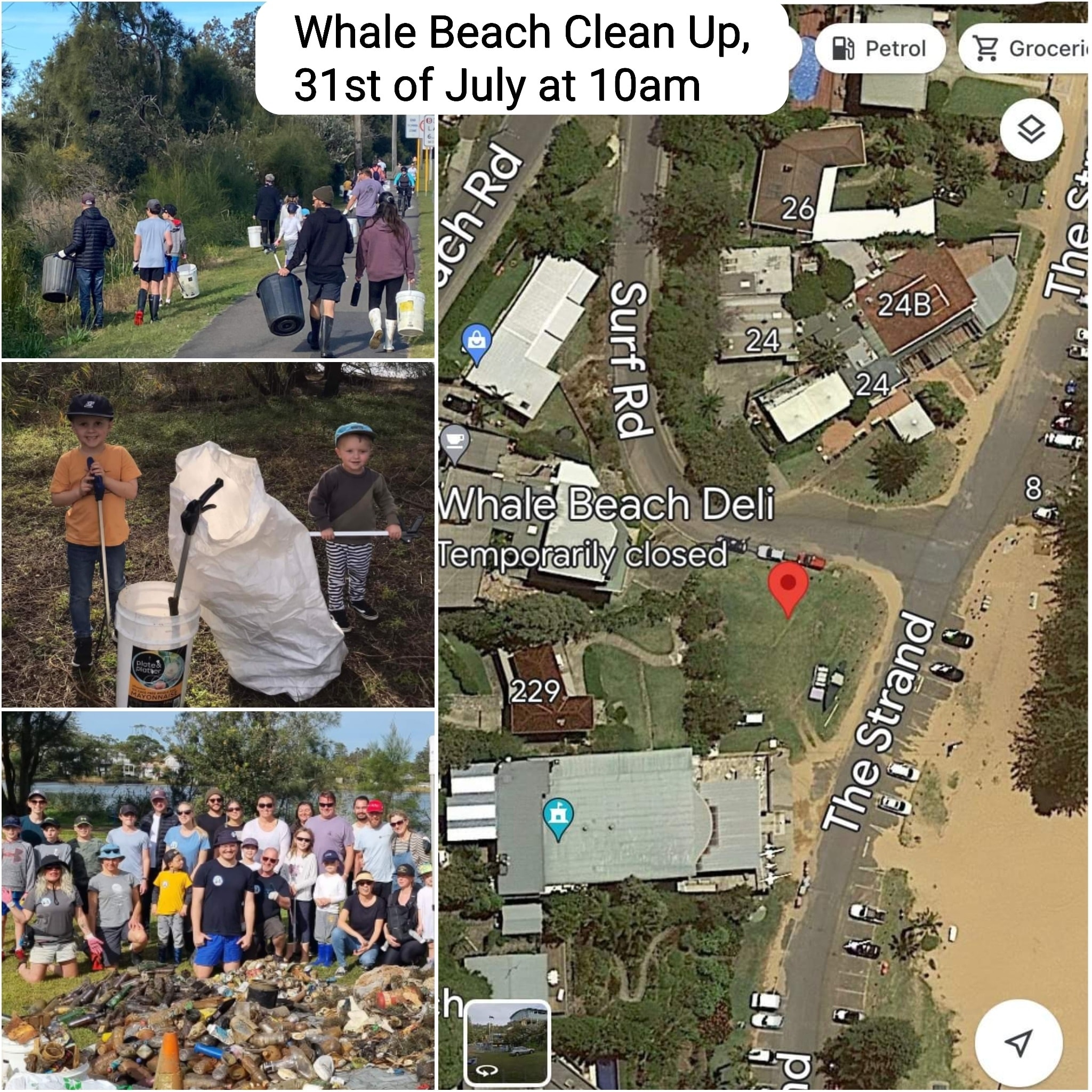
Seagull Pair At Turimetta beach: Spring Is In The Air!
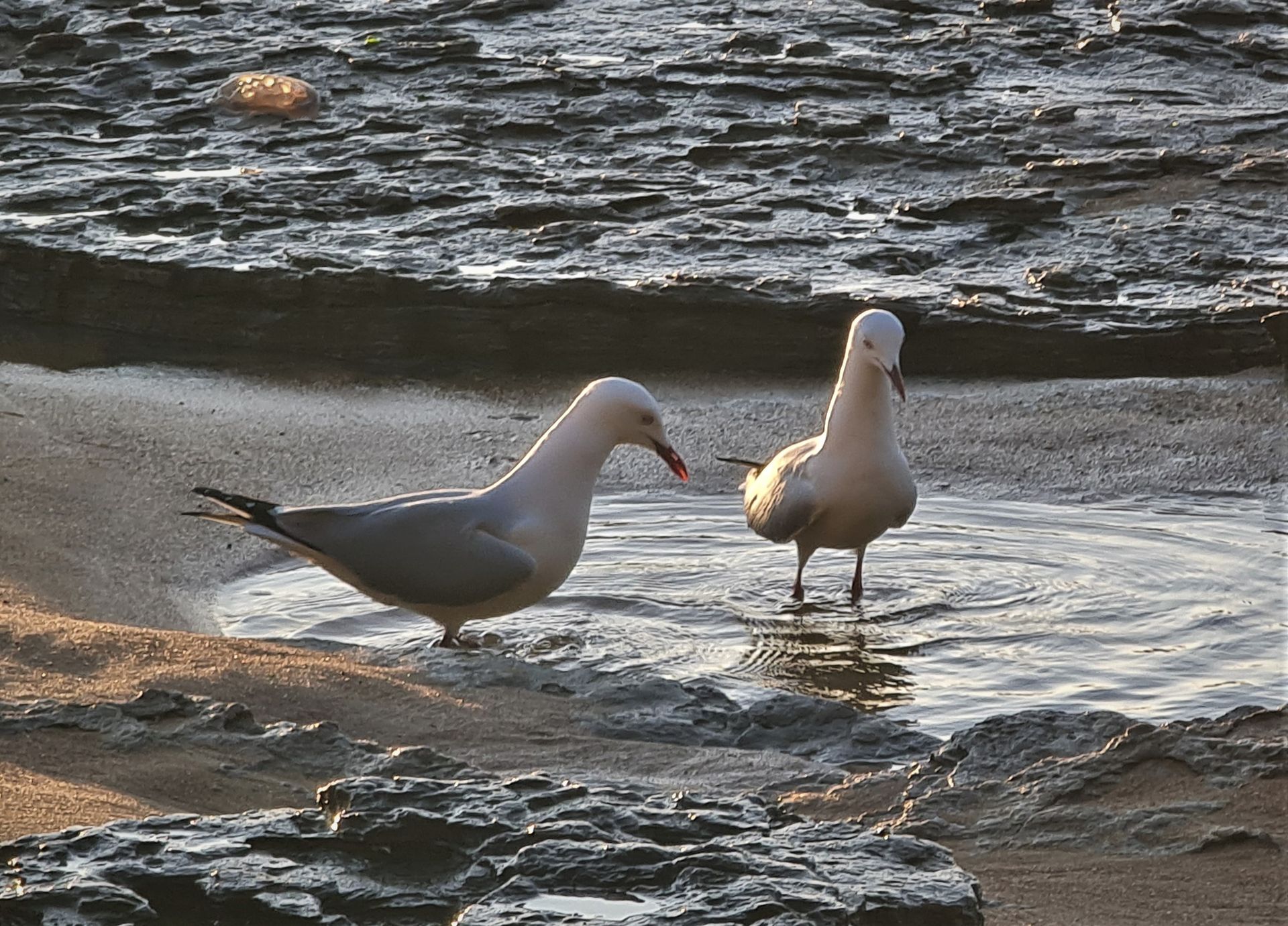
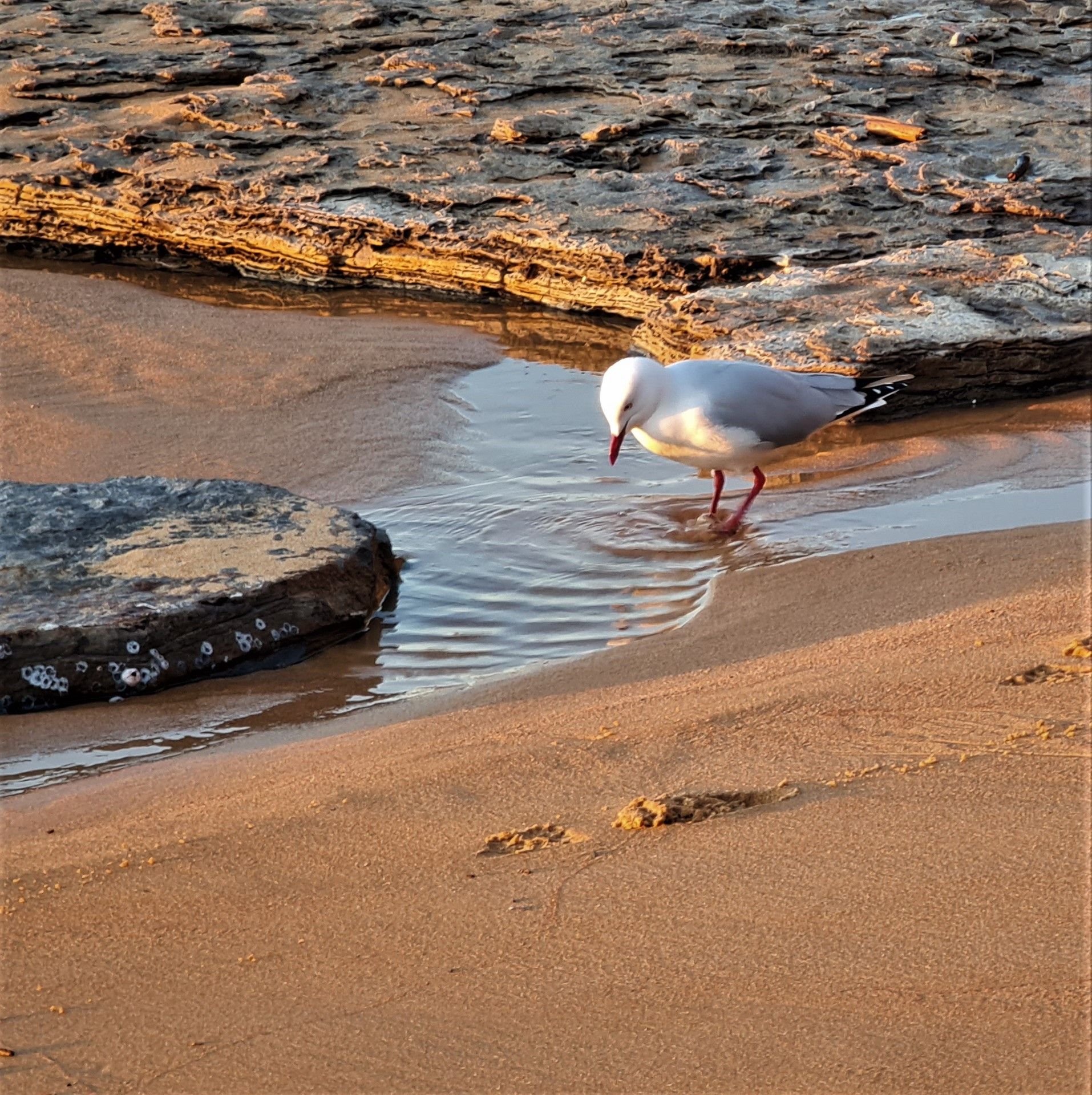
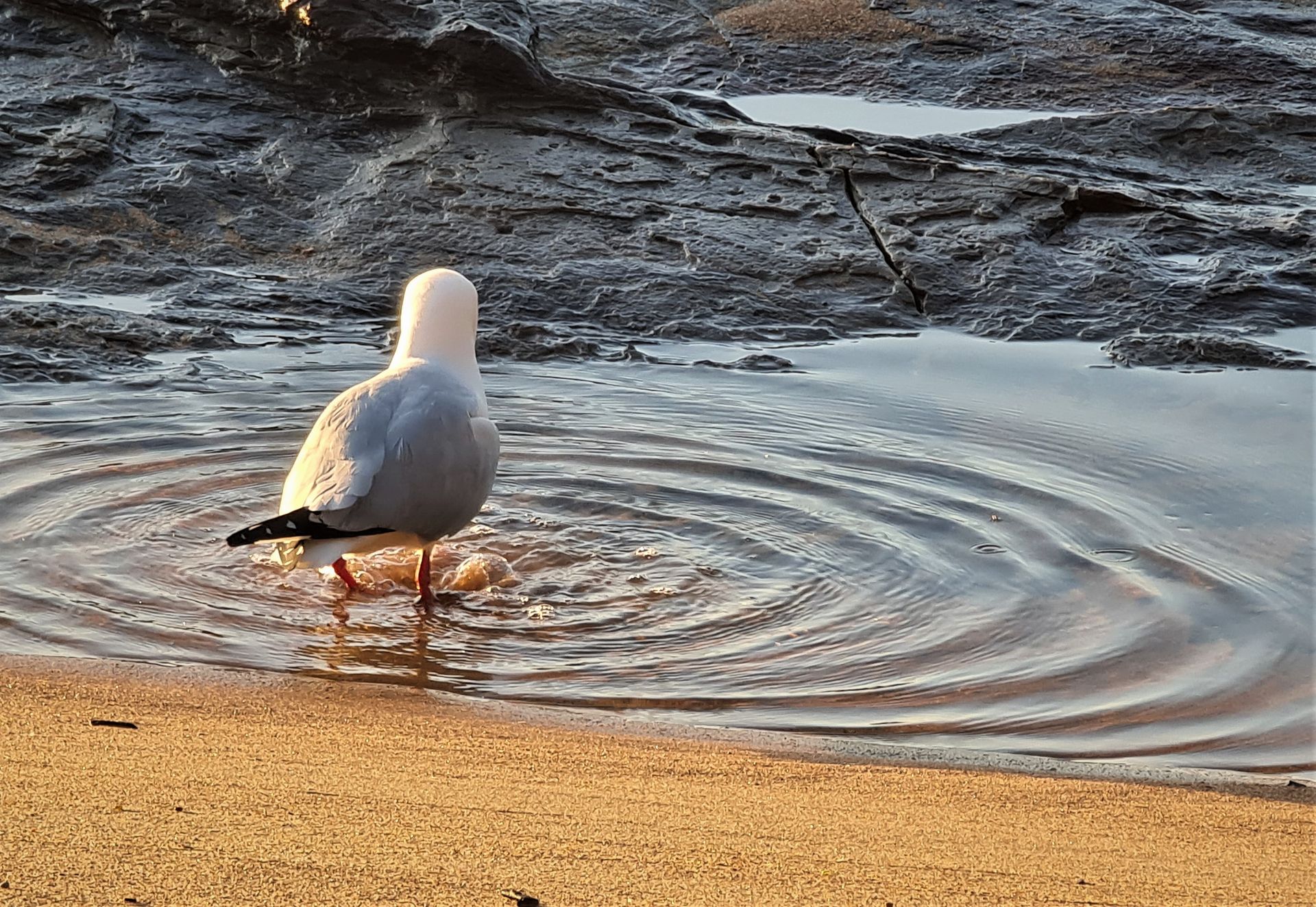
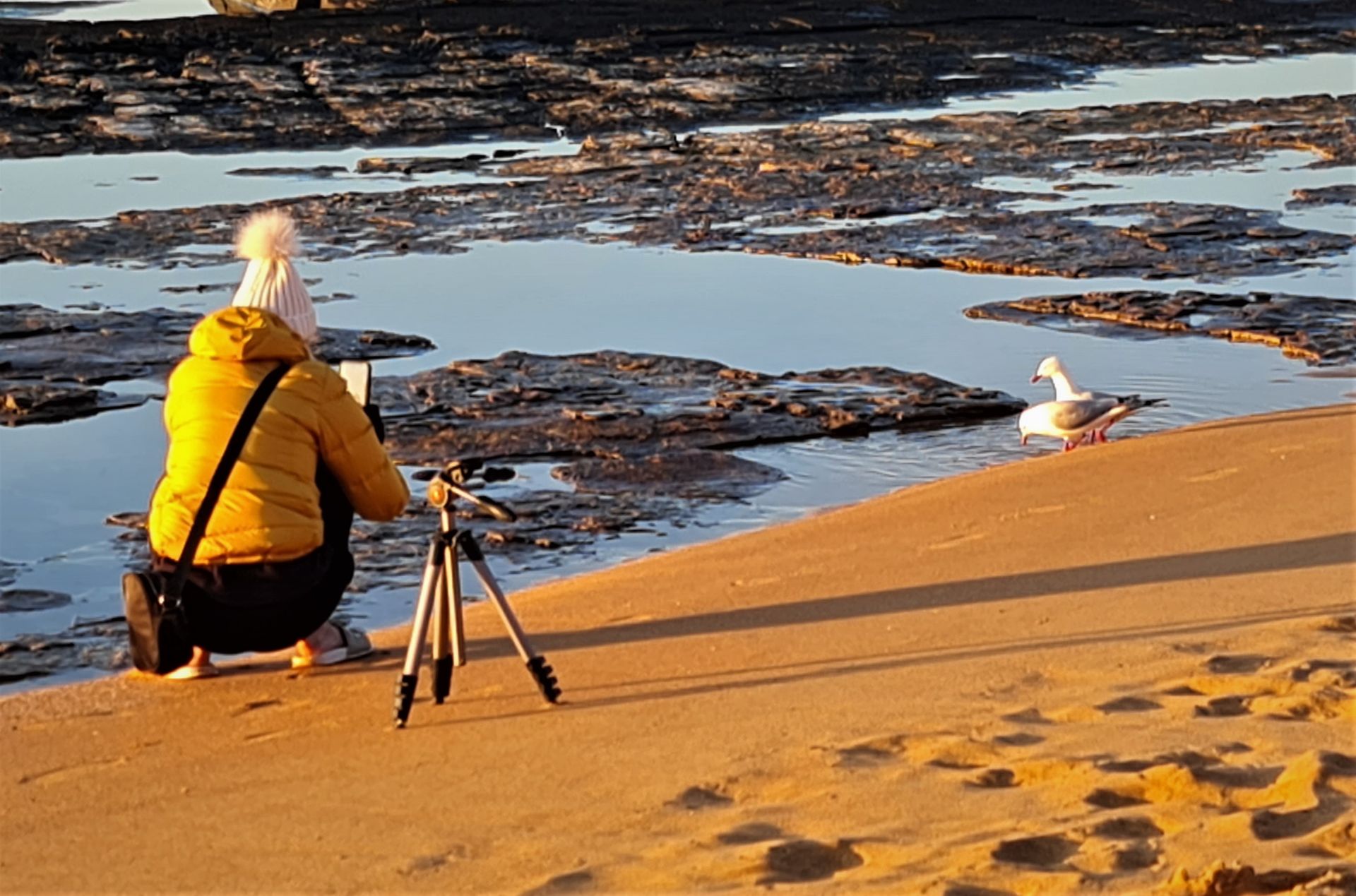
Magpie Breeding Season: Avoid The Swoop!
- Try to avoid the area. Do not go back after being swooped. Australian magpies are very intelligent and have a great memory. They will target the same people if you persist on entering their nesting area.
- Be aware of where the bird is. Most will usually swoop from behind. They are much less likely to target you if they think they are being watched. Try drawing eyes on the back of a helmet or hat. You can also hold a long stick in the air to deter swooping.
- Keep calm and do not panic. Walk away quickly but do not run. Running seems to make birds swoop more. Be careful to keep a look out for swooping birds and if you are really concerned, place your folded arms above your head to protect your head and eyes.
- If you are on your bicycle or horse, dismount. Bicycles can irritate the birds and the major cause of accidents following an encounter with a swooping bird, is falling from a bicycle. Calmly walk your bike/horse out of the nesting territory.
- Never harass or provoke nesting birds. A harassed bird will distrust you and as they have a great memory this will ultimately make you a bigger target in future. Do not throw anything at a bird or nest, and never climb a tree and try to remove eggs or chicks.
- Teach children what to do. It is important that children understand and respect native birds. Educating them about the birds and what they can do to avoid being swooped will help them keep calm if they are targeted. Its important children learn to protect their face.
Wanted: Photos Of Flies Feeding On Frogs (For Frog Conservation)
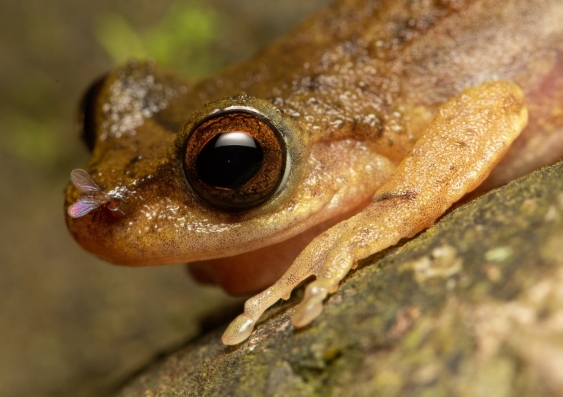
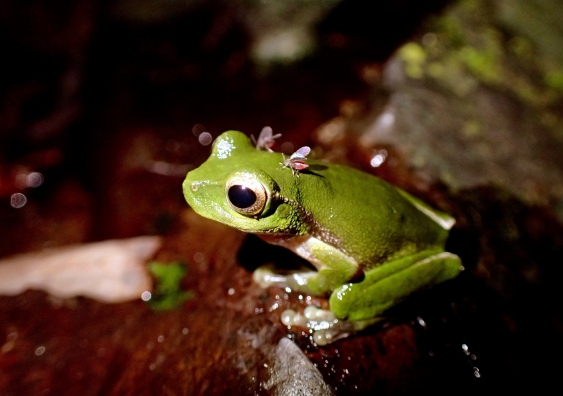
Possums In Your Roof?: Do The Right Thing

Local Wildlife Rescuers And Carers State That Ongoing Heavy Rains Are Tough For Us But Can Be Tougher For Our Wildlife:
- Birds and possums can be washed out of trees, or the tree comes down, nests can disintegrate or hollows fill with water
- Ground dwelling animals can be flooded out of their burrows or hiding places and they need to seek higher ground
- They are at risk crossing roads as people can't see them and sudden braking causes accidents
- The food may disappear - insects, seeds and pollens are washed away, nectar is diluted and animals can be starving
- They are vulnerable in open areas to predators, including our pets
- They can't dry out and may get hypothermia or pneumonia
- Animals may seek shelter in your home or garage.
You can help by:
- Keeping your pets indoors
- Assessing for wounds or parasites
- Putting out towels or shelters like boxes to provide a place to hide
- Drive to conditions and call a rescue group if you see an animal hit (or do a pouch check or get to a vet if you can stop)
- If you are concerned take a photo and talk to a rescue group or wildlife carer
There are 2 rescue groups in the Northern Beaches:
Sydney Wildlife: 9413 4300
WIRES: 1300 094 737
Please be patient as there could be a few enquiries regarding the wildlife.
Generally Sydney Wildlife do not recommend offering food but it may help in some cases. Please ensure you know what they generally eat and any offerings will not make them sick. You can read more on feeding wildlife here
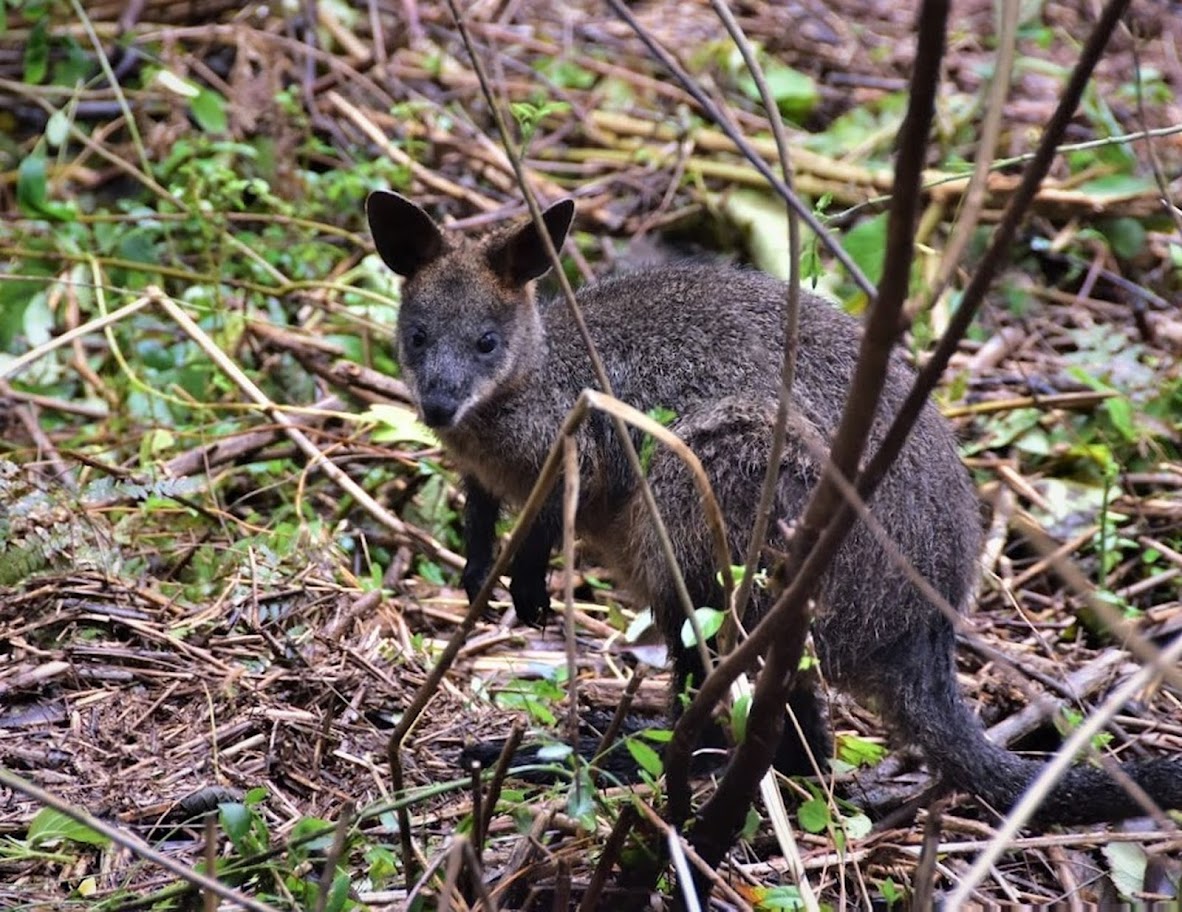
Information courtesy Ed Laginestra, Sydney Wildlife volunteer. Photo: Warriewood Wetlands Wallaby by Kevin Murray, March 2022.
Aviaries + Possum Release Sites Needed

Sydney Wildlife Rescue: Helpers Needed
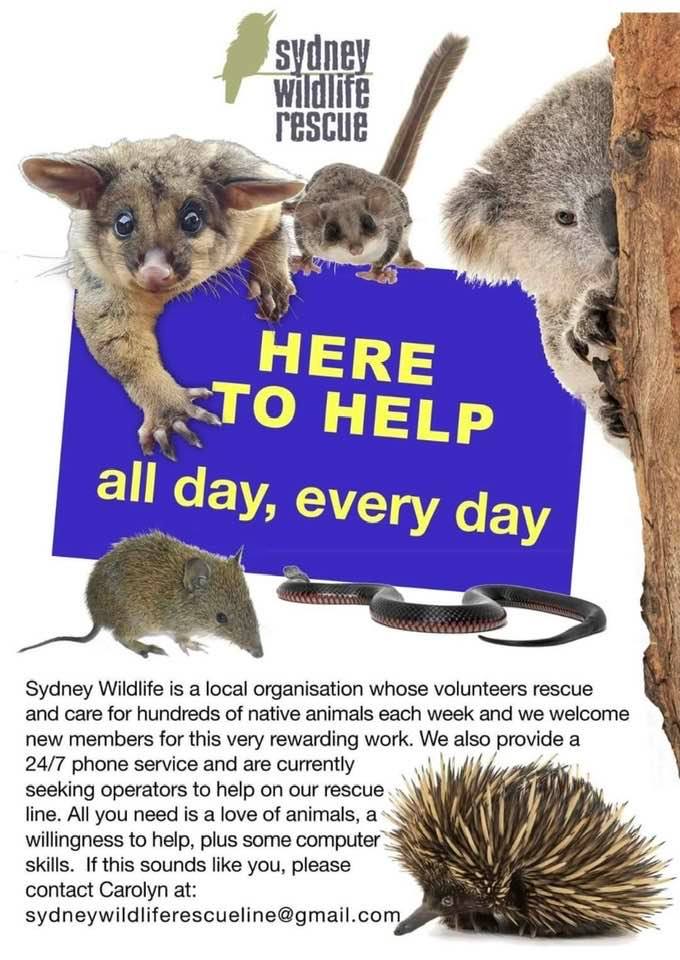
Bushcare In Pittwater
Where we work Which day What time
Avalon
Angophora Reserve 3rd Sunday 8:30 - 11:30am
Avalon Dunes 1st Sunday 8:30 - 11:30am
Avalon Golf Course 2nd Wednesday 3 - 5:30pm
Careel Creek 4th Saturday 8:30 - 11:30am
Toongari Reserve 3rd Saturday 9 - 12noon (8 - 11am in summer)
Bangalley Headland 2nd Sunday 9 to 12noon
Bayview
Winnererremy Bay 4th Sunday 9 to 12noon
Bilgola
North Bilgola Beach 3rd Monday 9 - 12noon
Algona Reserve 1st Saturday 9 - 12noon
Plateau Park 1st Friday 8:30 - 11:30am
Church Point
Browns Bay Reserve 1st Tuesday 9 - 12noon
McCarrs Creek Reserve Contact Bushcare Officer To be confirmed
Clareville
Old Wharf Reserve 3rd Saturday 8 - 11am
Elanora
Kundibah Reserve 4th Sunday 8:30 - 11:30am
 Mona Vale
Mona Vale Mona Vale Beach Basin 1st Saturday 8 - 11am
Mona Vale Dunes 2nd Saturday +3rd Thursday 8:30 - 11:30am
Newport
Bungan Beach 4th Sunday 9 - 12noon
Crescent Reserve 3rd Sunday 9 - 12noon
North Newport Beach 4th Saturday 8:30 - 11:30am
Porter Reserve 2nd Saturday 8 - 11am
North Narrabeen
Irrawong Reserve 2nd Saturday 2 - 5pm
Palm Beach
North Palm Beach Dunes 3rd Saturday 9 - 12noon
Scotland Island
Catherine Park 2nd Sunday 10 - 12:30pm
Elizabeth Park 1st Saturday 9 - 12noon
Pathilda Reserve 3rd Saturday 9 - 12noon
Warriewood
Warriewood Wetlands 1st Sunday 8:30 - 11:30am
Whale Beach
Norma Park 1st Friday 9 - 12noon
Western Foreshores
Coopers Point, Elvina Bay 2nd Sunday 10 - 1pm
Rocky Point, Elvina Bay 1st Monday 9 - 12noon
Gardens And Environment Groups And Organisations In Pittwater
Water Sharing Plans: Farmers And Water Users
- by 1 September, licence holders in the Border Rivers and Gwydir valleys will have their water accounts credited and the floodplain harvesting framework will be fully operational
- licences for the Macquarie, Barwon-Darling and Namoi valleys will be determined and will come into effect later this year and in early 2023.
Eastern Bristlebirds Sent South
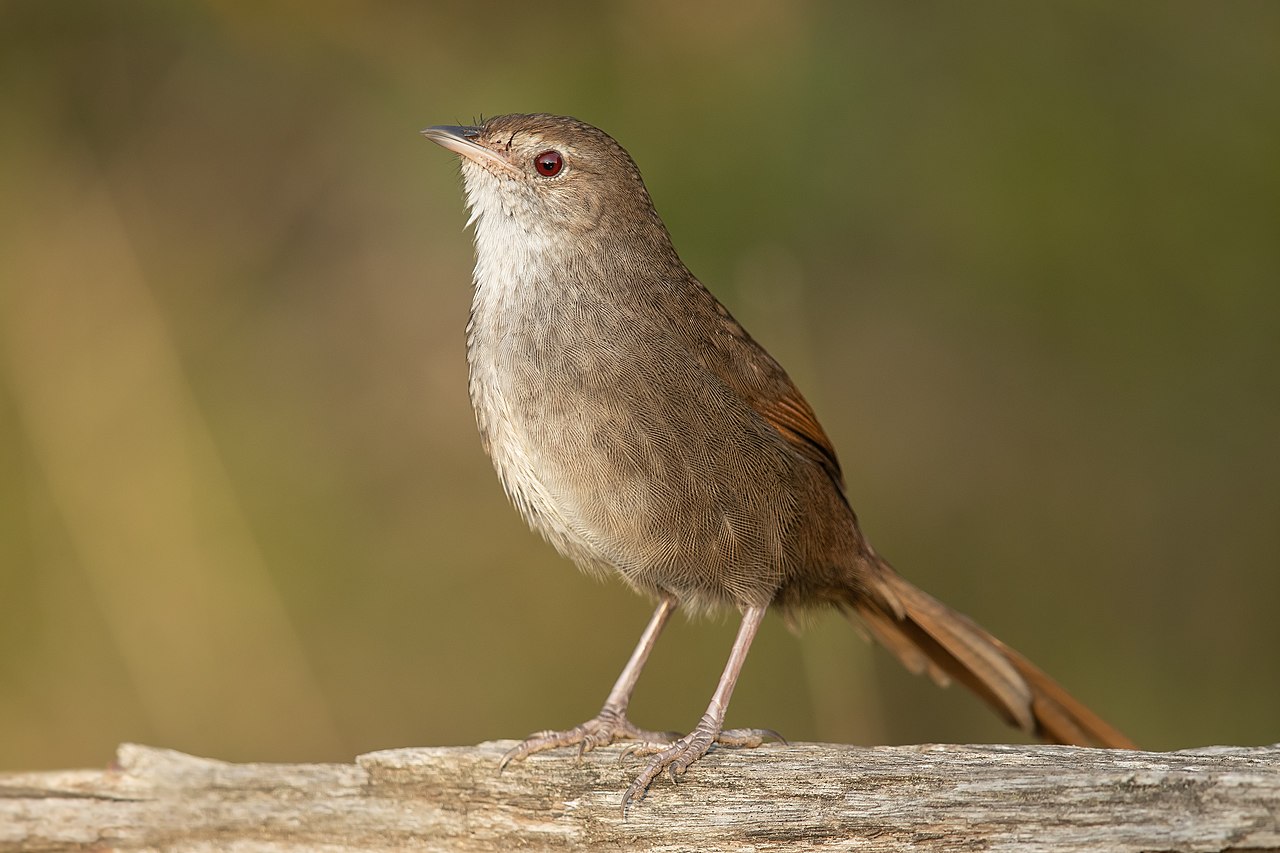
Call Out To Improve Coastal Design
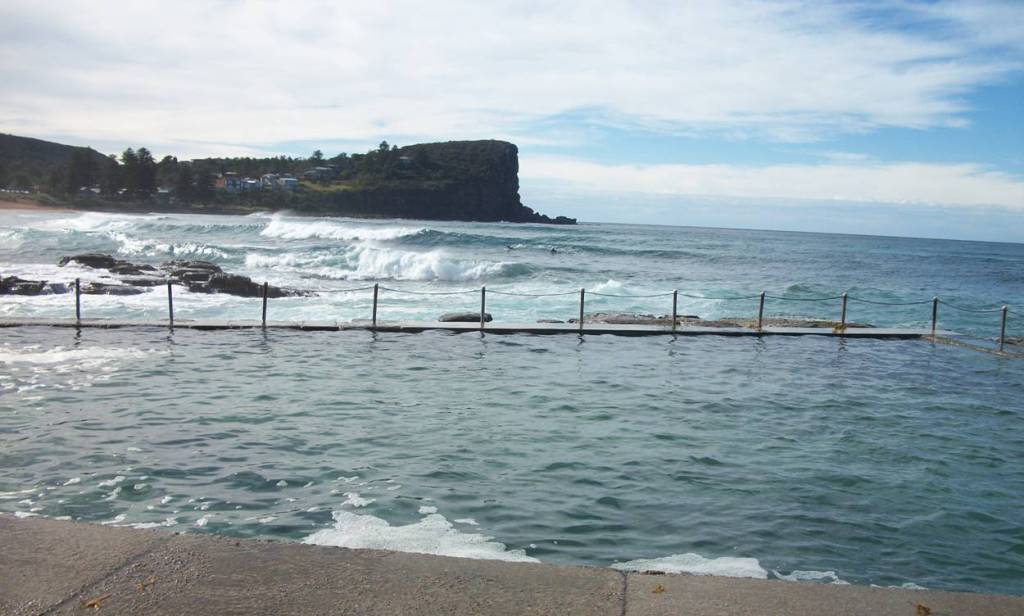
Land IQ To Deliver Savings, Speed Up Planning
Healthy Fish, Healthy Rivers And Healthy Farms
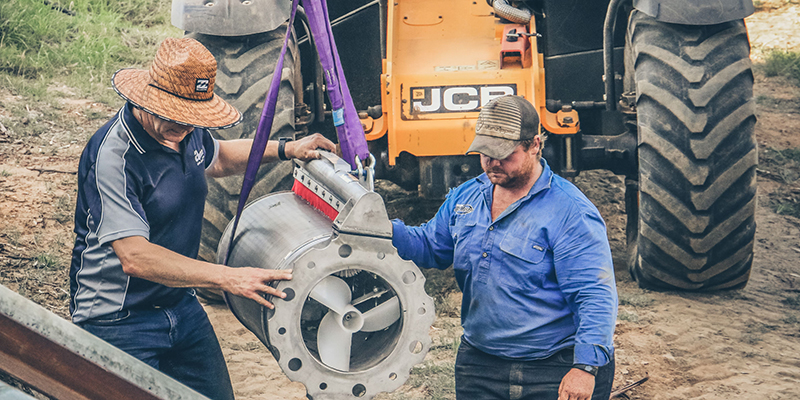 NSW farmers and native fish species will benefit from modern fish-protection screens, which will protect aquatic life as well as valuable farming equipment.
NSW farmers and native fish species will benefit from modern fish-protection screens, which will protect aquatic life as well as valuable farming equipment.Reimbursement For Recreational Beekeepers Impacted By Varroa Mite
- They must decontaminate all vehicles that will be used for transporting honey supers, before and after the move.
- The honey super must be cleared of bees and sealed so no bees can enter.
- The honey supers must be taken to an enclosed space for honey extraction.
- Transportation can only take place within the eradication zone and by using the most direct route.
- Beekeepers must not move any part of the brood box.
- Honey must not be extracted until the honey super is stored in a bee proof manner for 21 days or at -20 degrees Celsius for 72 hours.
Biosecurity Blueprint To Safeguard NSW Agriculture
- Set a clear vision for biosecurity and food safety in NSW;
- Map strategy objectives for Government, industry, and the community; and
- Outline key activities that will guide decision-making for farmers.
Labor has introduced its controversial climate bill to parliament. Here’s how to give it real teeth
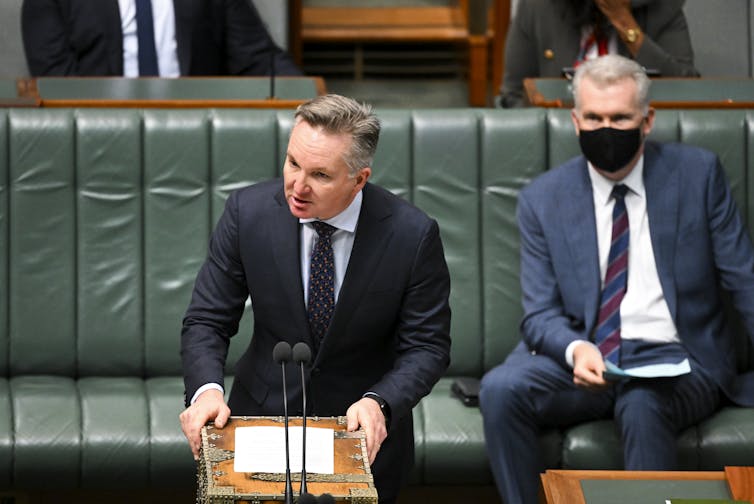
Earlier today, the federal government introduced its hotly awaited climate change bill to parliament. Despite the attention and controversy it’s attracted, the proposed legislation – as it stands – would be almost entirely symbolic.
Labor has updated Australia’s obligations under the Paris Agreement. So we’re already committed to a 43% emissions reduction by 2030, based on 2005 levels.
Enshrining the target in law might send a message that the new government is committed to reducing emissions. But as I explain below, the law will have little material effect.
Labor needs the support of the Greens and one other crossbencher to get the bill through the Senate. Labor won’t concede to the Greens’ core demands, but a climate “trigger” on new developments could ensure the bill has real force.
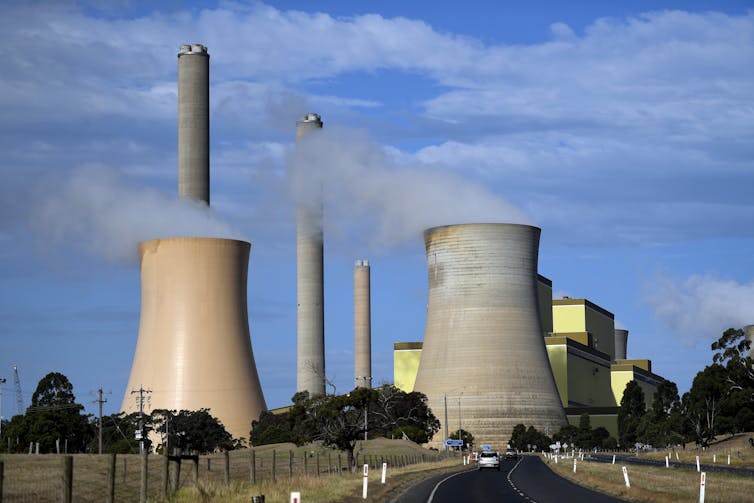
New Laws Are Not Needed
Introducing the bill to parliament on Wednesday, Climate Change and Energy Minister Chris Bowen said Labor’s emissions reduction target of 43% was “ambitious but achievable”. But in fact, the goal is far from ambitious – and in all likelihood will be easily met.
Even before the election, Australia was on track for a 35% emissions reduction – well above the commitment of the Morrison government. This was mainly due to state government action, and rapid take up of clean energy by households and businesses.
Former prime minister Scott Morrison could not publicly admit this, or adjust the government’s official target accordingly, at the risk of antagonising climate denialists on his own side.
But it means Australia is likely to be well on track to achieve the 43% target by the next election – with a little help from Labor’s modest proposed policy changes, and steep increases in the cost of coal, oil and gas. So legislating the target isn’t really necessary.
Nor does Labor need new laws to prevent a future Coalition government from scaling back the emissions reduction target.
Under the Paris Agreement, there is no process to go backwards. Nations are expected to rachet up their pledges until, it is hoped, global emissions fall to a trajectory consistent with global temperature goals.
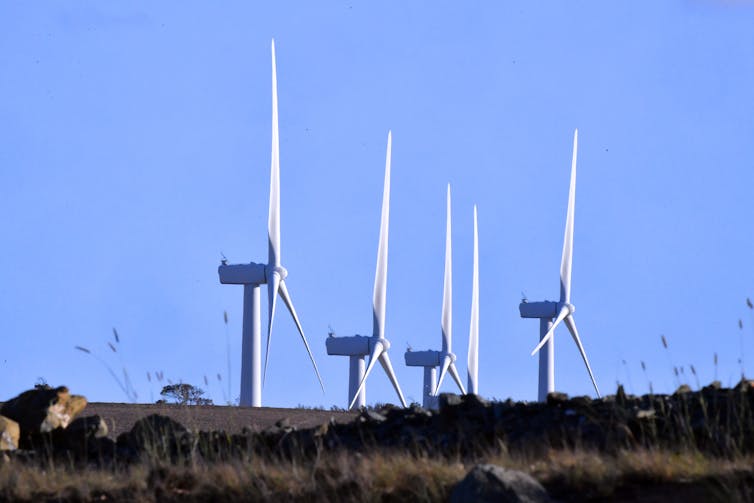
Unless Australian withdrew from the agreement altogether – as the Trump administration did in the United States – the 43% commitment is almost impossible to reverse.
Even ignoring our international commitments, the Coalition is unlikely to propose backtracking on the 43% target.
Even if it went to the next election promising no further action on climate change, Australia would still be on track to hit the target. So modifying the target would bring no policy benefit – and would kill off any chance of recapturing seats lost to teal independents and Greens at the last election.
Labor has proposed to tighten the so-called “safeguard mechanism” established by the previous government. But this policy is achievable under existing law and did not require inclusion in the bill now before parliament.
The mechanism is supposed to prevent big industrial polluters from increasing their emissions beyond a certain cap – a move necessary to protect gains in emissions reduction made elsewhere in the economy.
In theory, polluters receive a financial incentive if their emissions fall below a previously established baseline, and incur a financial cost if their emissions exceed it. But under the Coalition, many polluters were allowed to increase their baselines to avoid being penalised.
Labor has proposed to implement the scheme more effectively. This relatively modest policy will proceed regardless of the climate bill’s passage.
Room To Move On A Climate ‘Trigger’
The Greens have made two key demands in exchange for supporting Labor’s climate bill in the Senate: increasing the 43% target and a ban on new coal and gas projects.
There is virtually no chance Labor will agree to a higher target – given both its election commitments, and the political imperative of not being seen to cave in to the Greens.
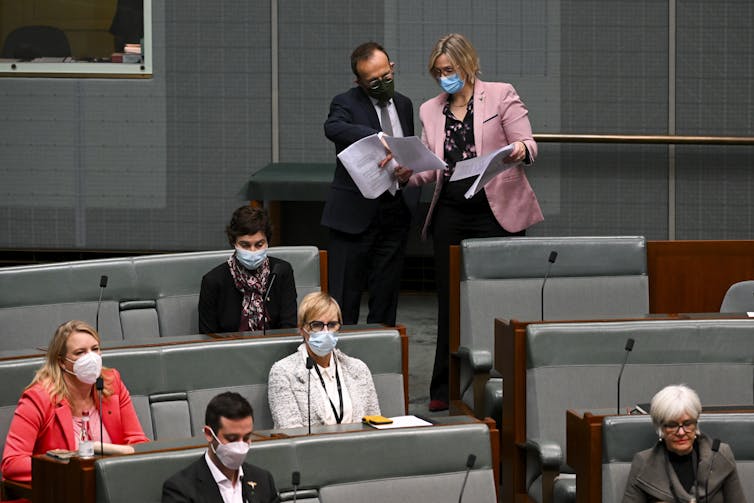
Nor is the government likely to accept an explicit ban on new coal and gas projects, even though the International Energy Agency says such a ban is needed.
There is, however, room for compromise. The Greens have called for the legislation to incorporate a “climate trigger”, which would mean development proposals are not approved unless their impact on climate change has been considered.
The trigger would mean new coal and gas projects could be rejected on the grounds of potential damage to the climate, without Labor having to commit to such a ban.
Labor did not rule out the trigger before the election, and elements of its grassroots membership are calling for the policy to form part of the government’s planned overhaul of federal environment laws.
Making Real Progress
The election in May of an unprecedented number of independent and Green MPs reflected a groundswell of community feeling on the need for climate action. The federal government must take account of this, if the current parliament is to land on a sustainable climate policy.
The Greens and other crossbenchers should not rubber stamp a purely symbolic statement of Labor’s targets. But for their part, they should seek a sensible compromise on measures to help decarbonise the Australian and global economies.
And what of the Dutton-led opposition? The Coalition’s embrace of climate denialism produced one of its worst electoral defeats in history. Even if it votes against the legislation now before parliament, the Coalition’s political recovery depends on it taking a more constructive climate position in future.![]()
John Quiggin, Professor, School of Economics, The University of Queensland
This article is republished from The Conversation under a Creative Commons license. Read the original article.
Nature’s deteriorating health is threatening the wellbeing of Australians, the State of the Environment report finds
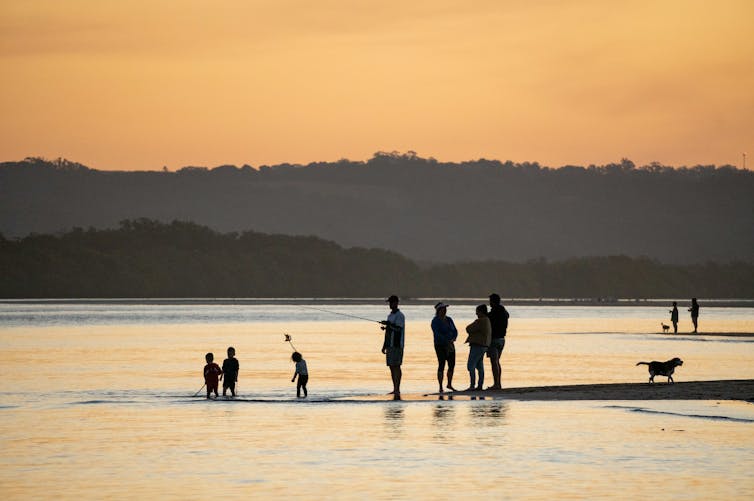
For the first time, the new State of the Environment report explicitly assessed the dependency of humans on nature. We, as report authors, evaluated trends and changes in the environment’s health for their impact on human society. This is described in terms of “human wellbeing”.
Wellbeing encompasses people’s life quality and satisfaction, and is increasingly being recognised in national policy. It spans our physical and mental health, living standards, sense of community, our safety, freedom and rights, cultural and spiritual fulfilment, and connection to Country.
For example, over 85% of Australians live near the coast, and beach activities – swimming, surfing, walking – are an important part of our coastal lifestyle. Such nature-based activities can relieve stress and connect with our individual and national identities. Healthy coastal ecosystems also provide our seafood and support many businesses.
Yet, these ecosystems are under great pressure from human activities. The Great Barrier Reef has suffered four mass bleaching events in the last seven years, kelp forests are in decline in southern Australia, storms are eroding beaches, and coastal fishing pressure is high.
Australia’s ecosystems are collapsing, and our unsustainable actions are threatening our own wellbeing. But there are signs of change, and it’s not too late to make a difference in your own community.
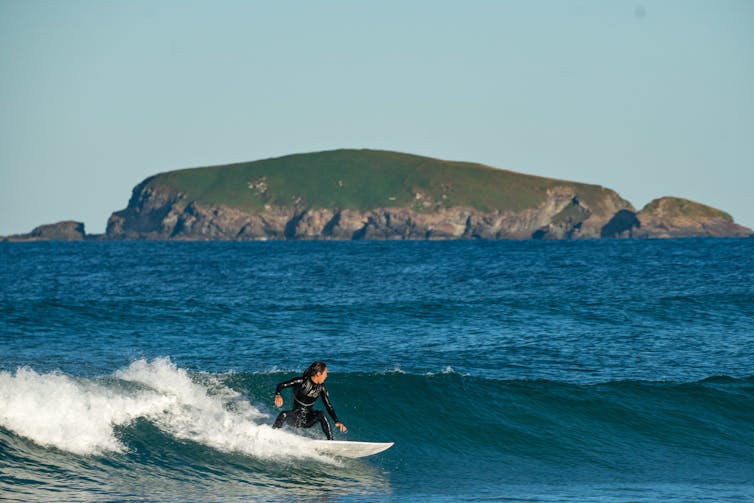
Good, But Deteriorating
The State of the Environment report, released last week, contains several new wellbeing assessments, where data were available.
Overall, wellbeing as determined by the environment is graded as “good but deteriorating”. Examples of such assessments include:
land management: graded partially effective as community participation is improving, but our sense of loss is mounting
extreme events: graded good to date, but deteriorating as climate change impacts accelerate
Antarctica: graded good but deteriorating, as its changing environment will negatively effect marine ecosystems and global climate.
Our urban spaces are ranked well in terms of livability, particularly in Australia’s capital cities. Air and water quality are good most of the time, and Australians can generally access adequate nutrition.
But these conditions are not universal, and they are changing. Remote and rural areas score lower on liveability and some social groups, such as Indigenous people, do not have fair and adequate access to essential resources like fresh water.
Indigenous people in Australia are also disproportionately impacted by extreme events.
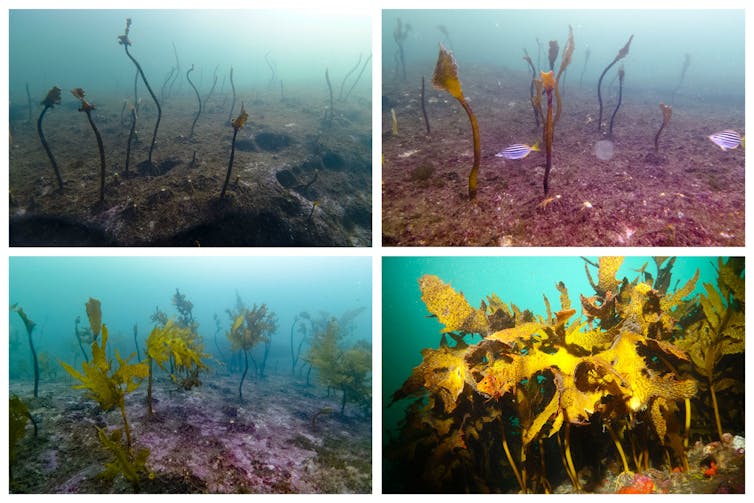
Climate Change Is Already Hurting Our Wellbeing
Previous State of Environment Reports warned of future impacts of climate change. The new report documents impacts already here – and getting worse.
This includes many recent extreme events, from the 2019-2020 bushfires to the recent extreme floods. These have measurable impacts on both our environment and our lives.
While cyclones, floods and bushfires directly destroy our homes and landscapes, heatwaves kill more people in Australia than any other extreme event.
Heatwave intensity in Australia has increased by 33% over the last two decades, with at least 350 deaths between 2000 and 2018. And when heatwaves strike, we see flow-on consequences to, for instance, our hospital emergency departments.
Climate change is also exacerbating air quality issues through dust, smoke and emissions. For example, the 2019-2020 bushfires exposed over 80% of the Australian population to smoke. This exposure killed an estimated 417 people.
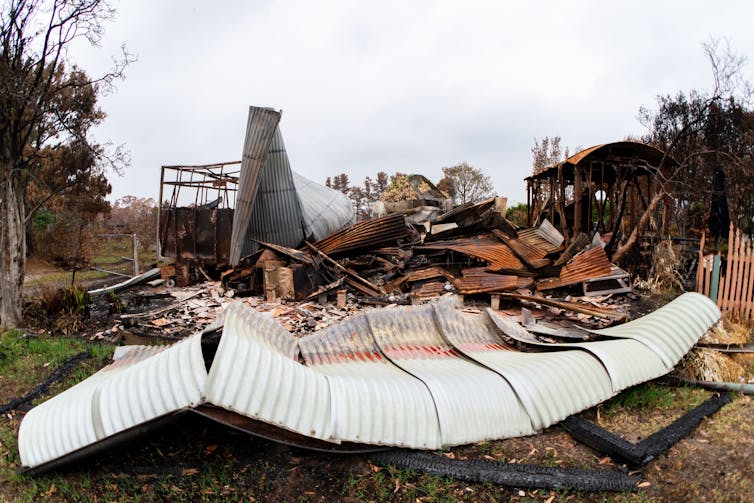
Other pressures to the environment – industrial pollution, land clearing, unsustainable water consumption, extraction of natural resources – also lower our wellbeing, due to their degradation to nature.
These pressures are, of course, often by-products of producing food, water and wealth. We need to find ways to more effectively monitor, manage and prioritise them to ensure they’re sustainable.
A Sustainable Future
The State of the Environment report, for the first time, links to the United Nation’s Sustainable Development Goals, which include good health, quality education, clean energy, and the health of life on land and in the water.
Sustainability means meeting today’s needs without compromising the needs of future generations. It is founded on effective ecosystem protection and environmental stewardship.

The State of the Environment report contains a range of recommendations to tackle our sustainability challenges. Foremost is the need to strengthen and build connections: between people and Country, economics and environment.
Learning from and empowering Indigenous management of Country is a key part of this success, as is greater national leadership, reducing pollution, better monitoring, and long-term reliable funding for the environment.
An important step is the environment minister’s recent announcement that Australia’s proposed wellbeing budget will include environmental factors.
Establishing more protected areas with higher standards of protection is another important part of the solution. The federal government’s recent commitment to expand Australia’s national estate to protect 30% of land and 30% of oceans by 2030 is a good start.
However, we must be careful to ensure this protection is effective and representative of all our precious ecosystems.
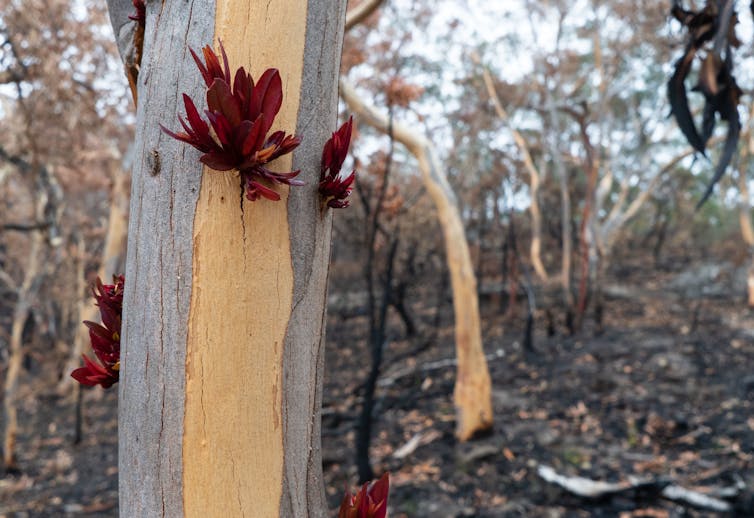
What Can You Do?
There’s much we can do at a personal level, too. You can become informed about the urgency of the twin climate and biodiversity crises - and getting familiar with the State of Environment Report is a great place to start.
Immersing yourself in nature, and encouraging children to do so as well, is also essential. Spending time in nature raises our understanding of its plight.
There are also opportunities to make a tangible impact on the wellbeing of our communities by getting involved in nature restoration, citizen science and other community programs.
We don’t lack the knowledge of what needs to be done. What we need now is urgent action by individuals, organisations and government. Our lives, and our environmental life support system, depend on it.![]()
John Turnbull, Postdoctoral Research Associate, University of Sydney and Emma Johnston, Professor and Deputy Vice-Chancellor (Research), University of Sydney
This article is republished from The Conversation under a Creative Commons license. Read the original article.
Urban patchwork is losing its green, making our cities and all who live in them vulnerable

One delight of flying is seeing our familiar landscapes in a new way from above. At low altitude most of us know where things are, but as we ascend it becomes difficult to determine the local details, and we begin to see a bigger picture. Sometimes this bigger picture can be scary.
After nearly three years of being unable to fly I have had a couple of recent opportunities to take to the air. My first observation was that in many once-leafy suburbs the green tinge is disappearing under a tsunami of development. You can see this new development on the fringes of towns and cities, as well as redevelopment and infill in the older places. Familiar rows of roadside trees and large old trees that were once suburban landmarks have gone.
As you look from above, it comes as no surprise that the latest State of the Environment report delivered damning findings this week. Vegetation cover in cities is diminishing. So too are the wildlife corridors that once connected now-isolated remnant communities of plants and animals.
Most of you will have heard people describing the view we get from above as being like a patchwork quilt of different colours and land uses, or perhaps like an Indigenous painting that gives us a bird’s eye view of the world below. It shows us a jigsaw puzzle of the disturbed and fragmented environments in which we live.
However, as we soar higher we are reminded that there is only one space, that it is all connected. Each piece of the jigsaw has a place in the big picture.
Cities Can’t Afford To Lose Their Green Cover
Not all green cover has gone in the past few years, but the losses are noticeable. And unless something is done quickly, they will continue. We will reach the point where so many trees are lost that it will jeopardise the capacity of our cities and towns to be resilient, liveable and sustainable in the face of climate change.
No local government can deal with this situation. It is a matter of state and federal planning policy and development regulation.
In most states, for example, developers adopt a scorched-earth policy of removing most, if not all, mature trees from a site before construction begins. State government agencies help deliver treeless sites for development. Expensive government legal teams often fight local community groups opposing tree removals through tribunals and courts.
Vegetation needs to be valued both for the habitat it provides and for the many services it provides to residents of towns and cities. As heatwaves become more intense and frequent, it’s sobering to think the loss of urban trees will result in greater urban heat island effects and more heatwave-related illnesses, hospitalisations and deaths.
Lockdowns Reminded Us Of The Value Of These Spaces
It was fascinating to watch the use of public open space during COVID-19 lockdowns. Concerns about people’s physical health, capacities for coping with stressful situations, increased risks of self-harm and domestic violence, and the learning and development environments of children led to people flocking to their local parks, gardens and riverside reserves.
From the air, though, it becomes painfully obvious that not every suburb or region has many such spaces. It is well known worldwide that people in areas of lower socio-economic status (SES) are disadvantaged by lack of access to treed open space.
This is true of Australia’s cities, regional centres and many country towns where some of the jigsaw pieces seem to be devoid of green. Lack of treed green space is associated with problems such as obesity, poor physical and mental health and social disadvantage.
It’s highly likely people in these areas were further disadvantaged and subjected to greater stress during the lockdowns because of the lack of accessible treed open space. Perhaps this partly explains why some urban areas had lower levels of lockdown compliance than others. There is evidence that the health benefits of access to treed open space are greatest for lower-SES communities.
Public parks and gardens served their purpose admirably during lockdowns. With proper planning, they will do so again in enabling cities to cope with climate change. However, if cities and suburbs keep losing green space and tree cover, their capacity to adapt will be limited. Society as a whole will be the loser.
The mosaic quilt we see from the air reveals just how disconnected the green patches and corridors of our landscapes and urban environments have become. It is astonishing to see developments of large houses on small blocks, which could have been plucked from the new suburbs of any major Australian city, fringing hot, inland towns. There appears to have been no recognition of the effects of a hot Australian summer.
The rapid expansion of Australian cities and towns presents planning challenges in the face of demands to subdivide undeveloped land for housing, countered by demands for connected, treed, public, green space. Providing large and well-connected green space is going to be essential urban infrastructure for increased urban populations facing climate change. It’s not a luxury for a privileged minority, but a vital component of a sustainable economy and environment for all.![]()
Gregory Moore, Senior Research Associate, School of Ecosystem and Forest Sciences, The University of Melbourne
This article is republished from The Conversation under a Creative Commons license. Read the original article.
Greening the greyfields: how to renew our suburbs for more liveable, net-zero cities
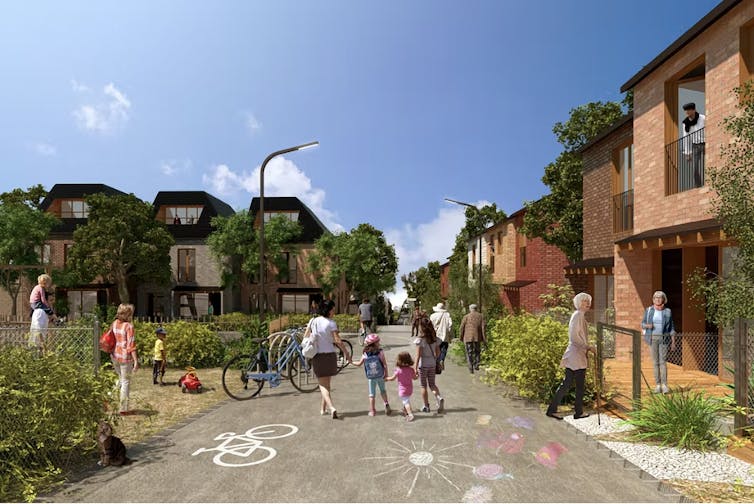
Our ageing cities are badly in need of regeneration. Many established residential areas, the “greyfields”, are becoming physically, technologically and environmentally obsolete. They are typically located in low-density, car-dependent middle suburbs developed in the mid to late 20th century.
Compared to the outer suburbs, these middle suburbs are rich in services, amenities and jobs. But the greyfields also represent economically outdated, failing or undercapitalised real-estate assets. Their location has made them the focus of suburban backyard infill development.
Unfortunately, the current approach typically cuts down all the trees and creates more car traffic as resident numbers grow. A new kind of urban regeneration is needed at the scale of precincts, rather than lot by lot, to transform the greyfields into more liveable and sustainable suburbs. It calls for a collaborative approach by federal, state and local governments.
How Do We Do This?
Our free new e-book, Greening the Greyfields, sets out how to do this. It draws on ten years of research that led to a new model of urban development.
This approach integrates two goals of urban research:
ending the dependence on cars caused by a disconnect between land use and transport
accelerating the supply of more sustainable, medium-density, infill housing to replace the current dysfunctional model of urban regeneration.
Greening greyfields will help our cities make the transition to net zero emissions.
Why Do We Need To Regenerate These Areas?
We need to shrink the unsustainable urban and ecological footprints of “suburban” cities. Neighbourhoods need to become more resilient, sustainable, liveable and equitable for their residents.
Urban regeneration must also allow for the COVID-driven restructuring of the work–residence relationship for city residents. This involves relocalising urban places so they become more self-sufficient as “20-minute neighbourhoods”. Their residents will have access to most of the services they need via low-emission cycling and walking, as well as public transport.
Current attempts to increase residential density and limit sprawl in most Australian cities tend to focus on blanket upzoning in selected growth zones. The resulting backyard infill involves a few small homes, which is all that is allowed on each block. Density increases only marginally, so there are still too few housing options for residents who want to be close to city services and opportunities.
Piecemeal infill redevelopment often degrades the quality of our suburbs. The loss of trees and increase in hard surfaces worsen urban heat island effects and flood risk. And a lack of convenient transport options for the extra residents reinforces car dependence.
We need more strategic models of suburban regeneration.
Greyfield regeneration compared to conventional approaches

Why Do This At The Precinct Scale?
Urban regeneration is best tackled at the scale of precincts. They are the building blocks of cities: greenfield sites continue to be developed, and old brownfield industrial sites are redeveloped, at this scale.
Design-led precinct-scale regeneration can maximise co-ordination of aspects of urban living neglected by piecemeal lot-by-lot redevelopment. Think local health and education services, small shops, social housing, walkable open space, public transport and even regenerated biodiversity.
Model precincts like WGV, in a greyfields suburb of Fremantle, have very successfully demonstrated how regeneration can produce high-quality, medium-density housing and net-zero outcomes. However, this development was on an old school site, so there was no need to combine individual blocks into a precinct-scale site. There were also no residents that needed to be engaged – though WGV became very popular because of its attractive architecture and treed green spaces.

What Are The Key Elements Of This Model?
Greyfield precinct regeneration has two sub-models: place-activated and transit-activated. A place-activated precinct may shorten travel distances for residents by providing services and amenities, but does not in itself increase public transport. For transit-activated precincts, good public transport increases land values, which makes these regenerated greyfields even more attractive.
Mid-tier transit like trackless trams is an ideal way to enable precinct developments along main road corridors. Local governments are recognising this around Australia.
Greyfield regeneration can begin with a strategy of district greenlining. Redlining was an American planning tool to exclude people of colour from a neighbourhood. Greenlining is the opposite: it includes the whole community in greening their neighbourhood.
This strategic process would identify neighbourhoods in need of next-generation infrastructure. Projects of this sort require a precinct-scale vision and plan.
State and municipal agencies can do this work. It would include:
physical infrastructure – energy, water, waste and transport
social infrastructure – health and education
green infrastructure – the nature-based services we get from planting and retaining trees and enabling open space and landscaped streets.
The City of Maroondah in Victoria provided an early demonstration of how this can happen. It produced a set of playbooks to show how other municipalities, developers and land owners can replicate the process.
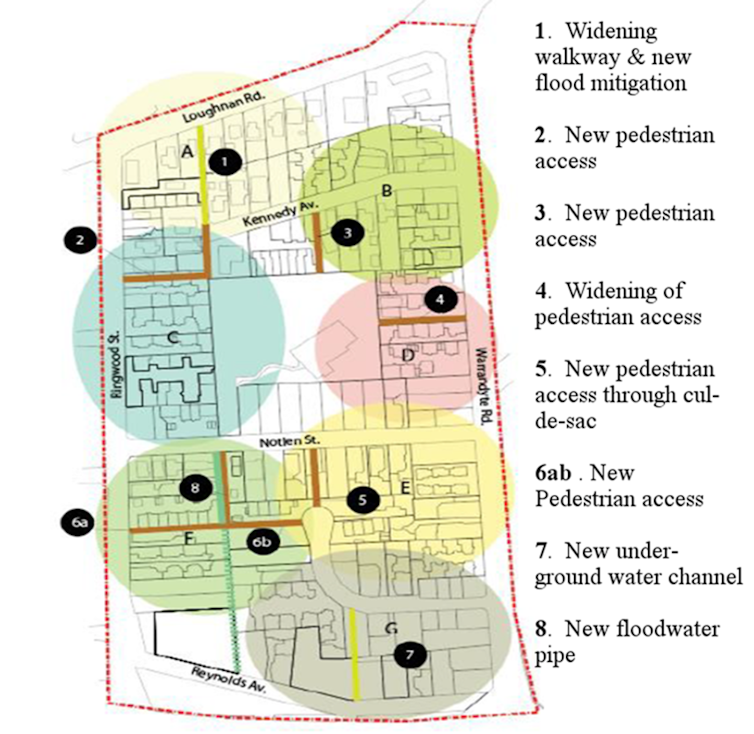
Greening the greyfields will deliver the many benefits associated with more sustainable and liveable communities. However, these outcomes depend on more comprehensive, design-led, integrated land use and transport planning.
Property owners, councils, developers and financiers will have to work together much more closely and effectively than happens with the business-as-usual approach of fragmented, small-lot infill, which is failing dismally. New laws and regulations will be needed to change this approach.
Better Cities 2.0?
Precinct-based projects offer a model for net zero development of our cities.
Greyfield regeneration is an increasingly pervasive and pressing challenge for our cities. It calls for all levels of government to work on a strategic response.
We suggest a Better Cities 2.0 program, led by the federal government, to establish greyfield precinct regeneration authorities in major cities and build partnerships with all major urban stakeholders. It would set us on the path to greening the greyfields.![]()
Peter Newman, Professor of Sustainability, Curtin University; Giles Thomson, Senior Lecturer, Department of Strategic Sustainable Development, Blekinge Institute of Technology; Peter Newton, Emeritus Professor in Sustainable Urbanism, Centre for Urban Transitions, Swinburne University of Technology, and Stephen Glackin, Senior Research Fellow, Centre for Urban Transitions, Swinburne University of Technology
This article is republished from The Conversation under a Creative Commons license. Read the original article.
Protecting 30% of Australia’s land and sea by 2030 sounds great – but it’s not what it seems
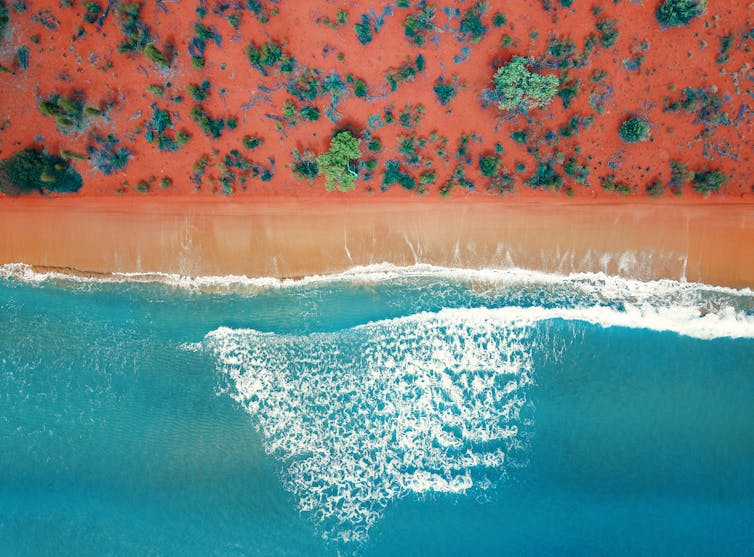
You would have heard Australia’s environment isn’t doing well. A grim story of “crisis and decline” was how Environment Minister Tanya Plibersek described the situation when she launched the State of the Environment Report last week. Climate change, habitat destruction, ocean acidification, extinction, and soil, river and coastal health have all worsened.
In response, Plibersek promised to protect 30% of Australia’s land and waters by 2030. Australia committed to this under the previous government last year, joining 100 other countries that have signed onto this “30 by 30” target.
While this may be a worthy commitment, it’s not a big leap. Indeed, we’ve already gone well past the ocean goal, with 45% protected. And, at present, around 22% of Australia’s land mass is protected in our national reserve system.
To get protected lands up to 30% through the current approach will mean relying on reserves created by non-government organisations and Indigenous people, rather than more public reserves like national parks. This approach will not be sufficient by itself.
The problem is, biodiversity loss and environmental decline in Australia have continued – and accelerated – even as our protected areas have grown significantly in recent decades. After years of underfunding, our protected areas urgently need proper resourcing. Without that, protected area targets don’t mean much on the ground.
What Counts As A Protected Area?
In 1996, the federal government set up the National Reserve System to coordinate our network of protected areas. The goal was to protect a comprehensive, adequate and representative sample of Australia’s rich biodiversity.
Since then, marine reserves have expanded the most, with the government protecting Commonwealth waters such as around Cocos Islands and Christmas Island.
On land, the government has been very hands-off. Progress has been driven by non-government organisations, Indigenous communities and individuals. New types of protected area, offering different levels of protection, have emerged. The Australian Wildlife Conservancy now protects or manages almost 13 million hectares – about twice the size of Tasmania. Bush Heritage Australia protects more than 11 million hectares. While these organisations do not always own the land, they have become influential players in conservation.
Partnerships between Traditional Owners and the federal government have produced 81 Indigenous Protected Areas, mainly on native title land. These cover 85 million hectares – fully 50% of our entire protected land estate. Independent ranger groups are also managing Country outside the Indigenous Protected Area system.
Protected areas have also grown through covenants on private land titles, aided by groups such as Trust for Nature (Victoria) and the Tasmanian Land Conservancy.
In total, public protected areas like national parks have only contributed to around 5% of the expansion of terrestrial protected area since 1996. Non-governmental organisation land purchases, Indigenous Protected Areas and individual private landholders have facilitated 95% of this growth.
The Real Challenge For Protected Areas? Management
So how did non-government organisations become such large players? After the national reserve system was set up, the federal government provided money for NGOs to buy land for conservation, if they could secure some private funding. Protected lands expanded rapidly before the scheme ended in 2012.
Unfortunately, federal funding did not cover the cost of managing these new protected areas. Support for Traditional Owners to manage Indigenous Protected Areas has continued, albeit on erratic short-term cycles and very minimally, to the tune of a few cents per hectare per year.
As a result, NGOs and Traditional Owners have increasingly had to rely on market approaches and philanthropy. Between 2015 and 2020, for example, the Traditional Owner non-profit carbon business Arnhem Land Fire Abatement Limited earned $31 million in the carbon credit market through emissions reductions. This money supports a significant portion of the conservation efforts of member groups.
What does this mean? In short, corporate partnerships and market-based approaches once seen as incompatible with conservation are now a necessity to address the long-term shortfall of government support.
You might think wider investment in conservation is great. But there are risks in relying on NGOs funded by corporations and philanthropists to conserve Australia’s wildlife.
For instance, NGOs may no longer feel able to push for transformative political change in conservation if this doesn’t align with donor interests. There’s also lack of transparent process in how conservation funding is allocated, and for what purpose.
Protection On Paper Isn’t Protection On The Ground
On paper, conservation in Australia looks in good shape. But even as protected areas of land and sea have grown, the health of our environment has plunged. The 2021 State of the Environment Report is a sobering reminder that it’s not enough simply to expand protected areas. It’s what happens next that matters.
If we value these protected lands, we have to fund their management. Without management – which costs money – protected areas can rapidly decline, especially under the impacts of climate change.
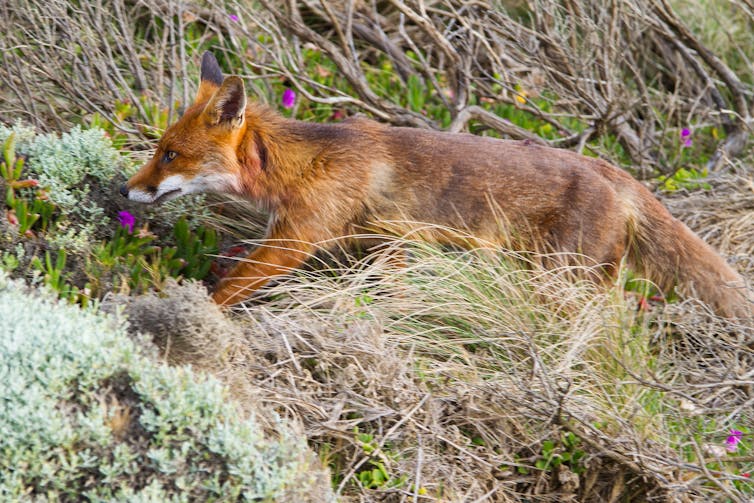
We also have to tackle what happens outside protected areas. We can’t simply keep sectioning off more and more poorly funded areas for nature while ignoring the drivers of biodiversity loss, such as land clearing, resource extraction, mismanagement and the dispossession of Indigenous lands.
It’s excellent our new environment minister wants to begin the environmental repair job. But creating protected areas is just the start. Now we have to answer the bigger questions: how we care for ecologies, whose knowledge is valued, who does this work and how will it be funded over the long term.
We also have to go beyond lip service to Indigenous knowledge and Caring for Country to genuinely acknowledge First Nations sovereignty and support self-determination.
On this front, moves by conservation organisations to return land to First Nations suggests a willingness in the conservation community to begin this work.
While our protected area estate is large and set to grow further towards the 30 by 30 goal, lines on a map do not equate to protection. We have long known the funding and capability for actual protection is woefully inadequate. For us to reverse our ongoing environmental collapse, that has to change. ![]()
Benjamin Cooke, Senior lecturer, RMIT University; Aidan Davison, Associate Professor, University of Tasmania; Jamie Kirkpatrick, Professor of Geography and Environmental Studies, University of Tasmania, and Lilian Pearce, Lecturer, Environmental Humanities, Centre for the Study of the Inland, La Trobe University
This article is republished from The Conversation under a Creative Commons license. Read the original article.
Not waving, drowning: why keeping warming under 1.5℃ is a life-or-death matter for tidal marshes
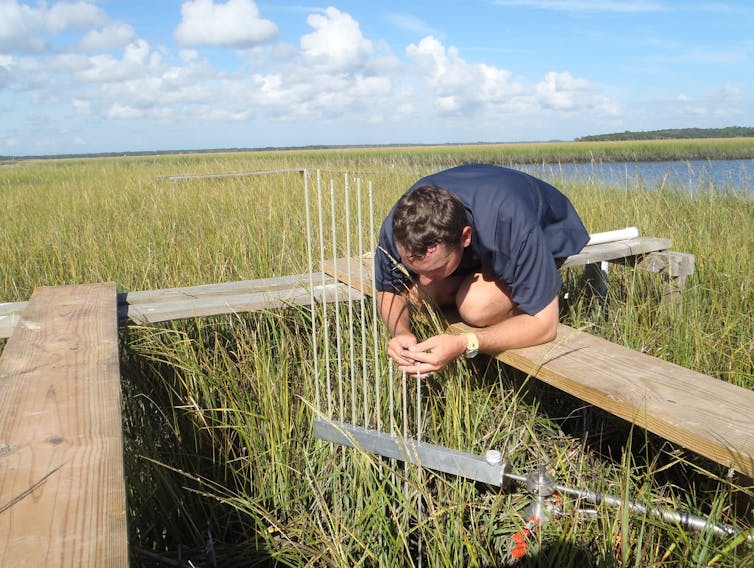
It may not always be clear why global temperature rise must be kept below 1.5℃, compared to 2℃ or 3℃. Research published today in the journal Science shows this apparently small distinction will make all the difference for the world’s tidal marshes.
Tidal marshes fringe most of the world’s coastlines. These coastal wetlands are flooded and drained by salt water brought by tides. They provide valuable habitat for animals, support fisheries that feed millions of people and take carbon dioxide from the atmosphere, storing it in their roots.
New roots build up the marsh soil, while stems trap sediment. Both processes help tidal marshes keep pace with sea-level rise. Indeed, tidal marshes increase the amount of carbon they store as the rate of sea-level rise increases.
This feedback has led scientists to question whether tidal marshes might survive future sea-level rise. Unfortunately, our research shows that’s unlikely if warming exceeds 1.5℃.
A 20-Year Experiment Provides The Answer
I am part of an international team of scientists who embarked on an experiment nearly 20 years ago to test whether tidal marshes were keeping pace with sea-level rise. Nearly 500 devices called “surface elevation tables” were installed in tidal marshes in countries including Australia, the United States, Canada, Belgium, Italy, the United Kingdom and South Africa.
These devices measured the amount of sediment and root material accumulating in the marshes. They also measured changes in the marsh’s surface elevation. Nearby tide gauges measured the rate of sea-level rise. This rate varied across the network.
Some coastlines such as Australia’s have a stable land mass – so the rate of sea-level rise reflects the rise in ocean volume driven by global warming.
On other coastlines, including much of North America, the land may still be sinking or rising after the removal of massive ice sheets at the end of the last ice age. What’s more, extracting oil and water resources from underground can cause local subsidence, increasing “relative” sea-level rise.
The data we gathered provide insights into what might happen to tidal marshes as sea-level rise accelerates.
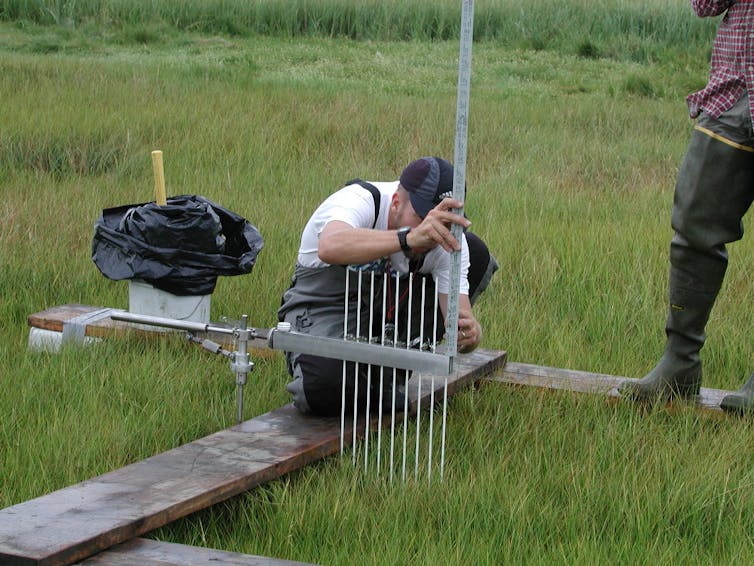
What Do The Findings Tell Us?
One set of findings was encouraging. These data showed the rate at which material accumulates in tidal marshes around the world corresponds closely to the varying rates of sea-level rise.
Even the marshes experiencing sea-level rise of 7-10mm per year – the rate anticipated globally under high-emissions scenarios – were accumulating sediment and organic matter at a comparable rate.
However, measuring changes in elevation produced a very different picture. Even though marshes under higher rates of sea-level rise were accumulating more sediment, this did not translate into more elevation gain.
The new research suggests a simple explanation for this.
The additional sediment and water accumulating on the surface weigh the marsh down, compressing the sediment below. This is particularly apparent in marshes with high organic content: precisely the type that develops under high rates of sea-level rise.
This insight accords with observations emerging from the paleo record, which also suggest tidal marshes are highly vulnerable to rapidly rising sea levels.
A Story Of Good News And Bad
To protect our tidal marshes, we must try to reduce global carbon emissions that cause global warming and sea-level rise.
Sea level rise has averaged about 3.7mm per year since 2006. Our research shows tidal marshes are capable of keeping up with this on most of the world’s coastlines.
But global sea-level rise is set to increase. Modelling by the Intergovernmental Panel on Climate Change projects it will reach 7mm per year if warming reaches between 2℃ and 3℃.
Current global commitments put Earth on a trajectory for this level of warming. And once we reach tipping points for sea-level rise, they are locked in for centuries, regardless of subsequent cuts in emissions.
The best hope for preserving the world’s existing tidal marshes is to meet the Paris Agreement goal of limiting global warming below 2℃ – and if possible 1.5℃.
But we should even now be considering how we might allow for these important ecosystems to shift landwards. This has been their natural adaptation to episodes of high sea-level rise in the past. Countries with large expanses of undeveloped coastal floodplain, such as Australia, are well placed to provide areas to preserve shifting tidal marshes in a warmer future.![]()
Neil Saintilan, Professor, School of Natural Sciences, Macquarie University
This article is republished from The Conversation under a Creative Commons license. Read the original article.
4 lessons for the Albanese government in making its climate targets law. We can’t afford to get this wrong
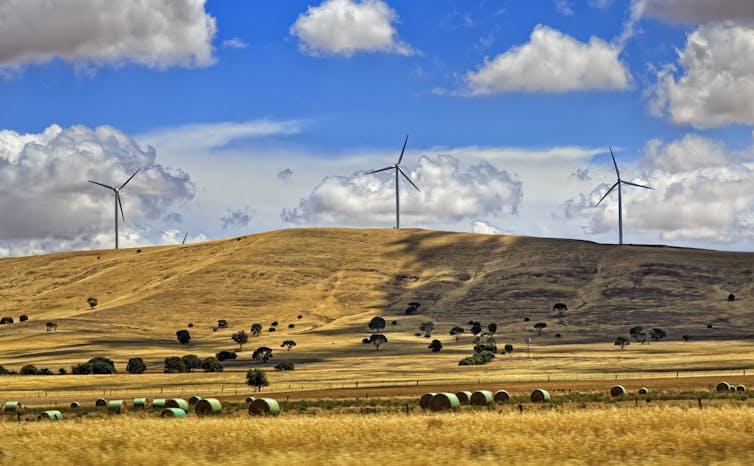
As the new parliament sits for the first time this week, one issue will be in sharpest focus: enshrining a climate target into law. The Albanese government’s pre-election promise was to cut Australia’s emissions 43% on 2005 levels, by 2030.
The government’s commitment to legislate climate targets is welcome and long overdue. Many nations now have climate laws in place to help ensure timely and sufficient emissions reductions.
But not all laws are equal. Our new research explored the impact of Victoria’s Climate Change Act 2017, and similar laws in the United Kingdom and many European countries.
The Albanese government should be guided by lessons from the design and implementation of existing laws such as these, to ensure it follows best practice. Failing to learn from experiences in other jurisdictions would be a missed opportunity Australia – and our warming planet – can hardly afford.
Holding Governments To Account
Labor’s forthcoming legislation is an example of “framework climate legislation”.
Typically, framework climate laws do three things:
- they establish a long-term net zero emissions target
- they require governments to set targets at regular intervals along the pathway to net zero
- they include obligations to develop regulatory and policy measures to meet targets.
These laws rarely include direct emissions reduction measures, such as emission trading, taxation or emissions standards for high emitters like power plants. Instead they establish a cycle of policy development and implementation, providing governments with flexibility to respond to rapidly evolving climate policy, science and technology.
The backbone of laws like these are provisions to hold the government to account. Governments are legally required to set out robust and credible measures to achieve their targets, and to report publicly on their progress.
In many jurisdictions, independent expert bodies advise governments and monitor progress.
Framework climate laws are an important piece of the climate policy puzzle. Long-term policy goals, such as net-zero emissions by 2050, can be easily discounted in the face of competing short-term pressures, such as pandemic recovery. Framework laws are designed to keep governments on track.
Under framework laws in Ireland and the UK, courts have quashed government policies that aren’t specific enough or realistic about how to achieve emissions reduction targets.
This requires governments to commit to more robust, ambitious action.
Labor’s Climate Bill
A draft of the government’s proposed legislation has been shared with the crossbench and leaked to Nine newspapers, but at this point it hasn’t been made public.
We can expect the bill to include Labor’s 2030 emissions reduction target, and a role for the reinstated Climate Change Authority to advise government on future targets.
Newly elected Independents and environment NGOs have highlighted some important concerns with the proposed legislation.
They emphasise the need to ensure that Australia’s targets can be increased over time in line with best available science, and to equip the Climate Change Authority with sufficient resourcing and expertise. These are important features and a failure to address them in the legislation would be disappointing.
Our empirical research on the Victorian Climate Change Act and comparisons with other framework laws highlight four critical lessons for strong, effective climate legislation.
1. Embedding Best Available Science In Targets
Long-term targets should be consistent with Paris Agreement goals and best available science, such as the latest Intergovernmental Panel on Climate Change reports.
Many framework laws, including the Victorian Act, set a long-term target of net zero emissions by 2050. Yet, science is increasingly telling us the world must reach net zero emissions well before 2050, in order to keep Paris Agreement goal of limiting global warming to 1.5℃ above pre-industrial levels this century in reach.
The impacts of global warming will be considerably more severe if we exceed this 1.5℃ threshold.
Instead of a blanket reliance on “net zero by 2050”, framework laws should legislate long term targets referencing the ambitious 1.5℃ Paris Agreement goal, and explicitly allow for any necessary revisions of targets to reflect the science.
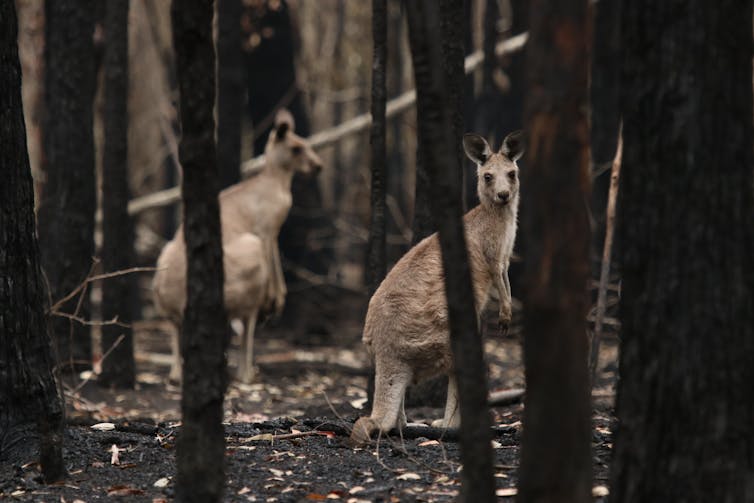
2. Requirements For Setting Interim Targets
Clear, detailed requirements for setting interim targets help maximise the benefits of acting sooner rather than later.
Interim targets set under the Victorian Act aim to reduce emissions 28-33% on 2005 levels by 2025, and 45-50% by 2030. Yet these targets have been criticised for deferring significant emissions reductions to later.
Legislation should require governments to prioritise consistency with the best available science. It should require that interim targets are designed to achieve the long-term net zero target in an efficient, effective, equitable manner.
All targets – interim and long-term – must increase in ambition over time. The legislation should prohibit “backsliding” – targets which lower ambition.
This is built into Victoria’s Act and in the Paris Agreement itself.
3. Robust And Enforceable Government Obligations
Framework climate laws should include clearly defined and strategically allocated legal duties for government ministers and agencies. This includes duties to set and achieve long-term and interim targets and to develop policies and actions which will deliver on targets.
And they should be enforceable via the courts as in Ireland and the UK.
4. Transparency Is Vital
Independent expert oversight and public participation are vital for transparency. Regular progress reporting can help drive ambitious implementation and hold governments accountable, but this also depends on public and political scrutiny.
The Victorian Act falls short here by not effectively providing for the participation of independent experts and the public.
What works well in other jurisdictions, such as the UK, is a permanent independent climate commission.
This commission has an ongoing role advising government on target setting and mitigation policy, monitoring progress and facilitating stakeholder engagement and public debate. Proper resourcing is needed to make this work.
A Way Forward
After years of dangerous inaction, Australia desperately needs a framework climate law at the national scale – as well as a raft of ambitious direct measures to rapidly reduce emissions.
But this law needs to do more than just legislate targets and reinstate the Climate Change Authority.
Learning from experience in Victoria and other jurisdictions with similar laws is critical to getting the framework right.![]()
Anita Foerster, Associate professor, Monash University; Alice Bleby, PhD Candidate, UNSW Sydney, and Anne Kallies, Senior Lecturer, RMIT University
This article is republished from The Conversation under a Creative Commons license. Read the original article.
Climate change killed 40 million Australian mangroves in 2015. Here’s why they’ll probably never grow back

Environmental scientists see flora, fauna and phenomena the rest of us rarely do. In this series, we’ve invited them to share their unique photos from the field.
In the summer of 2015-2016, some 40 million mangroves shrivelled up and died across the wild Gulf of Carpentaria in northern Australia, after extremely dry weather from a severe El Niño event saw coastal water plunge 40 centimetres.
The low water level lasted about six months, and the mangroves died of thirst. Seven years later, they have yet to recover. My new research, published today, is the first to realise the full scale of this catastrophe, and understand why it occurred.
This event, I discovered, is the world’s worst incidence of climate-related mangrove tree deaths in recorded history. Over 76 square kilometres of mangroves were killed, releasing nearly one million tonnes of carbon into the atmosphere.
But this event, while unprecedented in scale, is not unique. My research also discovered evidence of another mass die-back of mangroves in the region in 1982 – the same year the Great Barrier Reef suffered its first mass bleaching event.
The mangroves took 15 years to recover. This time, we won’t be so lucky.
Mangroves Are Immensely Important
In Samoa, El Niño-driven sea level drops are called “Taimasa” because of the putrid smell of decaying marine life from long-exposed corals, when sea levels remained low for months on end.
In northern Australia, Taimasa conditions in 2015 left mangroves at higher elevations exposed for at least six months. Without regular flushing and wetting of tides, shoreline mangroves don’t stand a chance.
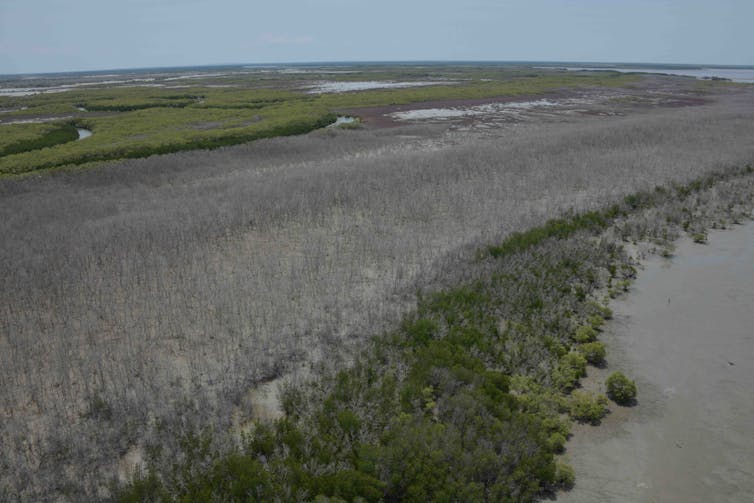
Mangroves are enormously valuable coastal ecosystems. Healthy mangrove ecosystems not only buffer shorelines against rising sea levels, but they also provide valuable protection against erosion, abundant carbon sinks, shelter for animals, nursery habitat, and food for marine life.
These benefits have cultural and economic value, with widespread significance to local communities.
The mass die-back event of 2015 was widely reported in national and international news, with shocking images emerging from the remote region.
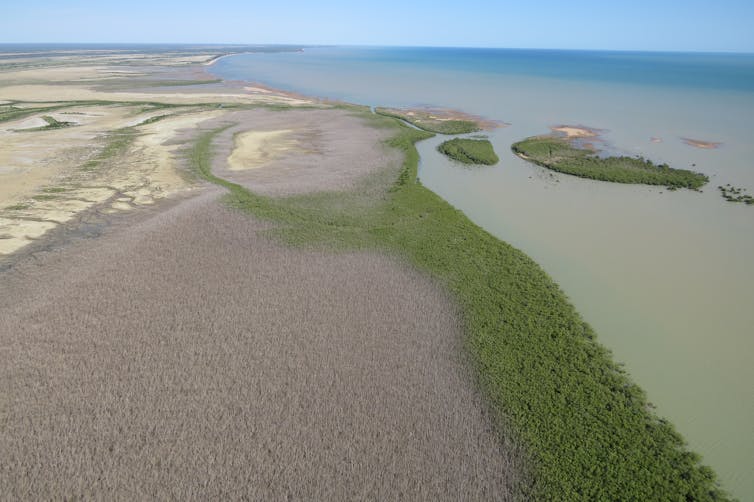
Although the cause was unknown at the time, the implications of such catastrophic damage were immense for local and regional communities, natural coastal ecosystems and the fisheries that depend on them.
Access was difficult and expensive, and environmental records for the region were scarce. But after four years of research , we uncovered evidence this event was indeed a dramatic consequence of climate change.
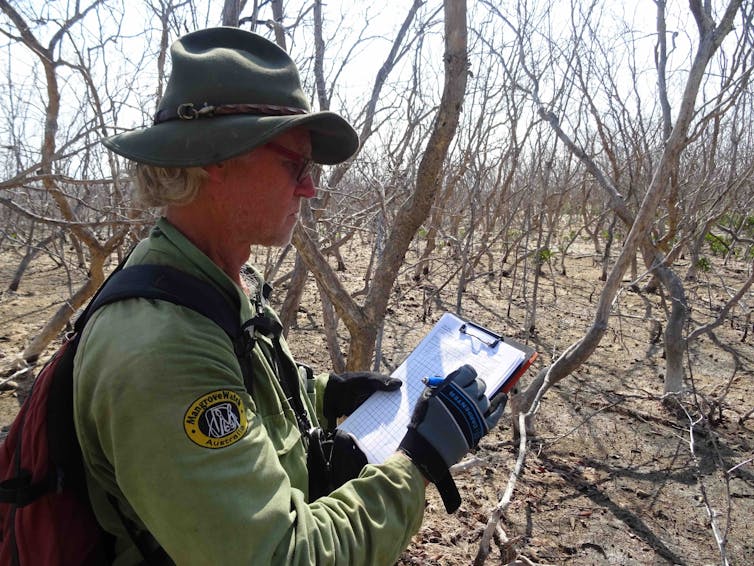
Why The Mangroves Probably Won’t Recover This Time
Our research reveals the presence of a previously unrecognised “collapse-recovery cycle” of mangroves along Gulf shorelines. The mangroves, damaged in 1982, are now attempting to recover again after the mass-death event in 2015.
But, at least three factors have changed since 1982, leaving recovery less likely.
For one, sea levels have risen dramatically due to climate change, causing erosion. This places escalating pressure on tide-fed wetlands to retreat towards higher land.
Younger trees are essential for future mangrove habitat. But upland, environmental conditions for newly established seedlings can be deadly. Landward pressures of bushfires, feral pigs and weed infestations are made far worse by the catastrophic sudden drops in sea level associated with severe El Niño events.
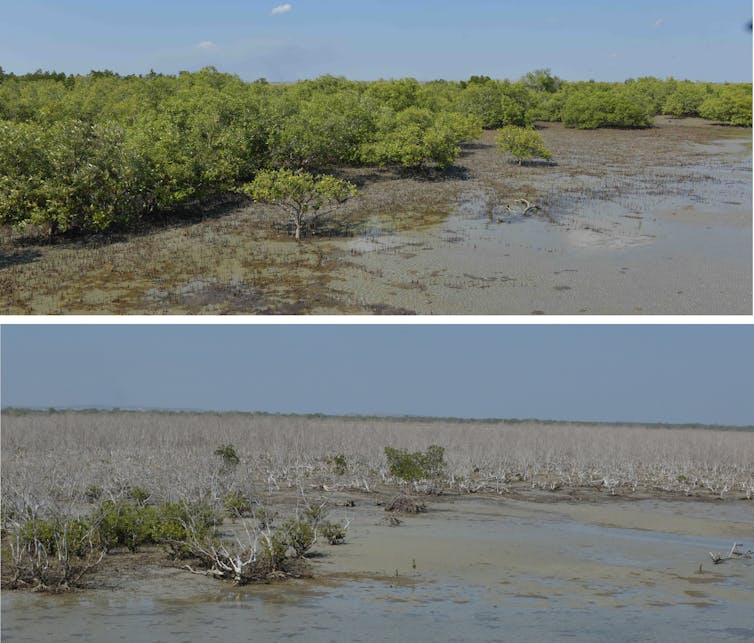
Two, localised storms, such as tropical cyclones, have become increasingly severe. At least two particularly severe cyclones struck the Gulf of Carpentaria coast: Owen in 2018, and Trevor in 2019. A severe flood event also hit the region in 2019.
The cyclone impacts were notable and extreme. Piles of dead mangrove timber were swept up and driven across tidal areas, bulldozing any newly established trees, as well as sprouting survivors.

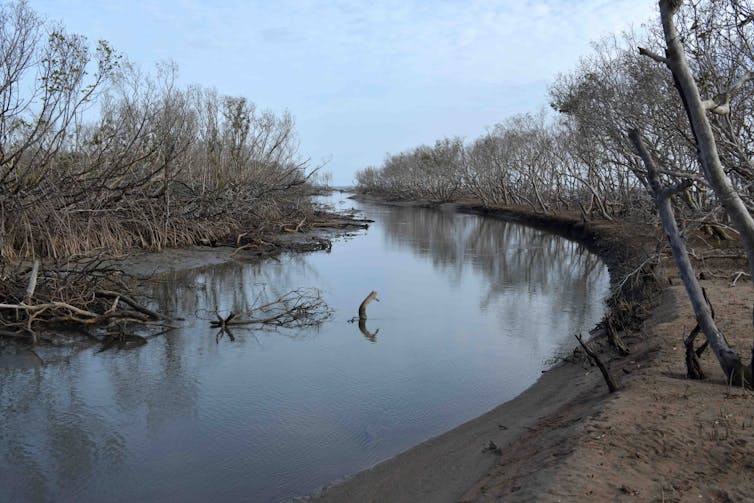
And three, the threat of future Taimasa low sea level events appear imminent, as evidence points to a link between climate change and severe El Niño and La Niña events. Indeed, El Niños and La Niñas have become more deadly over the last 50 years, and the long-term damage they inflict are expected to escalate.
Under these circumstances, the potential for the mangroves to recover are understandably low.
Protecting These Vital Ecosystems
These new findings make us more aware of the vulnerability of shoreline ecosystems, and the benefits we’re losing.
A $30 million fishing industry relies on these mangroves, including for redleg banana prawns, mudcrabs and fin fish. When the El Niño of 2015-2016 struck, redleg banana prawn fishers reported their lowest-ever catches.
Mangroves also help stabilise shorelines by buffering otherwise exposed areas from erosion. Such shoreline protection is crucial as sea levels continue to rise rapidly, coupled with increasingly severe storm waves and winds.
Healthy living mangroves are among the world’s most carbon-rich forests, binding and holding considerable carbon reserves both in their woody structure and below ground in peaty sediments.
Losing mangroves in the Gulf released more than 850,000 tonnes of carbon into the atmosphere, across both mass dieback events. That’s similar to 1,000 jumbo jets flying return from Sydney to Paris.
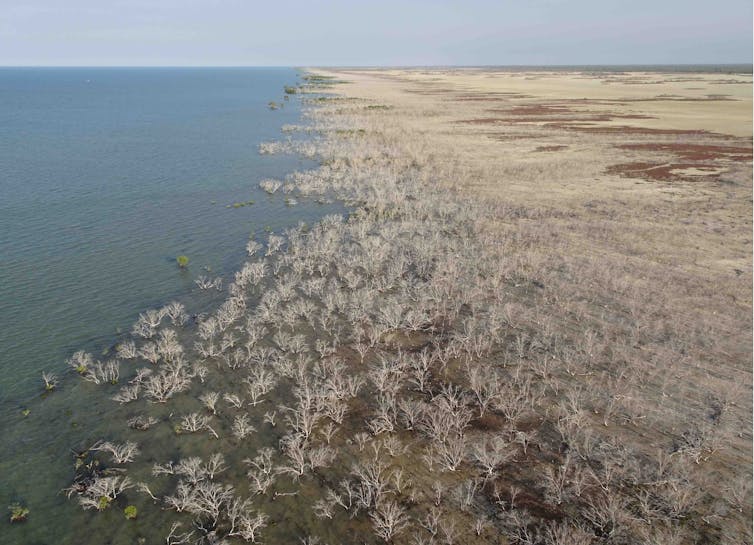
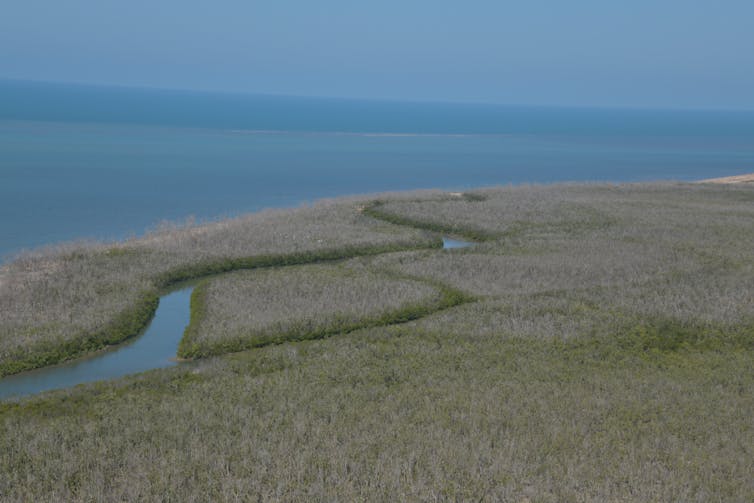
It’s critical these buried carbon reserves remain intact, but this will occur only if living vegetation on the surface remains healthy and protected.
Mangroves are also like the kidneys of the coast. Losing them will amplify pollutants in runoff, with excess nutrients, sediments and agricultural chemicals travelling unmitigated into the sea.
They Need Greater Monitoring
Tropical mangroves – as well as saltmarsh-saltpans, the other part of tidal wetlands – need much greater protection, and more effective maintenance with regular health checks from dedicated national shoreline monitoring.
Our aerial surveys of more than 10,000 kilometres of north Australian coastlines have made a start. We’ve recorded environmental conditions and drivers of shoreline change for north-western Australia, eastern Cape York Peninsula, Torres Strait islands and, of course, the Gulf of Carpentaria.
As the climate continues to change, it’s vital to keep a close eye on our changing shoreline wetlands and to ensure we’re better prepared next time another El Niño disaster strikes. ![]()
Norman Duke, Professor of Mangrove Ecology, James Cook University
This article is republished from The Conversation under a Creative Commons license. Read the original article.
Soil abounds with life – and supports all life above it. But Australian soils need urgent repair
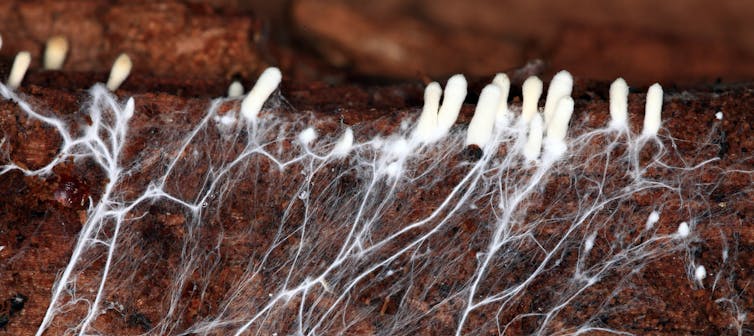
Under your feet lies the most biodiverse habitat on Earth. The soil on which we walk supports the majority of life on the planet. Without the life in it, it wouldn’t be soil. Unfortunately, Australia’s soils are not in good shape. The new State of the Environment report rates our soils as “poor” and “deteriorating”.
We’re all familiar with some soil dwellers, such as earthworms. But the lion’s share of life underneath is invisible to the naked eye. Microbiota like bacteria, nematodes, and fungi play vital roles in our environment. These tiny lifeforms break down dead leaves and organic matter, they cycle nutrients, carbon and water. Without them, ecosystems would collapse. Amazingly, most of this wealth of life is unknown to science.
Australia has not undergone the same glacial or volcanic activity as other parts of the world. That’s left most of our soil old and infertile. Our soils are highly sensitive to human pressures, such as contamination, acidification and loss of organic carbon. When we remove communities of plants, this leads to soil erosion. Land clearing also hits underground life hard, causing microbial diversity to decline.
Soil’s lifeforms are also under immense pressure from agriculture, as well as climate change and urban expansion. If we include livestock, more than half of Australia is now being used for farming. If we can improve farming methods, we can bring back soil biodiversity – and use it to produce healthy crops.
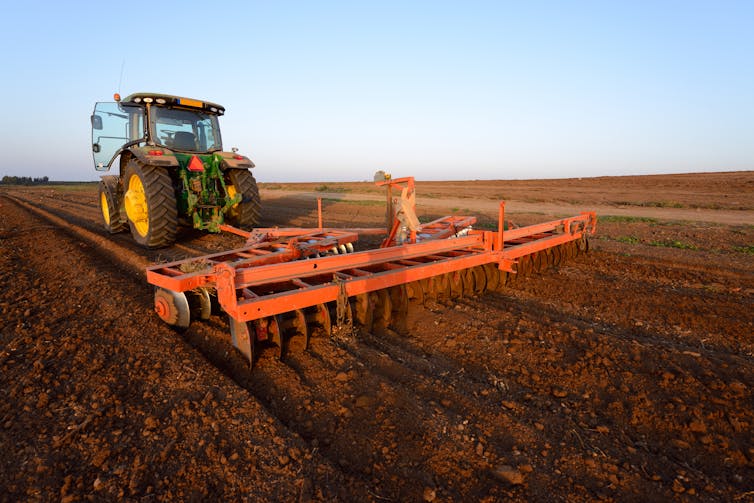
Why Does It Matter If We Lose Soil Microbial Diversity?
Australia has many different soil types. Images of each state’s iconic soil demonstrates how much they can differ. Importantly, soils differ greatly in their ability to support industrial crop production. Much of Australia is not naturally suited to this.
Some intensive farming methods like ploughing, irrigation and the use of fertilisers and pesticides are particularly damaging to the life in our soils. We know these practices reduce the abundance and diversity of a particularly important group of microorganisms, known as arbuscular mycorrhizal fungi. These fungi spread out into vast fungal networks below ground, and colonise the root systems of plants in a symbiotic relationship.
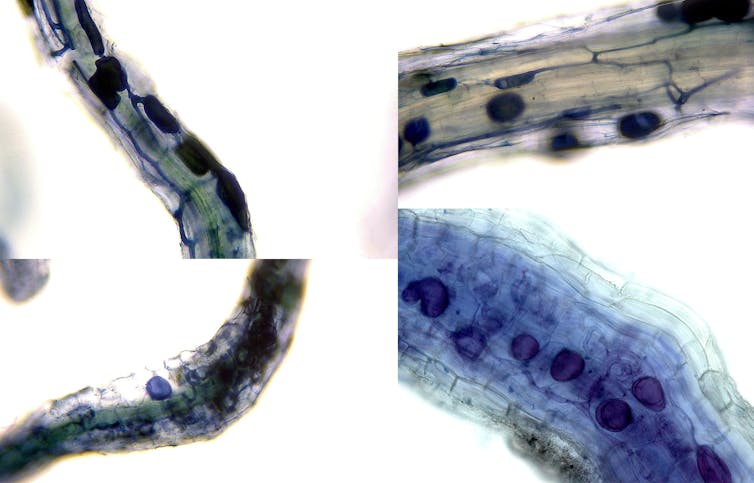
When you look at a field of corn or wheat, you might think all the action is above ground. But what happens in the soil is vital. The plants we rely on to survive rely in turn on strong relationships with these underground fungal networks.
Soil fungi can boost plant uptake of key resources like phosphorus and water and can even improve how plants resist pests. These fungi are also critical to the cycling of nutrients and carbon in our environment, and the networks they form give structure to soil. These relationships go back much further than humans do. Plants and fungi have been cooperating for hundreds of millions of years.
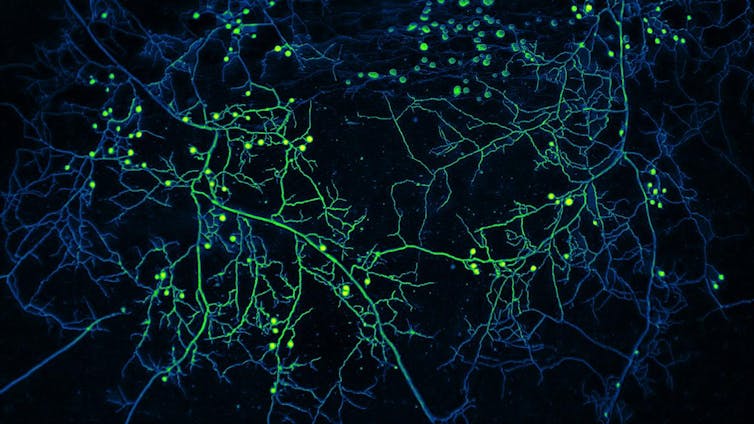
Despite breaking up this relationship in our agriculture, we have achieved ever-increasing yields.
That’s because most crop and pasture production relies on various fertilisers and pesticides for crop nutrition and pest control, rather than fungal networks or soil biology. The continued development of these fertilisers and pesticides have undoubtedly enhanced crop production and allowed millions of people to escape hunger and poverty.
The problem is, relying on pesticides and fertilisers is not sustainable. Many pesticides are under increasing restrictions or bans, and phosphorus fertiliser will only become more expensive as we deplete global phosphate reserves. Critically, their excessive use negatively impacts soil biology and the environment.
If we reduce the diversity of fungi in our soils, we lose the benefits they provide to healthy ecosystems – and to our crops. A soil with less biodiversity erodes more easily, loses its stored carbon quicker and causes disrupted nutrient cycles.
Can We Protect Our Soil Fungi?
Yes – if we change how we manage our soils. By working with our living soils rather than against them, we can meet increasing demand for food and keep farms economically viable.
As you might expect, organic and conservation farming is less damaging to soil fungi compared to conventional farming, due to their limited use of certain fertilisers and most pesticides.
These approaches also involve less ploughing or tilling of the soil, which lets fungal networks remain intact and so benefitting soil structure. This can promote plant protection from pests, and this soil biodiversity also keeps disease-causing microbes in check.
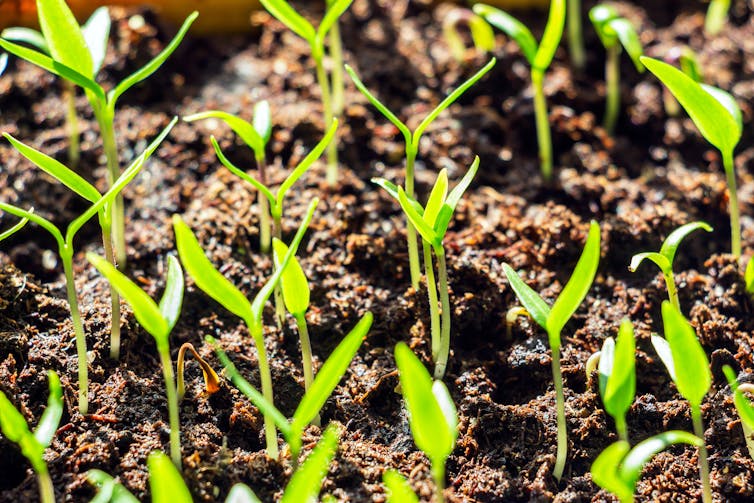
Clearly, changes to our agriculture can’t happen overnight. Sri Lanka’s sudden ban on synthetic fertilisers and pesticides in 2021 caused chaos in their farming sector and continues to threaten their food security. Widespread adoption of more sustainable farming techniques in Australia must be done gradually, with support and incentives from industry and government. But it will have to happen. The status quo can’t last, as our soils continue to deteriorate and fertilisers and pesticides become more expensive and unavailable.
To Care For Our Soils, We Need To Know More About Them
While we know the life permeating our soils is in trouble, we need to know more. One important finding from the State of the Environment report was the need for more data on the biology of our soil to aid sustainable land use.
Why? To date, most of our understanding of how farming impacts soil fungal diversity is based on overseas research. Despite the ecological importance of these microbiota and their potential to accelerate sustainable food production, we still don’t have a clear picture of what’s underneath our fields. For a start, we need to know what mycorrhizal fungi live where.
To overcome this challenge, we have launched Dig Up Dirt, a new nationwide research project designed to let us take stock of our beneficial soil fungi.
Farmers, land managers and citizen scientists can send us soil samples to allow us to map Australia’s networks of soil fungi. The data we collect will also be fed into the international efforts to map fungi globally.
This is a long-overdue step towards learning to work with soil fungi to benefit agriculture – while conserving the life below our feet.![]()
Adam Frew, Lecturer and ARC DECRA Fellow, University of Southern Queensland; Christina Birnbaum, Lecturer, University of Southern Queensland; Eleonora Egidi, Researcher, Western Sydney University, and Meike Katharina Heuck, PhD Candidate, University of Southern Queensland
This article is republished from The Conversation under a Creative Commons license. Read the original article.
Artificial light at night can change the behaviour of all animals, not just humans
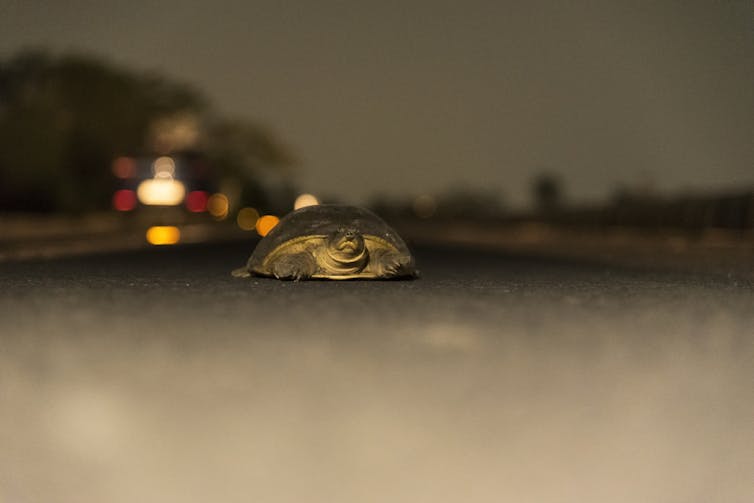
As the Moon rises on a warm evening in early summer, thousands of baby turtles emerge and begin their precarious journey towards the ocean, while millions of moths and fireflies take to the air to begin the complex process of finding a mate.
These nocturnal behaviours, and many others like it, evolved to take advantage of the darkness of night. Yet today, they are under a increasing threat from the presence of artificial lighting.
At its core, artificial light at night (such as from street lights) masks natural light cycles. Its presence blurs the transition from day to night and can dampen the natural cycle of the Moon. Increasingly, we are realising this has dramatic physiological and behavioural consequences, including altering hormones associated with day-night cycles of some species and their seasonal reproduction, and changing the timing of daily activities such as sleeping, foraging or mating.
The increasing intensity and spread of artificial light at night (estimates suggest 2-6% per year) makes it one of the fastest-growing global pollutants. Its presence has been linked to changes in the structure of animal communities and declines in biodiversity.
How Animals Are Affected By Artificial Lighting
Light at night can both attract and repel. Animals living alongside urban environments are often attracted to artificial lights. Turtles can turn away from the safety of the oceans and head inland, where they may be run over by a vehicle or drown in a swimming pool. Thousands of moths and other invertebrates become trapped and disoriented around urban lights until they drop to the ground or die without ever finding a mate. Female fireflies produce bioluminescent signals to attract a mate, but this light can’t compete with street lighting, so they too may fail to reproduce.
Each year it is estimated millions of birds are harmed or killed because they are trapped in the beams of bright urban lights. They are disoriented and slam into brightly lit structures, or are drawn away from their natural migration pathways into urban environments with limited resources and food, and more predators.
Other animals, such as bats and small mammals, shy away from lights or may avoid them altogether. This effectively reduces the habitats and resources available for them to live and reproduce. For these species, street lighting is a form of habitat destruction, where a light rather than a road (or perhaps both) cuts through the darkness required for their natural habitat. Unlike humans, who can return to their home and block out the lights, wildlife may have no option but to leave.
For some species, light at night does provide some benefits. Species that are typically only active during the day can extend their foraging time. Nocturnal spiders and geckos frequent areas around lights because they can feast on the multitude of insects they attract. However, while these species may gain on the surface, this doesn’t mean there are no hidden costs. Research with insects and spiders suggests exposure to light at night can affect immune function and health and alter their growth, development and number of offspring.
How Can We Fix This?
There are some real-world examples of effective mitigation strategies. In Florida, many urban beaches use amber-coloured lights (which are less attractive to turtles) and turn off street lights during the turtle nesting season. On Philip Island, Victoria, home to more than a million short-tailed shearwaters, many new street lights are also amber and are turned off along known migration pathways during the fledging period to reduce deaths.
In New York, the Tribute in Light (which consists of 88 vertical searchlights that can be seen nearly 100km away) is turned off for 20-minute periods to allow disoriented birds (and bats) to escape and to reduce the attraction of the structure to migrating animals.
In all cases, these strategies have reduced the ecological impact of night lighting and saved the lives of countless animals.
However, while these targeted measures are effective, they do not solve what might be yet another global biodiversity crisis. Many countries have outdoor lighting standards, and several independent guidelines have been written but these are not always enforceable and often open to interpretation.
As an individual there are things you can do to help, such as:
default to darkness: only light areas for a specific purpose
embrace technology: use sensors and dimmers to manage lighting frequency and intensity
location, location, location: keep lights close to the ground, shield at the rear, and direct light below the horizontal
respect the spectrum: choose low-intensity lights that limit the blue, violet and ultraviolet wavelengths. Wildlife is less sensitive to red, orange and amber light
all that glitters: choose non-reflective finishes for your home. This reduces the scattered light that contributes to sky glow.
In one sense, light pollution is relatively easy to fix – we can simply not turn on the lights and allow the night to be illuminated naturally by moonlight.
Logistically, this is mostly not feasible as lights are deployed for the benefit of humans who are often reluctant to give them up. However, while artificial light allows humans to exploit the night for work, leisure and play, in doing so we catastrophically change the environment for many other species.
In the absence of turning off the lights, there are other management approaches we can take to mitigate their impact. We can limit their number; reduce their intensity and the time they are on; and, potentially change their colour. Animal species differ in their sensitivity to different colours of light and research suggests some colours (ambers and reds) may be less harmful than the blue-rich white lights becoming commonplace around the world.![]()
Therésa Jones, Associate Professor in Evolution and Behaviour, The University of Melbourne and Kathryn McNamara, Post-doctoral research associate, The University of Melbourne
This article is republished from The Conversation under a Creative Commons license. Read the original article.
How likely would Britain’s 40°C heatwave have been without climate change?

Every heatwave occurring today is made more likely and intense by human-caused climate change. Early estimates by the UK Met Office suggest that days over 40°C have become ten times more likely to happen in the UK as a result of the rising global temperature.
But even this may be a significant underestimate, as models have underrated increases in the occurrence of extreme heat events before. And we know that climate change has increased the likelihood of new high-temperature records more than any other extreme weather phenomenon.
July 2022 would have had a few hot days without climate change. But with it, those days were several degrees hotter, which brought 40°C within reach for England for the first time.
Not-So-Great British Bake Off
The heatwave was caused by a low pressure system over the North Atlantic that produced a slingshot effect, firing a plume of hot, dry Saharan air northwards. With little moisture to evaporate and no clouds to block the sun’s rays, the land baked.
There is growing evidence to suggest that these hot weather-generating pressure systems are becoming more frequent for Europe. But even if they continued occurring at the same rate, the air itself is certainly getting hotter.
On a warming planet everywhere gets hotter, but not at the same rate. The land heats up faster than the ocean, especially the driest areas such as the Sahara. The approximately 1.2°C of global warming already experienced has added at least 2°C onto the average UK heatwave day, and even more on to night-time temperatures.
The UK is not prepared for these Mediterranean temperatures. Buildings are poorly insulated and lack air conditioning. Much of the infrastructure cannot cope: train lines are built from steel that is only stress-tested to 27°C. Beyond that, the lines are prone to buckling.
Extreme heat is a killer. Heatwaves in Europe in 2003 and in western Russia in 2010 killed around 70,000 and 55,000 people respectively – two of the deadliest weather disasters in history.
Extremely high temperatures are especially dangerous for the elderly, those with chronic medical conditions, people in cities and pets. That’s partly because it takes a heavy toll on the heart and lungs, especially when a warm night offers little respite. And partly because hot, stagnant air concentrates dangerous pollution like ozone, especially in cities.
Nearly 2,000 excess deaths have already been reported from the beginning of the mid-July heatwave in Spain and Portugal, which also experienced this Saharan plume of hot air. For every person killed, several more require hospital treatment for heat-related illness.
Heat On The Rise
An international team of attribution scientists has conducted several studies on recent heatwaves. The March-May 2022 heatwave in India and Pakistan, which destroyed much of the wheat harvest and is contributing, alongside the Ukraine conflict, to global food price rises, was made 30 times more likely by climate change. Canada’s extreme heat in June 2021 and Siberia’s high temperatures in the first half of 2020 each would have been virtually impossible without it.
The recent heatwave was relatively short, but it was also widespread across western Europe, and very intense. We are confident that climate change made it much more likely because the event stands out in bold against natural variation in the climate, which normally averages out to be unremarkable over such a wide area.
Though there aren’t yet estimates, we know that disruption to travel and the slowing down of work during the heatwave cost European economies dearly. Unprecedented water demand put a heavy strain on systems already running dry. A combination of extreme heat and dryness created exceptional conditions for wildfires to spread rapidly.
This released carbon held in vegetation, warming the planet further. The resulting smoke is also toxic. As the days and nights were several degrees hotter, the effect of climate change cost society on all of these fronts.
The amount by which previous temperature records were smashed is directly linked to the rate of greenhouse gas emissions. The faster carbon dioxide (CO₂) is dumped into the atmosphere, the faster the planet warms and the more regularly new records will be exceeded.
While this crisis plays out, the contest to replace Boris Johnson as Conservative Party leader and UK prime minister has barely covered climate change, and former contenders even pledged to scrap the country’s commitment to reach net zero by 2050.
This is the opposite of what is needed to prevent heatwaves becoming ever hotter and deadlier, which can only be achieved by urgently reducing long-lived greenhouse gas emissions such as CO₂ to zero. Economists widely favour action on climate change as a far cheaper alternative to enduring broken weather records year after year.

Don’t have time to read about climate change as much as you’d like?
Get a weekly roundup in your inbox instead. Every Wednesday, The Conversation’s environment editor writes Imagine, a short email that goes a little deeper into just one climate issue. Join the 10,000+ readers who’ve subscribed so far.![]()
Ben Clarke, DPhil Candidate in Environmental Research, University of Oxford; Friederike Otto, Associate Director, Environmental Change Institute, Imperial College London, and Luke Harrington, Senior Lecturer in Climate Change, University of Waikato
This article is republished from The Conversation under a Creative Commons license. Read the original article.
New research in Arnhem Land reveals why institutional fire management is inferior to cultural burning
David Bowman, University of Tasmania; Christopher I. Roos, Southern Methodist University, and Fay Johnston, University of TasmaniaOne of the conclusions of this week’s shocking State of the Environment report is that climate change is lengthening Australia’s bushfire seasons and raising the number of days with a fire danger rating of “very high” or above. In New South Wales, for example, the season now extends to almost eight months.
It has never been more important for institutional bushfire management programs to apply the principles and practices of Indigenous fire management, or “cultural burning”. As the report notes, cultural burning reduces the risk of bushfires, supports habitat and improves Indigenous wellbeing. And yet, the report finds:
with significant funding gaps, tenure impediments and policy barriers, Indigenous cultural burning remains underused – it is currently applied over less than 1% of the land area of Australia’s south‐eastern states and territory.
Our recent research in Scientific Reports specifically addressed the question: how do the environmental outcomes from cultural burning compare to mainstream bushfire management practices?
Using the stone country of the Arnhem Land Plateau as a case study, we reveal why institutional fire management is inferior to cultural burning.
The few remaining landscapes where Aboriginal people continue an unbroken tradition of caring for Country are of international importance. They should be nationally recognised, valued and resourced like other protected cultural and historical places.
Ancient Fire Management
The rugged terrain of the Arnhem Plateau in Northern Territory has an ancient human history, with archaeological evidence dated at 65,000 years.
Arnhem Land is an ideal place to explore the effects of different fire regimes because fire is such an essential feature of the natural and cultural environment.
Australia’s monsoon tropics are particularly fire prone given the sharply contrasting wet and dry seasons. The wet season sees prolific growth of grasses and other flammable plants, and dry season has reliable hot, dry, windy conditions.
Millennia of skilful fire management by Indigenous people in these landscapes have allowed plants and animals needing infrequently burnt habitat to thrive.
This involves shifting “mosaic” burning, where small areas are burned regularly to create a patchwork of habitats with different fire histories. This gives wildlife a diversity of resources and places to shelter in.
Conservation biologists suspect that the loss of such patchy fires since colonisation has contributed to the calamitous demise of wildlife species across northern Australia, such as northern quolls, northern brown bandicoots and grassland melomys.
Collapse Of The Cypress Pine
Our study was undertaken over 25 years, and wouldn’t have been possible without the generous support and close involvement of the Traditional Owners over this time.
It compared an area under near continuous Indigenous management by the Kune people of Western Arnhem Land with ecologically similar and unoccupied areas within Kakadu National Park.
We found populations of the cypress pine (Callitris intratropica) remained healthy under continual Aboriginal fire management. By contrast, cypress pine populations had collapsed in ecologically similar areas in Kakadu due to the loss of Indigenous fire management, as they have across much of northern Australia.
The population of dead and living pines is like a barcode that records fire regime change. The species is so long lived that older trees were well established before colonisation.
The timber is extremely durable and termite resistant, so a tree killed by fire remains in the landscape for many decades. And mature trees, but not juveniles, can tolerate low intensity fires, but intense fires kill both.
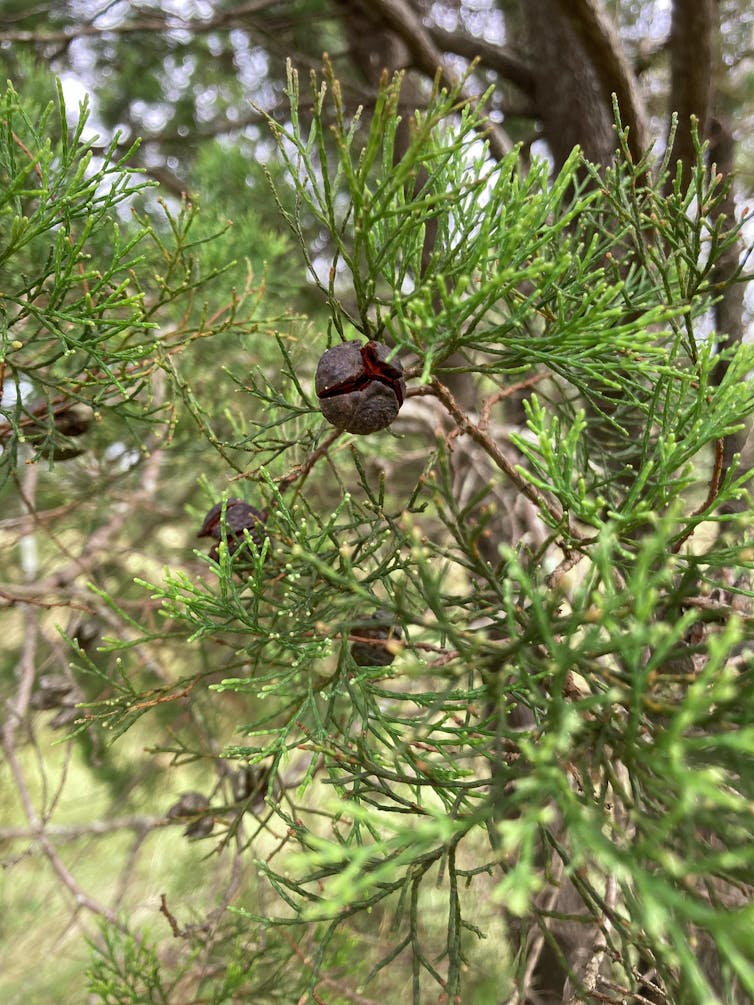
Since 2007, park rangers have attempted to emulate cultural burning outcomes. They’ve used aircraft to drop incendiaries to create a coarse patchwork of burned and unburned areas to improve biodiversity in the stone country within Kakadu.
Unfortunately, our research found Kakadu’s fire management interventions failed to restore landscapes to the healthier ecological condition under traditional Aboriginal fire management.
While the Kakadu aerial burning program increased the amount of unburnt vegetation, it didn’t reverse the population collapse of cypress pines. Searches of tens of kilometres failed to find a single seedling in Kakadu, whereas they were common in comparable areas under Aboriginal fire management.
Our study highlights that once the ecological benefits of cultural burning are lost, they cannot be simply restored with mainstream fire management approaches.
But that’s not to say the ecological impacts from the loss of Aboriginal fire management cannot be reversed. Rather, restoring fire regimes and ecosystem health will be slow, and require special care in where and how fires are set.
This requires teams on the ground with deep knowledge of the land, rather than simply spreading aerial incendiaries from helicopters.
There’s Much To Learn
There remains much for Western science to learn about traditional fire management.
Large-scale institutional fire management is based on concepts of efficiency and generality. It is controlled by bureaucracies, and achieved using machines and technologies.
Such an “industrial” approach cannot replace the placed-based knowledge, including close human relationships with Country, underpinning cultural burning.
Cultural burning and institutional fire management could be thought of as the differences between home cooking and fast food. Fast food is quick, cheap and produces the same product regardless of individual needs. Home cooking takes longer to prepare, can cater to individual needs, and can improve wellbeing.
But restoring sustainable fire regimes based on the wisdom and practices of Indigenous people cannot be achieved overnight. Reaping the benefits of cultural burning to landscapes where colonialism has disrupted ancient fire traditions take time, effort and resources.
It’s urgent remaining traditional fire practitioners are recognised for their invaluable knowledge and materially supported to continue caring for their Country. This includes:
- actively supporting Indigenous people to reside on their Country
- to pay them to undertake natural resource management including cultural burning
- creating pathways enabling Indigenous people separated from their country by colonialism to re-engage with fire management.
Restoring landscapes with sustainable cultural burning traditions is a long-term project that will involve training and relearning ancient practices. There are extraordinary opportunities for Indigenous and non-Indigenous people alike to learn how to Care for Country.
The authors gratefully acknowledge the contribution of Victor Steffensen, the Lead Fire Practitioner at the Firesticks Alliance Indigenous Corporation, who reviewed this article.![]()
David Bowman, Professor of Pyrogeography and Fire Science, University of Tasmania; Christopher I. Roos, Professor, Southern Methodist University, and Fay Johnston, Professor, Menzies Institute for Medical Research, University of Tasmania
This article is republished from The Conversation under a Creative Commons license. Read the original article.
I spent a year squeezing leaves to measure their water content. Here’s what I learned
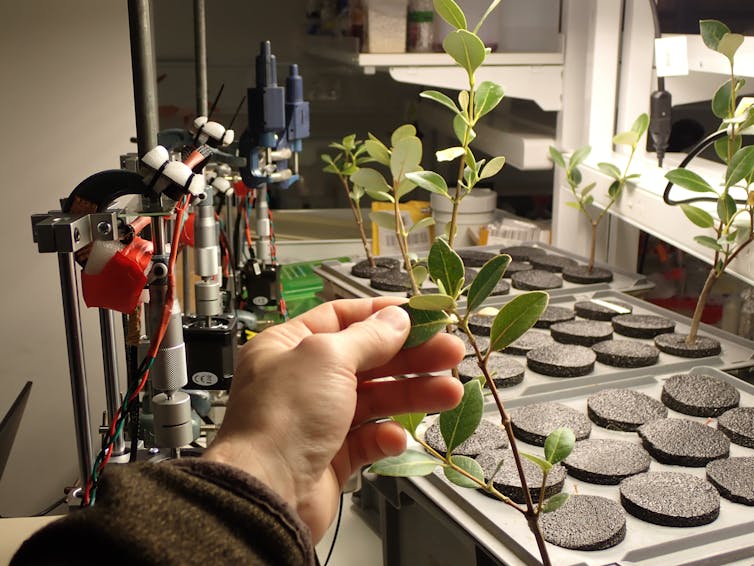
How do you tell if your plants need water? Recently, I asked this question of a group of about 40 biologists at the Australian National University.
Most of them said they would stick their fingers into the soil. If you want to be more scientific about it, most horticulturalists would argue it is best to weigh the pot to determine how much water it contains.
I took a different view. After building special tools to measure the “pulse” of plants, I am more inclined to feel the leaves.
Not only can touch provide a new way to follow the flow of water through plant cells, it may also deliver new possibilities for plant monitoring and care.
The Rhythm Of Plants
Plants have a natural rhythm, like a very slow heartbeat, caused by changing water pressure inside their cells.
Plants only beat around once a day, dehydrating during the day and rehydrating during the night. This process is too slow to watch for all but the most patient observers.
The pressure inside plant cells is called “turgor” and is usually between five and 20 atmospheres (up to 10 times the pressure inside a car tyre!). But while this pressure is large, plant cells are only a fraction of a millimetre in size.
For this reason, measuring turgor pressure has been traditionally been difficult and only done in lab settings. Put simply, we do not have a plug-and-play method to monitor the beating of plants.
Squeezing Leaves
Measuring plant water status is pretty important. On a global scale, more water flows through plants than through rivers, and a great part of this flux is regulated by changes in leaf turgor pressure.
Similarly, agriculture uses about 70% of all the water managed by humans, and many forests around the world are succumbing to drought. It is a key time to study the beating of plants. But where to start?
While doing my PhD studying water movement in plants, I was trying to find a simple way to measure turgor pressure and water content.
Although turgor is a property of single cells, I thought I could monitor a group of cells by carefully squeezing a leaf.
My ideas were simple. Leaves are thicker when they contain more water, so I could monitor the water content by measuring the thickness of the leaf, which I would do by squeezing it with a constant amount of force.
And to monitor the water pressure inside a leaf’s cells, I could measure the force exerted by the leaf when constrained to a given thickness.
As it turned out, these two ideas were not new – only new to me, and perhaps new to plant science. Materials scientists use tests like these all the time: a constant-force test is called a creep experiment, while a constant-thickness test is called a stress relaxation experiment.
How It Works
A year of tinkering and thinking about this problem allowed me to test my ideas in a very simple way. I bought a micrometer (a workshop tool used to measure distances very accurately), coupled it with a motor, a force sensor and some computer controls, and devoted myself to squeezing leaves.
Preliminary tests worked well, and then I couldn’t stop doing it!
Within the next six months, I had replaced the last chapter of my PhD with this serendipitous project. Colleagues and I successfully validated and published this simple method to monitor plant water status.
In the figure below, you can see the changes in the leaf thickness and turgidity of a grey mangrove (Aviennia marina) measured under changing light conditions.
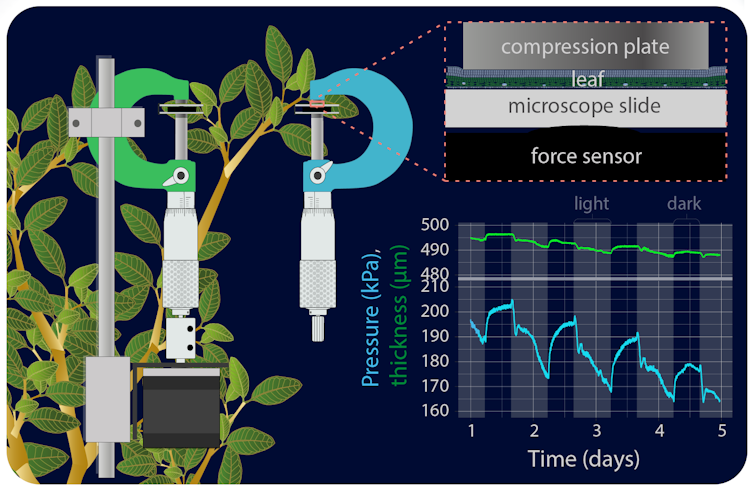
Touching Plants
Measuring the beating of plants is important, but this is not the only exciting aspect of this project.
More broadly, touch-based measurements could uncover a new wealth of information about plant life. This venture may help us understand climate, save water, and hopefully help us in addressing “plant blindness”.
Plants are very adaptable organisms. Much of their adaptability comes from the ability to modify their body plan to suit different conditions.
Being modular organisms made up of a collection of different cells, plants often modify the structure of cells and tissues, the strength of their walls, and the concentration of water-retaining compounds inside the cells. All of these properties, like turgor, are difficult to measure.
Touch provides scientists with a simple tool to study these mechanical properties of plant tissues.
A simple robotic system that could stay on a tree and continuously “feel” how the properties of its leaves (and stems, fruits and roots) change over time would have vast applications in research and industry.![]()
Tomás I. Fuenzalida, Postdoctoral Fellow, Research School of Biology, Australian National University
This article is republished from The Conversation under a Creative Commons license. Read the original article.
‘Building too close to the water. It’s ridiculous!’ Talk of buyouts after floods shows need to get serious about climate adaptation
Tayanah O'Donnell, Australian National UniversityAustralians are reeling from climate change impacts including more frequent and severe disasters – floods, droughts, searing heat and fires. These complex disasters are fuelling calls for managed retreats and debates about buying out at-risk properties.
Buyouts involve governments paying compensation or compulsorily acquiring land to manage a retreat from high-risk areas. Moving people and assets permanently out of harm’s way is considered a final step in a long line of options for climate adaptation.
It had often been thought of as something for future generations to grapple with, but my global review of the research literature shows a surge in studies of this issue in the past five years. Retreat is something we have to grapple with now.
Some parts of New South Wales have been flooded four times in 18 months. Retreat and relocation from properties in high-risk areas must now be central to climate adaptation. My research provides lessons for Australia from around the world in how to manage this difficult task.
History Repeats
At the height of the Western Sydney floods in March 2021, I wrote about the complexities of managed retreat. The same area has just had yet more catastrophic floods.
And in Lismore, NSW, which has repeatedly flooded over the years, the record floods of 2022 have brought such questions to a head.
Coastal areas are also at risk from sea-level rise. Here, too, we are hearing calls for retreat and buy-outs of vulnerable properties.
Managed retreat is far from simple. It requires us to assess complex, systemic risks. However, we now face pressing questions about vulnerability, insurability and rising insurance costs, and trade-offs involving value judgments about what to protect, when and at what cost.
My recent review, published by the Royal Society, sought to understand trends and gaps in global research concerned with managed retreat (after a catastrophic event) and planned retreat (before such an event). The aim was to learn how prepared we are for delivering successful retreats from areas at risk. This has lessons for what Australia – and the rest of the world – should be doing.
What Did The Research Find?
I examined published scientific literature in the decade to 2022 containing the keywords “managed retreat” and “planned retreat”.
In the past five years, 135 scientific papers containing these terms were published – a dramatic increase from seven papers in the five years prior. Common themes from these papers included:
the challenges of property rights and compensation
the need for governance and institutional mechanisms to enable an orderly and managed retreat
an increase in negative impacts on vulnerable communities as a result of relocations or retreats that were not orderly or well managed.
In my review, co-ordination across different levels of government emerged as a key barrier to managed retreat. This was no surprise.
Nor was it a shock to find that people’s perceptions of risk are framed in financial terms. Many are reluctant to face falls in the value of at-risk property. This is understandable given the attachments we have to “home” even when the risks are high. As one person told me about people building in dangerous places:
“[…] but this is the history of Australia, people building too close to the water. It’s ridiculous!”
A preoccupation with property values can lead to neglect of other losses associated with managed retreat, such as loss of tourism, infrastructure and other state-owned assets.
Australia is not new to managed retreat. Grantham in Queensland is often held up as a successful example. Even so, people struggled with the enormity of the loss and the complexity of the process of retreat.
Relocated communities overseas, including Oakwood Beach in New York, have gone through similar struggles.
No papers examined retreat from areas of increasing fire risk, though researchers have identified the need. Given recent catastrophic fires around the world, including Australia, the United States and Europe, there’s a significant gap in the research on managed retreat.
All climate change impacts, including heat, fire and drought, may demand some type of retreat at some time and in a wide range of places.
Lessons From Around The World
A recent analysis examined three voluntary buyout programs in the United States. It found those programs could be improved by ensuring the policies supporting buyouts – including which aspects of government were responsible for what – minimised barriers to being assessed for compensation.
Programs also needed to be flexible enough to work in a range of circumstances or places.
A focus on property owners can also lead to neglect of people who are renting or who who do not have a readymade place to relocate to. Australia’s crisis of housing affordability (and availability) crisis means this is a major concern.
Thoughtful and repeated community engagement is essential throughout the process of designing and implementing managed retreat to ensure community acceptance. A study of seven Californian localities identified where managed retreat had been attempted but implementation had failed. Failure was largely due to two reasons:
a failure of communication and inadequate community consultation
“baggage” associated with the term managed retreat, especially in terms of what it means for property ownership.
As noted in other parts of the world, successful managed retreat has several elements:
barriers to implementation must first be identified and understood
those managing the process must learn from historical events – for example, how government and community worked together in Grantham
policy approaches must be consistent across states or countries, to ensure compensation is distributed fairly.
Australia urgently needs a climate adaptation agenda to minimise harm and maximise opportunities as we learn to live with climate change.
As politically perilous as policies of managed retreat may be, climate impacts demand that we start work now on actively and sensibly resolving the risks we face. ![]()
Tayanah O'Donnell, Honorary Associate Professor, Australian National University
This article is republished from The Conversation under a Creative Commons license. Read the original article.
Saving burned or injured animals draws our sympathy. But some don’t survive after release. Here’s why
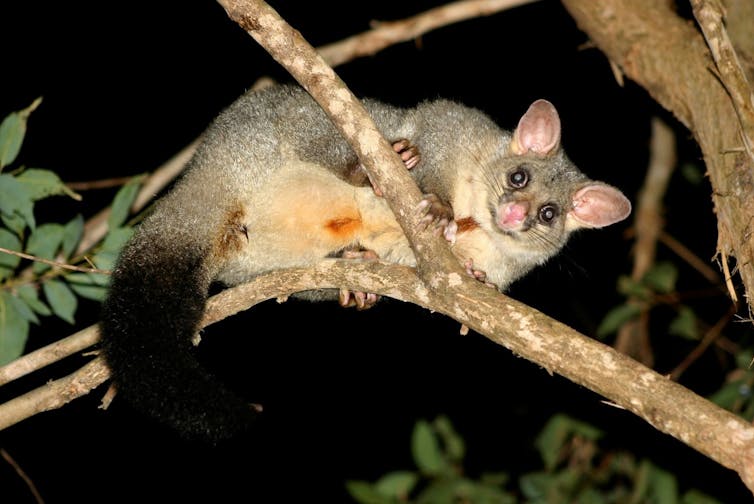
Every year, Australia’s wildlife volunteers devote time, effort and their own money to rescue, rehabilitate and release tens of thousands of native animals. Their efforts get a lot of media attention, particularly after huge disasters like the megafires of the 2019 Black Summer.
Readers will remember vivid images of koalas being rescued along with efforts to provide food to survivors in burnt habitats.
But little is known about what happens to these creatures after they’re released back into the wild. Our new research on hand-reared brushtail possums has found release back into the wild can be fraught with danger.
In our study, almost half were killed. The main culprit: foxes. But there are things we can do.
Rescue, Rehabilitation And Release
Brushtail possums are the fifth most rescued native species in New South Wales. When a mother possum is attacked by a predator, hit by a car or burnt in a bushfire, human volunteers will often artificially raise any orphaned offspring.
Rearing babies as well as rescue and rehabilitation are important. But the wild holds threats such as hungry predators. Not only that, but the reason an animal had to be rescued in the first place could still be present.
To find out the fate of rescued animals, we used radio-tracking collars to follow 20 hand-reared possums up to 40 days after release. Of these, only eight (40%) survived until the end of the study, while nine (45%) were killed by foxes or had to be returned to rehabilitation, and three possums had unknown fates, as they lost radio signal.
Foxes were responsible for all possum deaths, and most happened within three days of release. Unfortunately, hand-reared animals often haven’t learned the behaviours to detect and avoid predators.
You might think survival would be a game of chance. In fact, we found possums with more exploratory personalities and those which were less tame were more likely to survive. These qualities may have helped possums find food and refuge more effectively on their own in the wild.
That means the odds are stacked against orphaned, hand-reared possums. Because they’ve been raised by human carers, their personalities can be very different to those of wild possums. In short, captivity can alter the development of behaviours which might be important for survival in the wild. The longer animals spend with humans and the more tame they become, the less they seek refuge, recognise predators and find food effectively.
By contrast, it didn’t matter much whether the possums were released without further support, or whether carers left food supplies to get them started. It also didn’t matter much whether they were released in urban or rural areas.
The possums which had highest survival rates were those which retained their wildness and had not become tame.
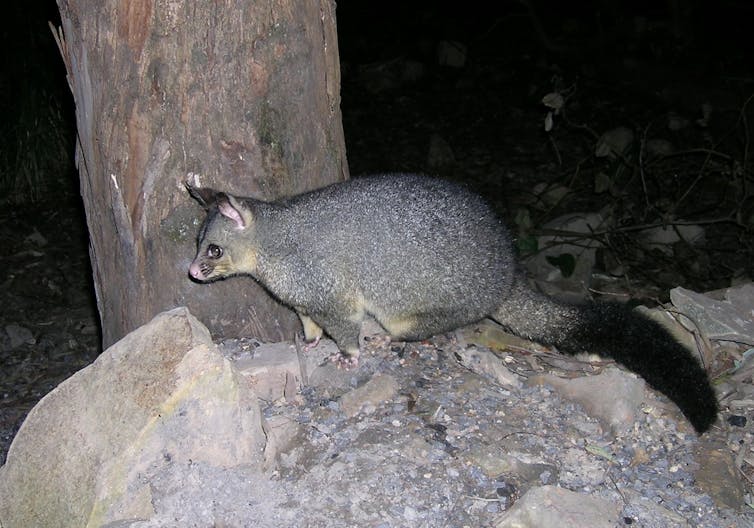
What Can We Learn?
So what should Australia’s wildlife carers do? It’s not as simple as advising wildlife rehabilitation organisations to minimise how long animals spend in captivity. Animals have to remain in rehabilitation until their illness or injury is treated, they’re physically ready for release and a suitable release site has been found.
We believe we need to test and develop new ways of reducing tameness and encouraging exploratory behaviour during rehabilitation.
Wildlife rehabilitators could use databases like Feral Scan to gauge how often introduced predators have been seen at particular release sites. Rehabilitators could also talk to local land managers to take advantage of fox control efforts, and aim to release possums when fox numbers have been suppressed. We also need to continue developing effective methods to train possums to avoid predators, such as borrowing from successful antipredator training used for other marsupials.
Where To From Here?
In our recent review, we analysed 112 studies on wildlife survival rates during rehabilitation or after release. We found factors affecting survival were often specific to species or contexts, such as the region of the world or the reason the animal needed rehabilitation.
Globally, we found human-related factors like collisions with cars and introduced predators were major causes of injury and death for rescued and released wildlife. Tackling threats in the environment must remain a priority to reduce the need for wildlife rescue in the first place.
We hope studies such as ours can improve guidelines for wildlife rescue, rehabilitation and release. To improve survival rates, scientists, government agencies and wildlife volunteers must develop evidence-based and species-specific protocols to give every rehabilitated animal the best chance at living a life in the wild.
As urbanisation fragments habitat and with natural disasters set to be more frequent and more severe due to climate change, we will need these protocols to enable quick, efficient rescue programs for wildlife.![]()
Holly Cope, Postdoctoral Research Associate, University of Sydney; Catherine Herbert, Associate professor, University of Sydney; Clare McArthur, Professor of Behavioural Ecology, University of Sydney, and Valentina Mella, Postdoctoral research associate, University of Sydney
This article is republished from The Conversation under a Creative Commons license. Read the original article.
Congo peat swamps store three years of global carbon emissions – imminent oil drilling could release it
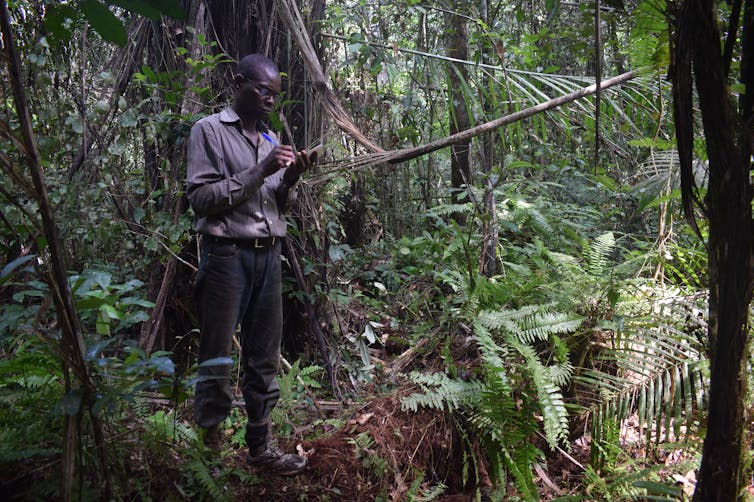
Democratic Republic of the Congo’s government is preparing to auction off a series of licenses to drill for oil in the Congo basin. This threatens to damage around 11 million hectares of the world’s second largest rainforest.
But it is not just trees that might be lost in the search for oil. Our new study, published in Nature Geoscience, shows at least three of 16 proposed oil licences planned for sale on July 28 2022 overlap with sensitive peat swamp forests, which store even more carbon below ground in their soils than is held by the trees above.
Regularly flooded peat swamp forests contain so much carbon because waterlogging slows the decay of dead plants. This partially decomposed material builds up over thousands of years to form peat. We have provided the first detailed map of the depth of this peat, and where exactly in the Congo basin all the carbon it contains can be found.

Our results confirm the central Congo peatlands to be the world’s largest tropical peatland complex. We estimate that the peatlands cover 16.7 million hectares, an area equivalent to the size of England and Wales combined, which is about 15% bigger than the 14.6 million hectares estimated when this ecosystem was first mapped in 2017.
When we overlayed our new map of the peatland on a map of oil concessions, we discovered that the upcoming sale of rights to explore for fossil fuels includes close to 1 million hectares of peat swamp forest. If destroyed by the construction of roads, pipelines and other infrastructure needed to extract the oil, we estimate that up to 6 billion tonnes of CO₂ could be released, equivalent to 14 years’ worth of current UK greenhouse gas emissions.
Scientists are just starting to understand these ecosystems, including their role as immense carbon reservoirs that provide a bulwark against rising global temperatures. But if oil companies get the go-ahead on July 28, our maps and other records may be all that’s left to prove intact peat swamp forests once existed in the Congo basin.
Trekking Into The Swamps
Until now, evidence of these peatlands in the Democratic Republic of the Congo (DRC) had not been published in a scientific journal. Although their existence was long suspected, it wasn’t until 2017 that scientists mapped the country’s peatlands for the first time by using field data from the neighbouring Republic of the Congo (RoC). They predicted that two-thirds of the world’s largest tropical peatland resided in the DRC, which had not been verified with field observations. Over three years, we trekked through these swamps as part of an international team of Congolese and UK scientists, often staying for months at a time.
We set off by dugout canoe to explore what we expected to be peatlands in forested floodplains along the Congo and its eastern tributaries. As we travelled upriver, we passed many small villages and fishing camps. Most are constructed on stilts because the river regularly floods its banks during the wet season which keeps the peat from breaking down and releasing its carbon back to the atmosphere.

These peatlands might be new to scientific literature, but they are familiar to the communities who have lived on their periphery for generations, relying on them for fishing, hunting and to collect building material. People here helped us explore the peatlands and allowed us to camp on their lands, where they shared their knowledge of the swamps and the many plant and animal species that live there. Together, we would set off on foot from the riverbank, trudging through a thick layer of mud into which we would sometimes sink up to our waists.
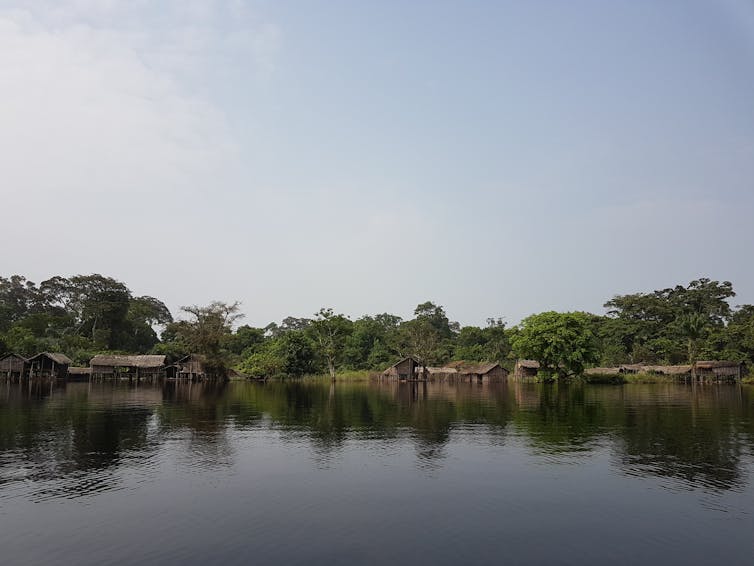
Every 250 metres we would stick metal poles in the ground to measure the thickness of the peat layer. To our astonishment, we often found peat of up to six metres deep just a few kilometres away from the river. This was totally unexpected, as the 2017 study conducted in the RoC only found peat of similar depth after trekking 20km into the swamp forest, far from any rivers. Knowing these regional differences is crucial – combined with satellite data, it allows us to map how thick the peat is likely to be in areas where we haven’t travelled. As the thickness of the peat layer largely determines how much carbon is stored in it, this is a major step forward in understanding the size of this natural carbon reservoir.
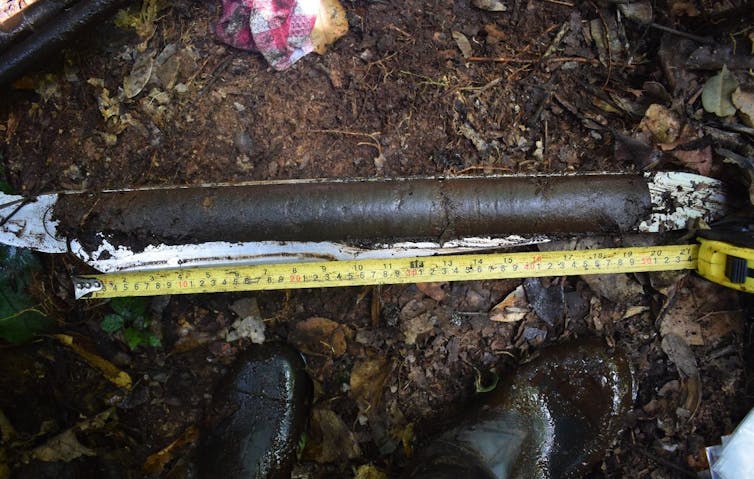
Reversing Massive Natural Defences
We also brought back peat samples to the laboratory to calculate the amount of carbon more precisely. Combining these different measurements, we conclude that the Congolese peat swamp forests are one of the most carbon-dense ecosystems on earth, storing an average of 1,712 tonnes of carbon per hectare. Together, the peatlands contain between 26 and 32 billion tonnes of carbon below ground – roughly equivalent to three years’ worth of global emissions from burning fossil fuels.
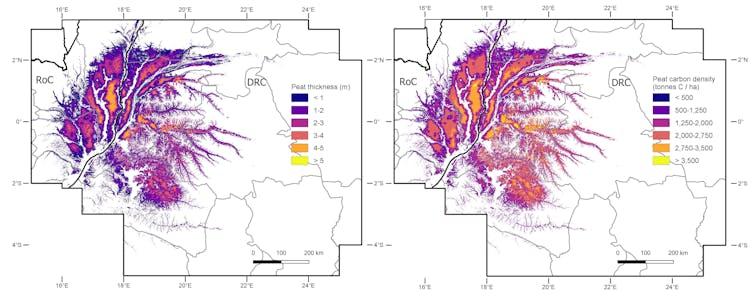
Our research is part of an ongoing, long-term effort to understand the world’s largest tropical peatland complex. The CongoPeat project aims to understand how and when the peatlands formed, and whether there are any new species to be found there. We also want to learn more about how stable this peat carbon is in a warming climate, and what effects logging, drainage for farming or oil exploration would have.
The DRC oil auction on July 28 could be the beginning of the end for these peatlands. Opening them to oil exploration before the Congolese people and the rest of the world can even know what the true cost would be is irresponsible. The country risks a mistake of epic proportions. What we do know is that by locking up carbon, the peatlands have helped cool the climate for thousands of years. To reverse this valuable natural defence against climate change in the space of a few years, simply to find more of a fuel which the world already has more of than it can safely burn, is not something life on Earth can afford.

Don’t have time to read about climate change as much as you’d like?
Get a weekly roundup in your inbox instead. Every Wednesday, The Conversation’s environment editor writes Imagine, a short email that goes a little deeper into just one climate issue. Join the 10,000+ readers who’ve subscribed so far.![]()
Bart Crezee, PhD Candidate in Tropical Peatland Ecology, University of Leeds and Simon Lewis, Professor of Global Change Science at University of Leeds and, UCL
This article is republished from The Conversation under a Creative Commons license. Read the original article.
Landsat turns 50: How satellites revolutionized the way we see – and protect – the natural world
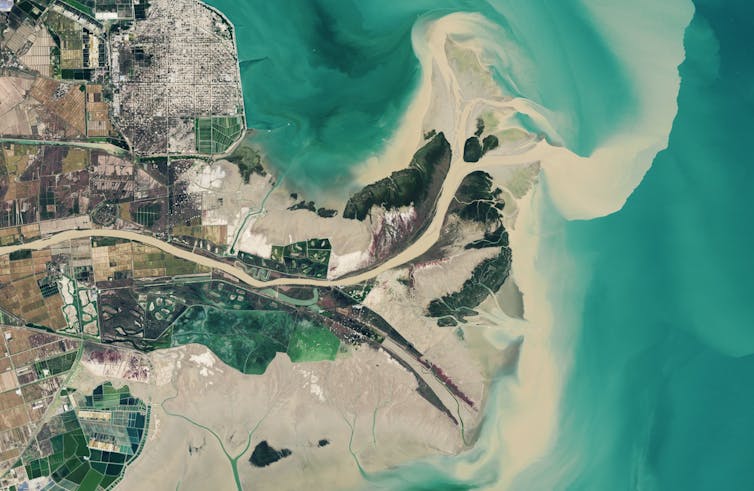
Fifty years ago, U.S. scientists launched a satellite that dramatically changed how we see the world.
It captured images of Earth’s surface in minute detail, showing how wildfires burned landscapes, how farms erased forests, and many other ways humans were changing the face of the planet.
The first satellite in the Landsat series launched on July 23, 1972. Eight others followed, providing the same views so changes could be tracked over time, but with increasingly powerful instruments. Landsat 8 and Landsat 9 are orbiting the planet today, and NASA and the U.S. Geological Survey are planning a new Landsat mission.
The images and data from these satellites are used to track deforestation and changing landscapes around the world, locate urban heat islands, and understand the impact of new river dams, among many other projects. Often, the results help communities respond to risks that may not be obvious from the ground.
Here are three examples of Landsat in action, from The Conversation’s archive.
Tracking Changes In The Amazon
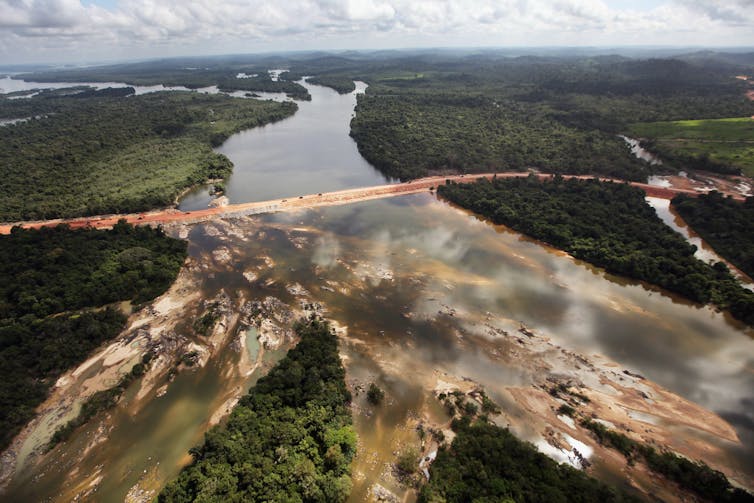
When work began on the Belo Monte Dam project in the Brazilian Amazon in 2015, Indigenous tribes living along the Big Bend of the Xingu River started noticing changes in the river’s flow. The water they relied on for food and transportation was disappearing.
Upstream, a new channel would eventually divert as much as 80% of the water to the hydroelectric dam, bypassing the bend.
The consortium that runs the dam argued that there was no scientific proof that the change in water flow harmed fish.
But there is clear proof of the Belo Monte Dam project’s impact – from above, write Pritam Das, Faisal Hossain, Hörður Helgason and Shahzaib Khan at the University of Washington. Using satellite data from the Landsat program, the team showed how the dam dramatically altered the hydrology of the river.
“As scientists who work with remote sensing, we believe satellite observations can empower populations around the world who face threats to their resources,” Das and his colleagues write.
It’s Hot In The City – And Even Hotter In Some Neighborhoods

Landsat’s instruments can also measure surface temperatures, allowing scientists to map heat risk street by street within cities as global temperatures rise.
“Cities are generally hotter than surrounding rural areas, but even within cities, some residential neighborhoods get dangerously warmer than others just a few miles away,” writes Daniel P. Johnson, who uses satellites to study the urban heat island effect at Indiana University.
Neighborhoods with more pavement and buildings and fewer trees can be 10 degrees Fahrenheit (5.5 C) or more warmer than leafier neighborhoods, Johnson writes. He found that the hottest neighborhoods tend to be low-income, have majority Black or Hispanic residents and had been subjected to redlining, the discriminatory practice once used to deny loans in racial and ethnic minority communities.
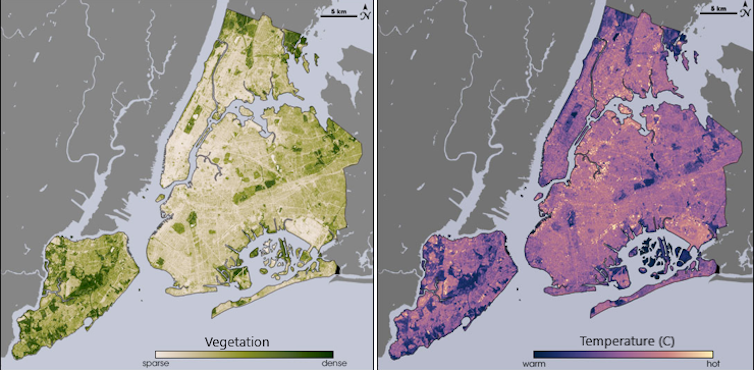
“Within these ‘micro-urban heat islands,’ communities can experience heat wave conditions well before officials declare a heat emergency,” Johnson writes.
Knowing which neighborhoods face the highest risks allows cities to organize cooling centers and other programs to help residents manage the heat.
The Making Of Ghost Forests
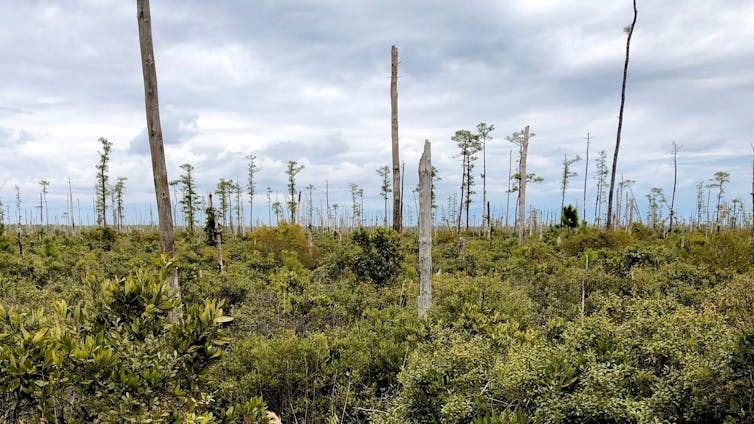
Satellites that scan the same areas year after year can be crucial for spotting changes in hard-to-reach regions. They can monitor snow and ice cover, and, along U.S. Atlantic coast, dying wetland forests.
These eerie landscapes of dead, often bleached-white tree trunks have earned the nickname “ghost forests.”
Emily Ury, an ecologist now at the University of Waterloo in Ontario, used Landsat data to spot wetland changes. She then zoomed in with high-resolution images from Google Earth – which includes Landsat images – to confirm that they were ghost forests.
“The results were shocking. We found that more than 10% of forested wetland within the Alligator River National Wildlife Refuge [in North Carolina] was lost over the past 35 years. This is federally protected land, with no other human activity that could be killing off the forest,” Ury writes.
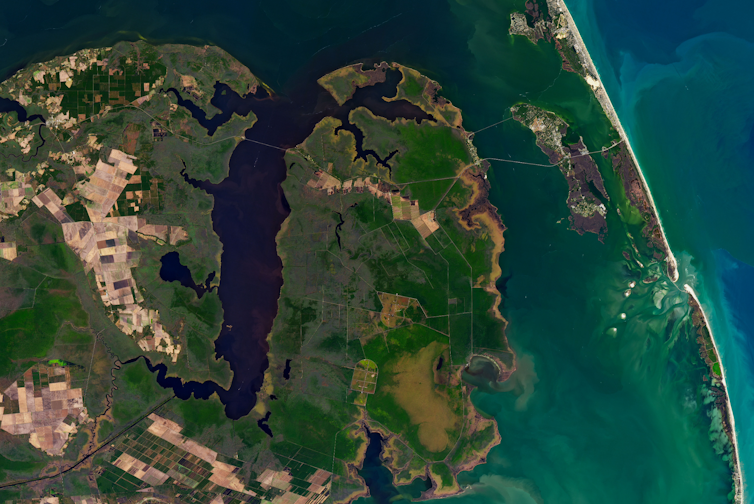
As the planet warms and sea levels rise, more salt water is reaching these areas, increasing the amount of salt in the soil of coastal woodlands from Maine to Florida. “Rapid sea level rise seems to be outpacing the ability of these forests to adapt to wetter, saltier conditions,” Ury writes.
Many more stories can be found in Landsat’s images, such as an overview of the war’s effects on Ukraine’s wheat crop, and how algae blooms have spread in Florida’s Lake Okeechobee. Countless projects are using Landsat data to track global change and possibly find solutions to problems, from deforestation in the Amazon to the fires that have put Alaska on pace for another historic fire season. ![]()
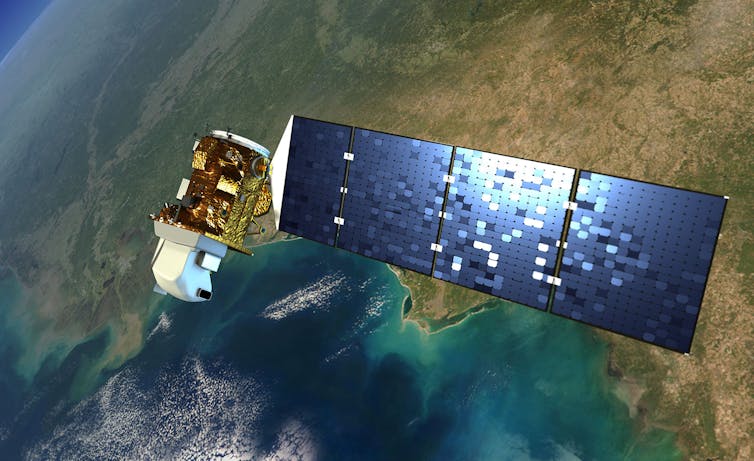
Stacy Morford, Environment + Climate Editor, The Conversation
This article is republished from The Conversation under a Creative Commons license. Read the original article.
Pittwater Reserves: Histories + Notes + Pictorial Walks
A History Of The Campaign For Preservation Of The Warriewood Escarpment by David Palmer OAM and Angus Gordon OAM
America Bay Track Walk - photos by Joe Mills
An Aquatic June: North Narrabeen - Turimetta - Collaroy photos by Joe Mills
Angophora Reserve - Angophora Reserve Flowers
Annie Wyatt Reserve - A Pictorial
Avalon's Village Green: Avalon Park Becomes Dunbar Park - Some History + Toongari Reserve and Catalpa Reserve
Bairne Walking Track Ku-Ring-Gai Chase NP by Kevin Murray
Bangalley Headland Bangalley Mid Winter
Banksias of Pittwater
Barrenjoey Boathouse In Governor Phillip Park Part Of Our Community For 75 Years: Photos From The Collection Of Russell Walton, Son Of Victor Walton
Barrenjoey Headland: Spring flowers
Barrenjoey Headland after fire
Bayview Baths
Bayview Wetlands
Beeby Park
Bilgola Beach
Botham Beach by Barbara Davies
Bungan Beach Bush Care
Careel Bay Saltmarsh plants
Careel Bay Birds
Careel Bay Clean Up day
Careel Bay Playing Fields History and Current
Careel Creek
Careel Creek - If you rebuild it they will come
Centre trail in Ku-ring-gai Chase National Park
Chiltern Track- Ingleside by Marita Macrae
Clareville Beach
Clareville/Long Beach Reserve + some History
Coastal Stability Series: Cabbage Tree Bay To Barrenjoey To Observation Point by John Illingsworth, Pittwater Pathways, and Dr. Peter Mitchell OAM
Cowan Track by Kevin Murray
Curl Curl To Freshwater Walk: October 2021 by Kevin Murray and Joe Mills
Currawong and Palm Beach Views - Winter 2018
Currawong-Mackerel-The Basin A Stroll In Early November 2021 - photos by Selena Griffith
Currawong State Park Currawong Beach + Currawong Creek
Deep Creek To Warriewood Walk photos by Joe Mills
Drone Gives A New View On Coastal Stability; Bungan: Bungan Headland To Newport Beach + Bilgola: North Newport Beach To Avalon + Bangalley: Avalon Headland To Palm Beach
Duck Holes: McCarrs Creek by Joe Mills
Dunbar Park - Some History + Toongari Reserve and Catalpa Reserve
Dundundra Falls Reserve: August 2020 photos by Selena Griffith - Listed in 1935
Elsie Track, Scotland Island
Elvina Track in Late Winter 2019 by Penny Gleen
Elvina Bay Walking Track: Spring 2020 photos by Joe Mills
Elvina Bay-Lovett Bay Loop Spring 2020 by Kevin Murray and Joe Mills
Fern Creek - Ingleside Escarpment To Warriewood Walk + Some History photos by Joe Mills
Iluka Park, Woorak Park, Pittwater Park, Sand Point Reserve, Snapperman Beach Reserve - Palm Beach: Some History
Ingleside
Ingleside Wildflowers August 2013
Irrawong - Ingleside Escarpment Trail Walk Spring 2020 photos by Joe Mills
Irrawong - Mullet Creek Restoration
Katandra Bushland Sanctuary - Ingleside
Lucinda Park, Palm Beach: Some History + 2022 Pictures
McCarrs Creek
McCarr's Creek to Church Point to Bayview Waterfront Path
McKay Reserve
Mona Vale Beach - A Stroll Along, Spring 2021 by Kevin Murray
Mona Vale Headland, Basin and Beach Restoration
Mount Murray Anderson Walking Track by Kevin Murray and Joe Mills
Mullet Creek
Narrabeen Creek
Narrabeen Lagoon Catchment: Past Notes Present Photos by Margaret Woods
Narrabeen Lagoon State Park
Narrabeen Lagoon State Park Expansion
Narrabeen Rockshelf Aquatic Reserve
Nerang Track, Terrey Hills by Bea Pierce
Newport Bushlink - the Crown of the Hill Linked Reserves
Newport Community Garden - Woolcott Reserve
Newport to Bilgola Bushlink 'From The Crown To The Sea' Paths: Founded In 1956 - A Tip and Quarry Becomes Green Space For People and Wildlife
Pittwater spring: waterbirds return to Wetlands
Pittwater's Lone Rangers - 120 Years of Ku-Ring-Gai Chase and the Men of Flowers Inspired by Eccleston Du Faur
Pittwater's Parallel Estuary - The Cowan 'Creek
Resolute Track at West Head by Kevin Murray
Resolute Track Stroll by Joe Mills
Riddle Reserve, Bayview
Salvation Loop Trail, Ku-Ring-Gai Chase National Park- Spring 2020 - by Selena Griffith
Stapleton Reserve
Stapleton Park Reserve In Spring 2020: An Urban Ark Of Plants Found Nowhere Else
The Chiltern Track
The Resolute Beach Loop Track At West Head In Ku-Ring-Gai Chase National Park by Kevin Murray
Towlers Bay Walking Track by Joe Mills
Trafalgar Square, Newport: A 'Commons' Park Dedicated By Private Landholders - The Green Heart Of This Community
Tranquil Turimetta Beach, April 2022 by Joe Mills
Turimetta Beach Reserve by Joe Mills, Bea Pierce and Lesley
Turimetta Beach Reserve: Old & New Images (by Kevin Murray) + Some History
Turimetta Headland
Warriewood Wetlands and Irrawong Reserve
Whale Beach Ocean Reserve: 'The Strand' - Some History On Another Great Protected Pittwater Reserve
Wilshire Park Palm Beach: Some History + Photos From May 2022
Winji Jimmi - Water Maze

New Shorebirds WingThing For Youngsters Available To Download
A Shorebirds WingThing educational brochure for kids (A5) helps children learn about shorebirds, their life and journey. The 2021 revised brochure version was published in February 2021 and is available now. You can download a file copy here.
If you would like a free print copy of this brochure, please send a self-addressed envelope with A$1.10 postage (or larger if you would like it unfolded) affixed to: BirdLife Australia, Shorebird WingThing Request, 2-05Shorebird WingThing/60 Leicester St, Carlton VIC 3053.

 Shorebird Identification Booklet
Shorebird Identification Booklet
The Migratory Shorebird Program has just released the third edition of its hugely popular Shorebird Identification Booklet. The team has thoroughly revised and updated this pocket-sized companion for all shorebird counters and interested birders, with lots of useful information on our most common shorebirds, key identification features, sighting distribution maps and short articles on some of BirdLife’s shorebird activities.
The booklet can be downloaded here in PDF file format: http://www.birdlife.org.au/documents/Shorebird_ID_Booklet_V3.pdf
Paper copies can be ordered as well, see http://www.birdlife.org.au/projects/shorebirds-2020/counter-resources for details.
Download BirdLife Australia's children’s education kit to help them learn more about our wading birdlife
Shorebirds are a group of wading birds that can be found feeding on swamps, tidal mudflats, estuaries, beaches and open country. For many people, shorebirds are just those brown birds feeding a long way out on the mud but they are actually a remarkably diverse collection of birds including stilts, sandpipers, snipe, curlews, godwits, plovers and oystercatchers. Each species is superbly adapted to suit its preferred habitat. The Red-necked Stint is as small as a sparrow, with relatively short legs and bill that it pecks food from the surface of the mud with, whereas the Eastern Curlew is over two feet long with a exceptionally long legs and a massively curved beak that it thrusts deep down into the mud to pull out crabs, worms and other creatures hidden below the surface.
Some shorebirds are fairly drab in plumage, especially when they are visiting Australia in their non-breeding season, but when they migrate to their Arctic nesting grounds, they develop a vibrant flush of bright colours to attract a mate. We have 37 types of shorebirds that annually migrate to Australia on some of the most lengthy and arduous journeys in the animal kingdom, but there are also 18 shorebirds that call Australia home all year round.
What all our shorebirds have in common—be they large or small, seasoned traveller or homebody, brightly coloured or in muted tones—is that each species needs adequate safe areas where they can successfully feed and breed.
The National Shorebird Monitoring Program is managed and supported by BirdLife Australia.
This project is supported by Glenelg Hopkins Catchment Management Authority and Hunter Local Land Services through funding from the Australian Government’s National Landcare Program. Funding from Helen Macpherson Smith Trust and Port Phillip Bay Fund is acknowledged.
The National Shorebird Monitoring Program is made possible with the help of over 1,600 volunteers working in coastal and inland habitats all over Australia.
The National Shorebird Monitoring program (started as the Shorebirds 2020 project initiated to re-invigorate monitoring around Australia) is raising awareness of how incredible shorebirds are, and actively engaging the community to participate in gathering information needed to conserve shorebirds.
In the short term, the destruction of tidal ecosystems will need to be stopped, and our program is designed to strengthen the case for protecting these important habitats.
In the long term, there will be a need to mitigate against the likely effects of climate change on a species that travels across the entire range of latitudes where impacts are likely.
The identification and protection of critical areas for shorebirds will need to continue in order to guard against the potential threats associated with habitats in close proximity to nearly half the human population.
Here in Australia, the place where these birds grow up and spend most of their lives, continued monitoring is necessary to inform the best management practice to maintain shorebird populations.
BirdLife Australia believe that we can help secure a brighter future for these remarkable birds by educating stakeholders, gathering information on how and why shorebird populations are changing, and working to grow the community of people who care about shorebirds.
To find out more visit: http://www.birdlife.org.au/projects/shorebirds-2020/shorebirds-2020-program
Aussie Bread Tags Collection Points

Be The Boss: I Want To Be A Builder
To become a builder, you usually have to complete a VET qualification in building and construction (Carpenter Craftsan's Certificate for instance). As subjects and prerequisites can vary between institutions, you should contact your chosen institution for further information. You can also become a builder by studying construction management or building at university. To get into these courses you usually need to gain your Senior Secondary Certificate of Education. Prerequisite subjects, or assumed knowledge, in one or more of English and mathematics are normally required. Universities have different prerequisites and some have flexible entry requirements or offer external study. Contact the institutions you are interested in for more information.
Personal requirements for a Builder
- Good communication and interpersonal skills
- Management and leadership skills
- Good planning and organisational skills
- Aptitude for technical activities
- Strong physical ability to handle the workload
- Decision making and problem solving abilities
Being a Builder can be a tough job, and you can’t be afraid to get your hands (literally) dirty if you want to make a career out of it, but there are plenty of benefits to working in building and construction, and Open Collages (Australian) are going to share a few of them with you.
1. Your job doubles as a daily workout routine
Working in the building and construction industry can be physically demanding, and there is a certain level of fitness that is required. You’ll be lifting, pushing, pulling and hauling things across the job site, as well as using machinery and equipment. But unlike an office job, where you’ll be stuck behind a desk all day, working as a Builder means that you’ll be keeping active all day, every day. In time, you’ll see how this will improve your overall fitness levels.
2. Create a strong network
Working on different sites throughout the year means that you’ll be working alongside a variety of people with a wide range of skills. Over time, you’ll build a strong network of contacts and friends. And you never know where those connections and friendships might take you.
3. Being a Builder pays well
As a Tradie, you’ll be earning around $1458 per week, according to the government’s Job Outlook website. This jumps all the way up to $3450 per week for Construction Managers.
4. Work anywhere
The building and construction industry isn’t one that’s limited by geography, whether you live in one of the country’s major cities or in a regional town. As the population of regional areas continues to grow, so will the demand for new infrastructure.
5. Early start means early finish
While construction sites usually start pretty early (around 7am), this just means that you get to knock off sooner! While most office jobs finish at around 5-6pm, Builders can expect to finish earlier than this – which means you have more hours in the day for ‘me’ time. Head to the gym, catch up with mates, join a local sports team or just enjoy extra time at home with your family and doing the things you love.
6. You don’t have to wait for a home renovator
As a professional Builder, you’ll be able to take care of your own home renovations without having to hire someone else. And if there’s something you can’t take care of yourself, or if you need another pair of hands, you can call in a favour from that strong network group we mentioned earlier.
7. Get plenty of sunshine
If you really can’t stand the thought of working behind a desk, then becoming a Builder is the perfect career move for you. You’ll be spending a lot of time outdoors, which also means you’ll be getting a healthy dose of Vitamin D every day! Vitamin D is actually incredibly important when it comes to building strong bones and teeth, as well as helping the immune system to function. Just remember to wear the right kind of protective clothing and sunscreen.
8. Job stability and reliability
In 2019, the building and construction industry employed 1.5million workers in Australia. That’s a whopping 9% of the total workforce.³ By 2023, it’s predicted there will be at least another 118,800 jobs created, which is a growth of 10%. And while the industry itself has slowed down due to the COVID-19 pandemic, by no means has it stopped. In fact, the building and construction industry may be the key to helping the Australian economy recover.
Are you thinking of starting a career in building and construction?
Open Colleges has a number of building and construction courses that will teach you the skills and knowledge you need to begin your career or take the next step up the (career) ladder. Our courses have been designed by vocational experts, which means that everything covered in your course will be relevant and up to date, while adhering to the highest industry standards. We have three building and construction courses available to study online:
- CPC50210 Diploma of Building and Construction (Building)
- CPC40110 Certificate IV in Building and Construction (Building)
- CPC50210 Diploma of Building and Construction (Building) (Western Australia)
Triangular Tri Scale Ruler for: Architects, Engineers and Builders reading Building/Construction Plans
Builder as a job information courtesy Australian Open Colleges and The Good Universities Guide, Australia.
Art Competition To Remember Our ANZACS
Word Of The Week: Positive
adjective
1. consisting in or characterized by the presence rather than the absence of distinguishing features.
2. constructive, optimistic, or confident.
noun
1. a desirable or constructive quality or attribute. 2. a positive photographic image, especially one printed from a negative. 3. with no possibility of doubt; definite.
4. (of a quantity) greater than zero. 5. containing, producing, or denoting an electric charge opposite to that carried by electrons.
Grammar; denoting the primary degree of an adjective or adverb, which expresses simple quality without qualification.
Philosophy; dealing only with matters of fact and experience; not speculative or theoretical.
From late Middle English: from Old French positif, -ive or Latin positivus, from posit- ‘placed’, from the verb ponere. The original sense referred to laws as being formally ‘laid down’, which gave rise to the sense ‘explicitly laid down and admitting no question’, hence ‘certain’.
Further: early 14c., originally a legal term meaning "formally laid down, decreed or legislated by authority" (opposed to natural), from Old French positif (13c.) and directly from Latin positivus "settled by agreement, positive" (opposed to naturalis "natural"), from positus, past participle of ponere "put, place".
The sense of "absolute" is from mid-15c. Meaning in philosophy of "dealing only with facts" is from 1590s. Sense broadened to "expressed without qualification" (1590s), then, of persons, "confident in opinion" (1660s). The meaning "possessing definite characters of its own" is by 1610s. The mathematical use for "greater than zero" is by 1704. Psychological sense of "concentrating on what is constructive and good" is recorded from 1916. Positive thinking is attested from 1953. The sense in electricity is from 1755.
Daryl Hall & John Oates - You Make My Dreams (Official HD Video)
Frank Sinatra: That's Life (Remastered 2008)
I've been up and down and over and out
And I know one thing
Each time I find myself
Flat on my face
I pick myself up and get
Back in the race
Pete Townshend - Let My Love Open The Door
Music video by Pete Townshend performing Let My Love Open The Door. (C) 1980 Eel-Pie Recording Productions Ltd.
Gardens Connecting Communities
Published by the Royal Botanic Gardens and Domain, July 25, 2022
The Royal Botanic Gardens and Domain Trust’s Community Greening program is committed to taking its expertise ‘beyond the garden walls and serving the broader community through innovative community-led gardens.
When Community Greening participants were surveyed about direct impacts on their lives, the feedback demonstrated 85% positive effect on health and 91% said it had a positive effect on their community; 73% are exercising more and 61% are eating better.
Community Greening is a non-profit program, which depends on government funding and private donations to operate.
Learn more about Community Greening: www.botanicgardens.org.au
How The Clash’s Joe Strummer inspired progressive politics in his fans

Joe Strummer, lead singer and lyricist for the seminal punk band, The Clash, died 20 years ago this December. Strummer, the son of a British senior civil servant and whose real name was John Graham Mellor, wrote songs that did not shy away from the politics of the Thatcher era or situations affecting society around the world.
The Clash had six studio albums, which featured 16 top-40 hits, including Rock the Casbah and I Fought the Law. After his death, the Guardian noted that Strummer was a “political inspiration for a generation” and “the political conscience of punk”.
I spoke to more than 100 individuals of different ages and genders from different generations, countries and continents for my book: The punk rock politics of Joe Strummer: Radicalism, resistance and rebellion, I found that his music has had a profound impact on the politics of many, leading some to left-wing activism. Among their number are many union leaders in Britain today, including Matt Wrack of the Fire Brigades Union, who said): “Firefighters are immensely proud of our links with Joe Strummer and what he stood for politically and as a musician.”
According to many of those I spoke to, the lyrics in the music of The Clash provided them with an effective but unconventional initial education about issues in Britain and further afield such as unemployment and sub-standard housing in Britain as well as various political causes globally, such as the struggle of the Sandinista movement in Nicaragua in the 1980s.
Political Lyrics
Two Strummer songs stand out in particular for those that I spoke to. The first is Spanish Bombs from the band’s third album, London Calling (1979), which was primarily about the Spanish Civil War of 1936-1939, Strummer sings:
The freedom fighters died upon the hill
They sang the red flag
They wore the black one…
The hillsides ring with “Free the people”
As a song about the democratically elected Republican government’s struggle against Francisco Franco’s fascist military coup, it recounts how socialists, communists, republicans and anarchists fought together for freedom, liberty and equality. Spanish Bombs led many who gave me testimonials to read the likes of George Orwell’s Homage to Catalonia.
The song also provided a historical example of active resistance to fascism when a hard right nationalism was on the rise in Britain in the late 1970s. The fringe National Front political party ran on an extreme anti-immigrant platform in the 1970s, using racist slogans and pamphlets to attract members. This was in turn met with an increasingly vocal reaction from musicians like Strummer and the Rock Against Racism movement.
An International Outlook
The band’s fourth album, Sandinista!, released in 1980, embraced the cause of the Sandinista rebels against the Somoza regime in Nicaragua and attacked US attempts to underime the revolution. The Somoza family headed up a murderous and repressive dictatorship from the 1930s, which was propped up by the US and which fell in 1979 as a result of a popular armed rebellion led by the Sandinistas.
Strummer’s song Washington Bullets references the anti-democratic effects of American imperialism in central and south America, from the 1959 Cuban Revolution to the Nicaraguan Sandinistas of the 1980s, with mention of America’s aborted Bay of Pigs invasion of Cuba in 1961 and the assassination of Chile’s Salvador Allende at the hands of the Chilean military dictatorship in 1973. In it, he sings:
As every cell in Chile will tell
The cries of the tortured men
Remember Allende
The song then details what happened when the US withdrew its support from the Nicaraguan Somoza regime:
When they had a revolution in Nicaragua
There was no interference from America
The people fought the leader
And up he flew
Without any Washington bullets, what else could he do?
Strummer explains that despite repression, resistance is possible – and can be successful. His anger in the song is not just directed against Washington but also against British, Chinese and Russian imperialism. Not only did some of those I spoke to join the Nicaragua Solidarity Committee but a few also went to work as volunteers in Nicaragua to support the Sandinista revolution.
Seeking Knowledge
Many of those I spoke to recounted to me that before the era of the internet, they went to public libraries to find out more about these issues. From there, they started to form radical worldviews and began to join campaigns such as the anti-apartheid movement and the Campaign for Nuclear Disarmament. Many also joined trade unions and left-wing political parties such as the Labour Party. And, with their interest piqued, they began to read widely.
Strummer was able to reach people through his music. His songs not only made people dance but through their radical messages, they were able to inspire some fans to action. Whether it be fascism and imperialism or over environmental destruction (London Calling), fighting racism (Working for the Clampdown) and Thatcherism (This is England) he moved people.
Strummer was seldom explicit about what listeners should then do – his songs tended to be more informative and inspirational than instructional. But he was nevertheless always clear that activism was positive and necessary to effect change. The Clash’s first single in 1977, White Riot, encouraged disaffected young white people to fight against political corruption and police brutality as their black brethren had. In Working for the Clampdown from the band’s 1979 album London Calling, he issued this call to arms:
Kick over the wall, cause governments to fall.
How can you refuse it?
Let fury have the hour, anger can be power.
Do you know that you can use it?
Gregor Gall, Affiliate Research Associate, School of Political and Social Sciences, University of Glasgow
This article is republished from The Conversation under a Creative Commons license. Read the original article.
How pioneering Australian linocut artists Ethel Spowers and Eveline Syme captured an exciting era of change

Review: Spowers & Syme, Geelong Gallery.
In their pioneering coloured linocut prints, Ethel Spowers (1890-1947) and Eveline Syme (1888-1961) captured the flux and excitement of an era of rapid change.
Their modernist interpretations of Australia in the interwar period have both a complexity and a simplicity. Colour is simultaneously bold and subtle; lines vigorous and delicate. Rhythm, arcs and movement populate their images of everyday spaces, people and places.
Yet, despite initial recognition in their time, Spowers and Syme have been largely forgotten.
Now, a new exhibition meticulously curated by Sarina Noordhuis-Fairfax plots their friendship, influences and creative development in the decades after the first world war – a time when new freedoms were afforded to women of their means.
Discovering A New Art Form
Spowers and Syme were childhood friends from rival media families who ran competing newspapers, The Argus and the Age. Spowers studied art and Symes studied classics. As young women, both had developing art practices in painting and printmaking.
They had regularly travelled “abroad” and knew the world beyond Australia was transforming in exciting ways. By the late 1920s, they decided to be part of it.

Seeking the energy and liveliness of the London art scene, both women left Australia to learn linocut printing from Claude Flight at the Grosvenor School of Modern Art.
Linoleum, a new flooring material adopted by artists from 1900, was a cheap and accessible way to make prints. Flight saw the colour linocut print as a modern medium for a modern age: a medium that enabled innovation to respond to the excitement of the times.
Flight revolutionised printmaking in the UK. His work drew on cubism and futurism, translating his ideas into multi-coloured linocuts evoking the speed and movement of the machine age.
As a teacher, he generously shared his enthusiasm and knowledge with a talented group of colleagues and students, including Cyril Power, Sybil Andrews and Lill Tschudi.

The Grosvenor School artists regularly exhibited their lino prints throughout the interwar years, and a small survey of their work is displayed in the heart of the exhibition. Paired with a cluster of Ethel Spowers’ prints of irrepressible children – swinging, leaping, jumping and jostling – this inclusion contrasts and contextualises the diversity of mark, method and subject matter.
Urban Transformation
While Flight used curved lines and fragmented colours to evoke speed, on their return to Melbourne, Spowers and Syme developed a more subtle language of movement. Their work would capture the everydayness of change in urban landscapes and industrial sites, workers, child’s play and still life.
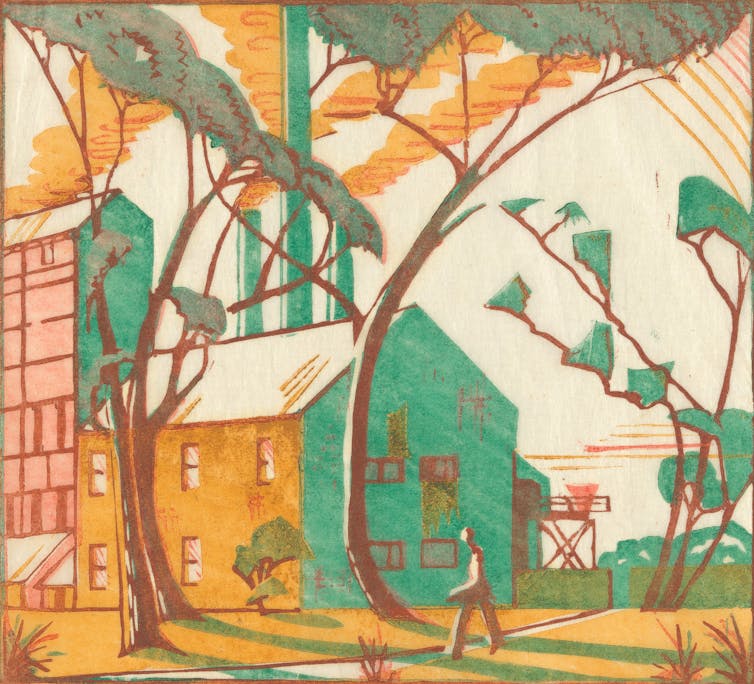
Symes’ scenes of trams, roads, factories and bridges embrace and celebrate urban transformation. The factory (1933) has a diminutive solitary figure purposefully striding past sinuous trees bending in the opposite direction set against a backdrop of vibrant green chimneys and belching orange smoke.
Produced from four differently carved pieces of lino and printed in four different colours, the subtlety of movement, patterns and extended palette are achieved by overprinting in transparent inks or paint. The background sky is the colour, texture and translucency of the oriental paper the work is printed on.
In Sydney tram line (1936), simple line work and blocks of colour send the eye across and up the image capturing the encroachment of industry and transport on a rather luscious green landscape.

The Movement Of People
Spowers’ linocuts capture momentary effects on people: rain pelting on a huddle of umbrellas, a frozen moment in children’s play and a rush of wind scattering sheets of paper.

In The Gust of Wind (1931), a newspaper-seller struggles to control his copies of the evening news. Arcs and rhythmic movements emphasise the futility of the worker’s attempts to contain the breakout.
Special Edition (1936) is a sea of newspapers, all firmly in the control of a phalanx of anonymous and obscured readers. The qualities of the oriental tissue paper are again employed as an intrinsic part of the image. The newspapers are defined by slender lines and the heads of readers blur into featureless anonymity.
Both remind us of Spowers’ family connection to the publishing industry.

A Sense Of Optimism
While it is exciting to contemplate and celebrate the very long friendship between Spowers and Syme – an alliance that enabled them both to pursue careers as professional artists – their works also give us a sense of their class and privilege.
Spowers’ surging newspaper readers and striding children all appear to be barrelling towards the future with confidence despite the Great Depression and the growing threat of fascism.
The demeanour is one of optimism, innocence, humour or cheerful bravura and the realities of their time largely overlooked. Like many educated women of their means, social responsibilities were acquitted through philanthropy. Syme, known for her commitment to women’s education reform, and Spowers to women’s and children’s hospitals.

Spowers and Syme made prints about a modernising Australia. They employed new materials and printing techniques, drawing on modernist art styles and influences to express their enthusiastic embrace of change. Movement is key and the combination of simple forms and dynamic, rhythmic lines animate the linocuts.
These qualities make reproductions easy to apprehend in print or online, however much of the luminosity, and unexpected nuances are lost and can only be truly appreciated in person.

Spowers & Symes offers a rich encounter with their imagery and their lives, where colour and line come to life, opening up an exciting era of transformation and change in Australian art.
Spowers & Symes is a National Gallery of Australia touring exhibition, at Geelong Gallery until October 16.![]()
Julie Shiels, Lecturer - School of Art, RMIT University
This article is republished from The Conversation under a Creative Commons license. Read the original article.
Labelling ‘fake art’ isn’t enough. Australia needs to recognise and protect First Nations cultural and intellectual property
Nicola St John, RMIT University and Emrhan Sultan, RMIT UniversityThe latest draft report from the Productivity Commission on Aboriginal and Torres Strait Islander visual arts and crafts confirms what First Nations artists have known for decades: fake art harms culture.
Released last week, the report details how two in three Indigenous-style products, souvenirs or digital imagery sold in Australia are fake, with no connection to – or benefit for – Aboriginal and Torres Strait Islander people.
This is a long-standing problem. As Aboriginal Elder Gawirrin Gumana (Yolngu) explained in 1996:
When that [white] man does that it is like cutting off our skin.
The Productivity Commission has proposed all inauthentic Indigenous art should be labelled as such. But we think a much bolder conversation needs to happen around protecting the cultural and intellectual property of Indigenous artists.
Australia has no national licensing or production guidelines to protect Indigenous cultural and intellectual property within commercial design and digital spaces. Our work hopes to see this change.
‘This Is Storytelling’
Our research focuses on supporting and representing First Nations artists within design and commercial spaces, understanding how to ensure cultural safety and appropriate payment and combat exploitation.
Many First Nations artists we spoke to told us stories of exploitative business models. They were blindly led into licensing agreements and client relations that were not culturally safe. Clients thought commissioning a design equated to “owning” the copyright to First Nations art, culture and knowledge.
Gudanji/Wakaja artist and winner of the 2022 NAIDOC poster competition Ryhia Dank told us:
We need clear recognition, structures and licensing guidelines to protect all of what First Nations ‘art’ represents. I know a lot of us, as we are starting out don’t know how to licence our work […]
One of my first designs was for a fabric company and I didn’t licence the design correctly, so that company is still using my design and I only once charged them $350 and that was it. Having legal support from the start is critical.
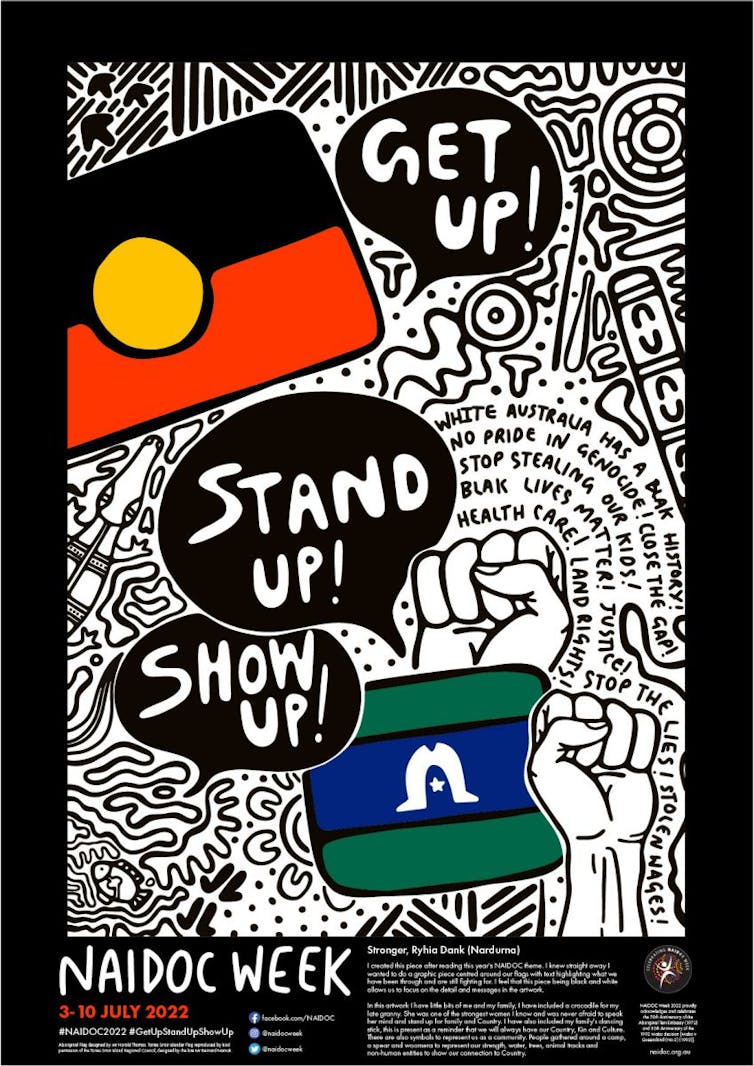
Arrernte and Anmatyerre graphic novelist Declan Miller explained how many clients and businesses are misguided in thinking commissioning a design equates to owning the copyright to First Nations knowledges.
“Our art is not just art,” he said.
Clients need to be aware this is storytelling. This is culture. We will always own that. But we are happy for clients to work with us, and use our art and pay us for it, but we have to keep that integrity. This is our story, this is where we are from, this is who we are and you can’t buy that or take that from us.
Protecting Property
Transparent labelling of inauthentic art is a great start, but there is more work needed.
Intellectual property laws and processes should adequately protect First Nations art.
“Indigenous cultural and intellectual property” refers to the rights First Nations people have – and want to have – to protect their traditional arts, heritage and culture.
This can include communally owned cultural practices, traditional knowledge and resources and knowledge systems developed by First Nations people as part of their First Nations identity.
First Nations products should be supplied by a First Nations business that protects Indigenous cultural and intellectual property, with direct benefits to First Nations communities.
The outcomes of our research have resulted in the recent launch of Solid Lines – Australia’s only First Nations illustration agency to be led by First Nations people. An integral part of this agency is the Indigenous cultural and intellectual property policy designed specifically for the design and commercial art industry.
The agency hopes this policy, created with Marrawah Law, will help create and support culturally safe and supportive pathways for First Nations creatives.
For First Nations artists represented by Solid Lines, our policy also means obtaining culturally appropriate approval to use family or community stories, and knowledges and symbols that are communally owned.
Recognition And Protection
The report from the Productivity commission focuses on fake art coming in from overseas, but fake art also happens in our own backyard.
In our research, we have spoken to Elders, traditional custodians, and community leaders who are concerned that Western and Central Desert designs, symbols and iconography are now used by other First Nations across Australia.
This work often undermines customary laws and limits economic benefits flowing back to communities.
Community designs, symbols and iconography are part of a cultural connection to a specific land or country of First Nations people. Embracing Indigenous cultural and intellectual property policies will mean designs, symbols and iconography can only be used by the communities they belong to.
The Productivity Commission calculated the value of authentic Aboriginal and Torres Strait Islander arts, crafts, and designs sold in Australia in 2019-2020 at A$250 million. This will only continue to grow as Australia’s design and commercial industries continue to draw upon the oldest continuing culture in the world.
Visible recognition and protection of First Nations cultural and intellectual property will allow for new creative voices to respectfully and safely emerge within Australian art and design industries.
Through embracing guidelines around Indigenous cultural and intellectual property, First Nations artists will be supported in cultural safety, appropriate payment and combat exploitation. This is the next step beyond labelling inauthentic art.![]()
Nicola St John, Lecturer, Communication Design, RMIT University and Emrhan Sultan, Researcher, RMIT School of Design, RMIT University
This article is republished from The Conversation under a Creative Commons license. Read the original article.
‘Suburban living did turn women into robots’: why feminist horror novel The Stepford Wives is still relevant, 50 years on

On August 26 1970, 50,000 women marched down Fifth Avenue in New York City in a Women’s Strike. Organised by feminist activist Betty Friedan, the march highlighted the fact women still performed the vast majority of domestic work.
The Women’s Liberation Movement wanted many things in 1970, but one of the most important was freedom from “unpaid domestic servitude at home”.
Half a century later, most women are still waiting for their freedom. Women still do far more domestic and care labour than men.
Since the 1960s, more and more women have taken up paid employment, but a problem remains: how would their unpaid domestic work be replaced?
Dramatising Women’s Suburban Alienation
Ira Levin’s novel The Stepford Wives offered a bleak answer: women themselves would be replaced. Levin powerfully dramatised women’s suburban alienation and men’s resistance to feminist change.

The Stepford Wives begins with Joanna Eberhart, a wife, mother and photographer, who moves with her family from Manhattan to the suburban town of Stepford. She is interested in tennis, photography and women’s liberation. Joanna and her husband Walter have a happy, respectful marriage. Yet Walter joins the mysterious Stepford Men’s Association, where the men of the town spend their evenings.
Joanna finds it hard to make friends in their new home: all the women of Stepford are too busy cooking and cleaning. In the 1975 film adaptation (directed by Bryan Forbes, with a screenplay by William Goldman), Joanna and her only friend, fellow newcomer Bobbie, begin a consciousness-raising group – designed to raise women’s feminist awareness – which is derailed by an intense discussion of the merits of Easy-On Spray Starch.
The women of Stepford transform into glassy-eyed housewives within months of arriving. Watching one of them admiring her washing, “like an actress in a commercial”, Joanna thinks
That’s what they all were, all the Stepford wives: actresses in commercials, pleased with detergents and floor wax, with cleansers, shampoos, and deodorants. Pretty actresses, big in the bosom but small in the talent, playing suburban housewives unconvincingly, too nicey-nice to be real.
Joanna and Bobbie realise, with mounting horror, that the Stepford women have literally been replaced by robots, in a scheme masterminded by their husbands – and they too, will be similarly transformed. Bobbie is first. She tells Joanna
I realised I was being awfully sloppy and self-indulgent. […] I’ve decided to do my job conscientiously, the way Dave does his.
The women’s personalities have been erased, but their families don’t seem to mind – Bobbie’s son is delighted because his mother now makes hot breakfasts, while the husbands are thrilled because their “new” wives love sex and housework.
Fearful that she “won’t be me next summer”, Joanne realises Walter has also changed. He tells her the women of Stepford have changed only
because they realised they’d been lazy and negligent […] It wouldn’t hurt you to look in a mirror once in a while.
Joanna agrees to see a psychiatrist, who prescribes her a sedative. But soon after, her voice vanishes from the novel, as she too has been transformed. At the story’s close, Joanna is gliding slowly through a supermarket, telling an acquaintance that she no longer does photography because “housework’s enough for me”.
An Extraordinary Feminist Horror Novel
The Stepford Wives is an extraordinary feminist horror novel. Its vision of a group of men who engineer housework-loving robots to replace their restless wives offered not only a satire of male fears of women’s liberation, but a savage view of heterosexual marriage. In this telling, a man would rather kill his wife and replace her with a robot than commit to equality and recognise her as a whole person.
Sarah Marshall, co-host of the podcast You’re Wrong About, argued the novel dramatised a real problem of the 1960s and 1970s: suburban living did transform women into robots. Tranquillisers like valium were massively over-prescribed for women who were suffering from “suburban neurosis”, both in Australia and the US.
The extraordinary 1977 Australian documentary All In The Same Boat suggested suburban women had to take drugs to cope because their husbands refused to shoulder their share of the burdens of home and family. In short, what was happening to the women of Stepford was happening to women everywhere. They were losing their identities in a sea of endless domestic labour.
Joanna’s bafflement at her neighbours’ absorption in domestic chores echoed the feelings of many women of the era. Betty Friedan’s The Feminine Mystique resonated with so many white women in the 1960s because it articulated their dissatisfaction with the postwar gender order. Friedan declared:
we can no longer ignore that voice within women that says: ‘I want something more than my husband and my children and my house.’
Like many who joined women’s liberation, Joanna also wanted something more. The novel made it clear that “more” would be difficult for many women.
From Post-Feminism To Get Out: Cultural Influence
It is telling that in post-feminist 2004, the Joanna in the Frank Oz film remake of The Stepford Wives is not a woman seeking liberation, but a TV network president who creates crass reality TV programs. Women’s liberation had been transformed into corporate feminism, and the engineer of the scheme was not the Stepford Men’s Association, but an exhausted career woman who wants to return to a “simpler” life. The remake took a feminist premise and made an anti-feminist film.
Despite the dismal failure of the 2004 film, The Stepford Wives left a significant cultural footprint. The term itself entered the vernacular. Filmmaker Jordan Peele cited The Stepford Wives as a key influence on his horror film Get Out, also set in white suburbia. And Alex Garland’s 2014 film Ex Machina, centred on a lifelike female robot who turns on her creator, was a biting critique of tech bro misogyny.
In a post-Roe v Wade world, where many men still seek to control women’s bodies and curtail their imaginations, Levin’s novel remains as chilling as ever.![]()
Michelle Arrow, Professor of History, Macquarie University
This article is republished from The Conversation under a Creative Commons license. Read the original article.
We are working from home (again). 7 tips to boost wellbeing and productivity

Telstra and Westpac are the latest companies to encourage staff to work from home, just a few months after some of them returned to the office.
Working from home for extended periods can leave employees feeling socially and professionally isolated. When people work from home, they have fewer opportunities to interact and acquire information, which may explain why remote workers feel less confident than their office-based counterparts.
Researchers also report working from home (WFH) is linked to negative physical health outcomes such as increased musculoskeletal pain and weight gain, as well as exhaustion.
If you are still working from home or your employer has just reinstated it, the good news is there are evidence-backed tips that can help overcome the challenges. Here are seven tips to navigating the coming weeks and months.
1. Maintain Your Connections
A chief complaint in surveys about working from home is social isolation. We miss connecting with our colleagues and friends.
Loneliness has significant implications for our work, with research showing work loneliness can result in emotional withdrawal, which ultimately leads to deteriorating performance and wellbeing, as well as poorer health.
Now lockdown restrictions have ended, maintaining connection is easier. Planning regular meet-ups with colleagues is an easy and effective way to overcome the social isolation felt working from home. Infection risks can be lessened by wearing respirators when you can’t socially distance. You should also stay home if you’re sick.
Some companies are now also implementing walking meetings. As well as connecting with others, it’s an easy way to get some exercise as well as the stress-reducing benefits of nature. In one study, walking was shown to increase creativity by 81%.
2. Tidy Up Regularly
While a messy desk has helped win a Nobel prize and may be helpful for creativity, removing clutter is recommended for a lot of the other types of tasks we undertake in an average workday. A clutter-free desk may reduce the cognitive load on our brains, making us more productive.
Researchers have found clutter influences employees’ thinking, emotions and behaviours. These factors affect decision-making, relationships, stress, eating choices and even sleep.
3. Limit Zoom Meetings And Reduce ‘Pings’
As technology platforms proliferate, so does the overload and distraction for our brains. After more than two years of WFH, the prospect of yet another Zoom meeting may well be uninspiring.
There are a few things we can do. Switch off notifications if possible, and ask whether each meeting really needs to happen. Using document sharing and email can sometimes replace meetings. A good old-fashioned telephone call may also be a good alternative. During a phone call, we only have to concentrate on one voice and can walk around, which can help thinking.

4. Ask For Feedback
Wondering how we are doing on the job undermines one of the key psychological drivers of our work, a sense of competence. It might be harder to gauge how your manager thinks you’re tracking with expectations, if you’re socially distant.
Obtaining feedback is vital for employees to develop this sense of competence, so make sure you ask for regular feedback.
5. Create A WFH Space
Research suggests replicating what you might have in the office can be a good way to control or mark out a work space at home. Having a proper desk does actually matter.
While few of us will have something as incredible as a musical puzzle desk, we can start with a desk that is both functional and attractive.
A flat surface, ergonomic chair, and suitable lighting can reduce problems such as eye strain, muscular pain or stiffness and back injuries, as well as decreasing fatigue.
6. Identify Restorative Spaces
Spaces that promote psychological and emotional detachment from work are also important. Restorative spaces, such as lounge areas, cafes, nature rooms and meditations spaces have begun to emerge in office settings in recent years.
Such spaces have been shown to support mental and physical replenishment.
Taking a break on your favourite couch or in a sunny spot during the workday is an important part of maintaining wellbeing and productivity – not something to feel guilty about.
7. Find Ways To Disconnect
It can be hard for employees who are working from home to switch off, particularly if we don’t have a dedicated home office space.
Around half of employees increase their work hours when WFH. Not being able to switch off can have implications beyond the work day.
A study from 15 countries found 42% of individuals who worked from home had trouble sleeping and woke up repeatedly in the night, compared to only 29% of individuals who always worked in the office.
Many workers enjoy not having to commute to the office, but there is a potential downside to losing the “transition time” involved in travelling from home. We might use this time to separate private issues from work ones, to prepare for the day ahead or process the one just passed.
In addition to practical considerations such as shutting down software and finalising tasks, research shows using defined end-of-day rituals can help achieve psychological detachment, emotional regulation of the nervous system and reduce physiological stress.
Instead of commuting, meditation, journaling, listening to music, engaging in hobbies or pleasurable activities, or undertaking exercise can give us a mental break, so we aren’t still thinking about work hours later.
More than two years into a forced global experiment, we now know a lot more about the benefits and challenges of working from home. Implementing these simple, evidence-backed strategies can make a big difference to our wellbeing.![]()
Libby (Elizabeth) Sander, Assistant Professor of Organisational Behaviour, Bond Business School, Bond University
This article is republished from The Conversation under a Creative Commons license. Read the original article.
This Australian experiment is on the hunt for an elusive particle that could help unlock the mystery of dark matter

Australian scientists are making strides towards solving one of the greatest mysteries of the universe: the nature of invisible “dark matter”.
The ORGAN Experiment, Australia’s first major dark matter detector, recently completed a search for a hypothetical particle called an axion – a popular candidate among theories that try to explain dark matter.
ORGAN has placed new limits on the possible characteristics of axions and thus helped narrow the search for them. But before we get ahead of ourselves …
Let’s Start With A Story
About 14 billion years ago, all the little pieces of matter – the fundamental particles that would later become you, the planet and the galaxy – were compressed into one very dense, hot region.
Then the Big Bang happened and everything flew apart. The particles combined into atoms, which eventually clumped together to make stars, which exploded and created all kinds of exotic matter.
After a few billion years came Earth, which was eventually crawling with little things called humans. Cool story, right? Turns out it’s not the whole story; it’s not even half.
People, planets, stars and galaxies are all made of “regular matter”. But we know regular matter makes up just one-sixth of all the matter in the universe.
The rest is made of what we call “dark matter”. Its name tells you almost everything we know about it. It doesn’t emit light (so we call it “dark”) and it has mass (so we call it “matter”).
If It’s Invisible, How Do We Know It’s There?
When we observe the way things move in space, we find time and again that we can’t explain our observations if we consider only what we can see.
Spinning galaxies are a great example. Most galaxies spin at speeds that can’t be explained by the gravitational pull from visible matter alone.
So there must be dark matter in these galaxies, providing extra gravity and allowing them to spin faster – without parts being flung off into space. We think dark matter literally holds galaxies together.

So there must be an enormous amount of dark matter in the universe, pulling on all the things we can see. It’s passing through you, too, like some kind of cosmic ghost. You just can’t feel it.
How Could We Detect It?
Many scientists believe dark matter could be composed of hypothetical particles called axions. Axions were originally proposed as part of a solution to another major problem in particle physics called the “strong CP problem” (which we could write a whole article about).
Anyway, after the axion was proposed, scientists realised the particle could also make up dark matter under certain conditions. That’s because axions are expected to have very weak interactions with regular matter, but still have some mass: the two conditions needed for dark matter.
So how do you go about searching for axions?
Well, since dark matter is thought to be all around us, we can build detectors right here on Earth. And, luckily, the theory that predicts axions also predicts that axions can convert into photons (particles of light) under the right conditions.
This is good news, because we’re great at detecting photons. And this is exactly what ORGAN does. It engineers the correct conditions for axion–photon conversion and looks for weak photon signals – little flashes of light generated by dark matter passing through the detector.
This kind of experiment is called an axion haloscope and was first proposed in the 1980s. There are a few in the world today, each one slightly different in important ways.

Shining A Light On Dark Matter
An axion is believed to convert into a photon in the presence of a strong magnetic field. In a typical haloscope, we generate this magnetic field using a big electromagnet called a “superconducting solenoid”.
Inside the magnetic field we place one or several hollow chambers of metal, which are meant to trap the photons and cause them to bounce around inside, making them easier to detect.
However, there is one hiccup. Everything that has a temperature constantly emits small random flashes of light (which is why thermal imaging cameras work). These random emissions, or “noise”, make it harder to detect the faint dark matter signals we’re looking for.
To work around this, we’ve placed our resonator in a “dilution refrigerator”. This fancy fridge cools the experiment to cryogenic temperatures, about −273°C, which greatly reduces the noise.
The colder the experiment is, the better we can “listen” for faint photons produced during dark matter conversion.
Targeting Mass Regions
An axion of a certain mass will convert into a photon of a certain frequency, or colour. But since the mass of axions is unknown, experiments must target their search to different regions, focusing on those where dark matter is considered more likely to exist.
If no dark matter signal is found, then either the experiment is not sensitive enough to hear the signal above the noise, or there’s no dark matter in the corresponding axion mass region.
When this happens, we set an “exclusion limit” – which is just a way of saying “we didn’t find any dark matter in this mass range, to this level of sensitivity”. This tells the rest of the dark matter research community to direct their searches elsewhere.
ORGAN is the most sensitive experiment in its targeted frequency range. Its recent run detected no dark matter signals. This result has set an important exclusion limit on the possible characteristics of axions.
This is the first phase of a multi-year plan to search for axions. We’re currently preparing the next experiment, which will be more sensitive and target a new, as-yet-unexplored mass range.
But Why Does Dark Matter Matter?
Well, for one, we know from history that when we invest in fundamental physics, we end up developing important technologies. For instance, all modern computing relies on our understanding of quantum mechanics.
We never would have discovered electricity, or radio waves, if we didn’t pursue things that, at the time, appeared to be strange physical phenomena beyond our understanding. Dark matter is the same.
Consider everything humans have accomplished by understanding just one-sixth of the matter in the universe – and imagine what we could do if we unlocked the rest.![]()
Ben McAllister, Research Fellow, Department of Physics, The University of Western Australia
This article is republished from The Conversation under a Creative Commons license. Read the original article.
3 reasons why women leaders actually matter for women

There are currently just 30 female presidents and prime ministers worldwide. Moldova and Barbados are the only two countries where women occupy both the positions of president and prime minister, while Bangladesh is the only nation where a woman has led for more years than a man over the last half century.
Clearly, women leaders matter as a question of gender equity, but as my research shows, they may also matter to women in other ways.
I looked at four different female presidents in three different political systems: the Philippines’ first female president, Corazon Aquino (1986–1992) and its second female leader, Gloria Macapagal Arroyo (2001–2010); Indonesia’s first and only female president, Megawati Sukarnoputri (2001–2004); and Sri Lanka’s Chandrika Bandaranaike Kumaratunga (CBK).
CBK, who was Sri Lanka’s fifth president from 1994 to 2005, followed in the footsteps of her mother, Sirimavo Bandarnaike, the world’s first female elected head of government in 1960.
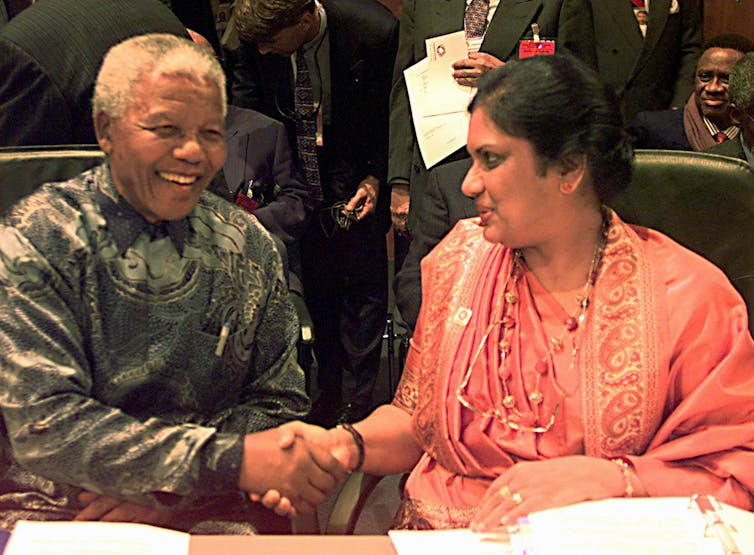
I was interested in the difference these women leaders made on women’s lives through the law. However, I did not want to blindly place a positive spin on the impact women have as presidents.
My research used the Gender Legislative Index, which relies on human evaluators and machine learning to determine how well laws advance women’s rights. The index indicated whether the laws enacted during these leaders’ tenures were “good” for women.
Of course, “women” are not a monolithic category with the same interests and needs. And nor are women leaders all the same. But there are three reasons why women leaders may matter more to women.
1. Bringing Women Up The Ladder
Appointment powers are central to presidential leadership. President Macapagal Arroyo herself acknowledged to me that President Aquino had “paved the way” for her, in multiple ways.
Aquino had invited Macapagal-Arroyo to join her government as Assistant Secretary of the Department of Trade and Industry.

Cabinet members directly influence what bills are introduced into the national legislature. Yet women have traditionally held fewer ministerial posts. Those held were often positions with discernible “feminine” characteristics or “low-prestige” portfolios, such as ageing, children and the family.
Of the four women I studied, like female leaders in Latin America, three appointed more women to their cabinets than the male leaders who preceded them. President Megawati, whose female appointees matched her predecessor, was the exception.
Aquino was known for appointing empowered political women to her administration such as Dr Lourdes Reynes Quisumbing, the country’s first female Secretary of Education and Miriam Defensor-Santiago, appointed head of the Bureau of Immigration and Deportation. Defensor-Santiago later ran for president (unsuccessfully) and was the first Southeast Asian elected to the International Criminal Court.

Among Kumaratunga’s seven female appointees, one was responsible for housing, construction and development, a significant portfolio in Sri Lanka.
Arroyo appointed a remarkable 12 women cabinet members (compared to two under her predecessor). Such female appointees potentially (although not necessarily) open the door to better representation of women’s interests.
2. Legislating For Women
Few women leaders in history have been acknowledged as advocates for women. Yet in certain fields, laws may be enacted at a faster pace when women’s groups mobilise more resources to exploit a window of opportunity.

Indonesia’s Elimination of Violence in the Household Act, signed into law by President Megawati in 2004, took seven years to enact. As a point of contrast, Indonesia’s Marriage Law (Law No. 1/1974), which regulated polygamy and forced marriage and better protected women’s assets, was debated for 75 years before passing.
In Sri Lanka, CBK managed the Asian tsunami at the tail-end of her tenure. In the post-tsunami recovery, she focused on widows, livelihood assistance for women and the appointment of women in disaster management committees at all levels.
President Macapagal-Arroyo was a senator when she authored a bill to combat violence against women. It was eventually re-tabled and expanded into the Philippines’ Anti-Violence against Women and their Children Act, which she signed into law in 2004. Yet Macapagal-Arroyo’s role in the law’s enactment is often brushed over by women’s groups.
3. The Significance Of ‘Madam’ President
The role model effect is hard to prove but everywhere I turned, informants noted the significance of having a woman lead. As the first female presidents of their nations, Aquino, Kumaratunga and Megawati shifted norms around politics, which had been seen as a place exclusively for men and inappropriate for women.
The utterance of “She” or “Madam” means far more than a simple shift in gender pronoun. Sri Lanka’s “mother-daughter duo” as president and prime minister was a stark contrast to Sri Lanka today. Male leader, President Rajapaksa, recently fled the country after severe economic mismanagement, only to be replaced by another man, the former prime minister (Ranil Wickramasinghe) – hardly a new beginning.
While comparisons have their limitations, the 11 years of leadership under CBK were a period of relative stability for a nation that has been plagued by increasingly repressive (male) leaders in recent years.
But the role mode effect of a female leader can only last so long. For women leaders to be part of a nation’s future and not just its history, parties need to invest in enabling women currently engaged in politics to rise and successfully contest for the top job.
Not Just A Question Of Gender
There is something distinct about women’s leadership. Yet, in the words of one of Sri Lanka’s leading female Muslim activists, “the choice of leaders, their capacity and their leadership, depends on many qualities which are more human than women or men”.
It is important to acknowledge that there were setbacks for Filipino women’s reproductive health under Presidents Aquino and Macapagal Arroyo, such as the latter promoting non-scientific natural family planning.
In Indonesia meanwhile, a gender equality quota – whereby 30% of a party’s candidates must be women – was described as the most important law introduced during President Megawati’s tenure. However, she was its primary opponent and only signed the bill into law when she feared the loss of the “women’s vote” in 2004. (An election which she did, in fact, lose.)
It remains to be seen what the current crop of female leaders will mean for millions of women.

Finland’s Sanna Marin, who leads a five-party coalition all headed by women, has called for more gender-responsive laws. Meanwhile Barbados’ Mia Mottley shifted the parameters of debate in her nation with a recent powerful climate change speech.
Mottley’s question, “when will leaders lead?” might just inspire the current cohort of female leaders to do more and to do better for fellow women.![]()
Ramona Vijeyarasa, Senior Lecturer and Juris Doctor Program Head, University of Technology Sydney and Women's Leadership Institute Australia Research Fellow, University of Technology Sydney
This article is republished from The Conversation under a Creative Commons license. Read the original article.
Book Of The Month: August 2022 - Kamilaroi, And Other Australian Languages By William Ridley(1819-1878)
Publication date: 1875, Publisher: Sydney, N.S.W., T. Richards, government printer
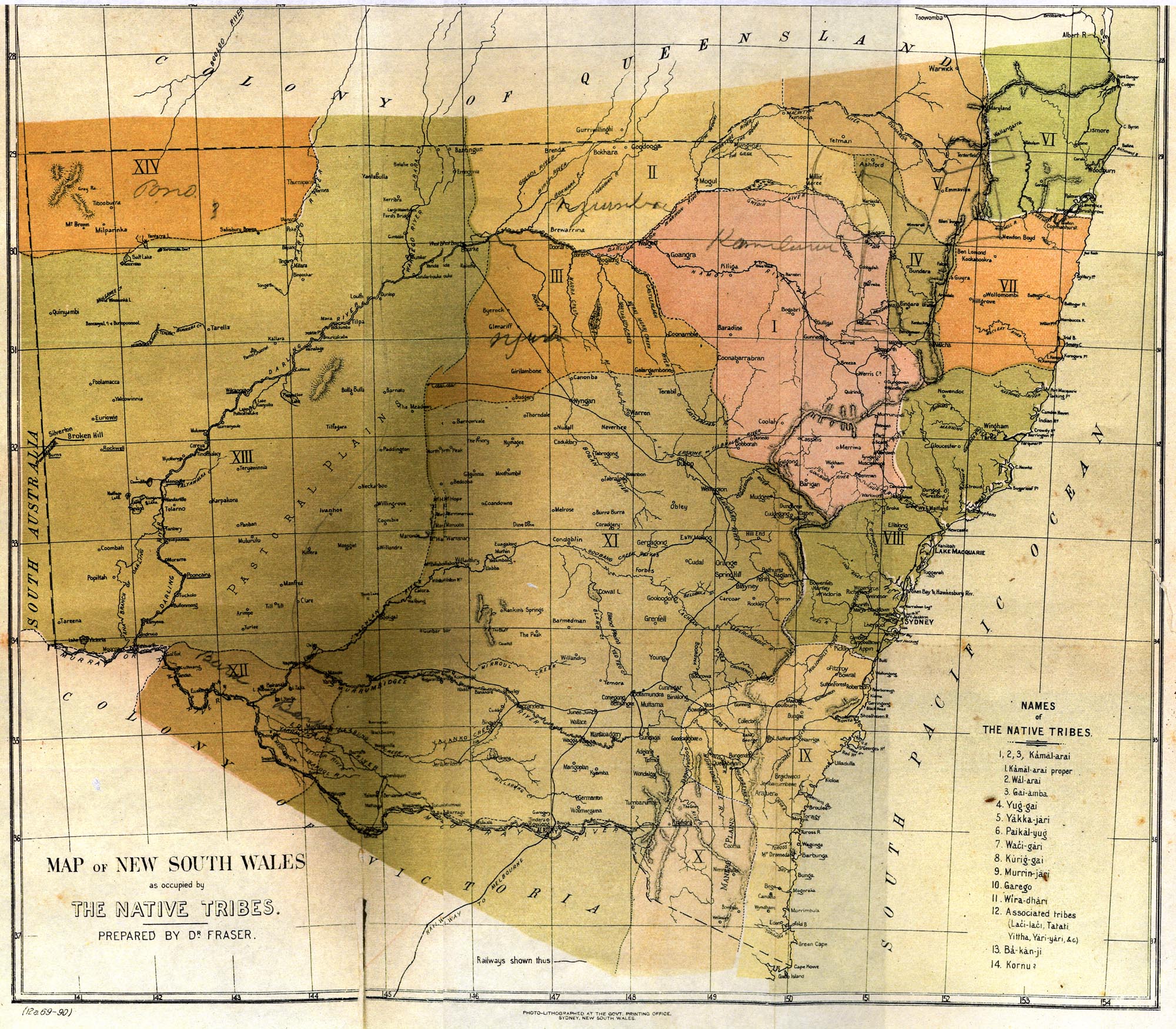
Older Australians Welcome Albanese Government’s High Priority On Aged Care Reform As Bills Introduced On First Day Of Government Business
100,000 Seniors Now Using Digital Seniors Card
Researcher Awarded For Infection Work
Inflation And The Aged Pension The Hare And The Tortoise
Housing Taxation In OECD Countries: New Report
AvPals Term 3 2022: Training At Newport

Delivering A Plan To Fix Aged Care
Capability Review Of The Aged Care Quality And Safety Commission
Clues To Age-Related Macular Degeneration Revealed
Chores, Exercise, And Social Visits Linked To Lower Risk Of Dementia
‘Weekend warrior’ exercise still lowers risk of premature death – new research

We’re all told time and again just how important it is to exercise for good health. But with our busy schedules, finding the time to work out is often easier said than done. For many of us, the weekend is the only time we can get to the gym or go for a run.
UK exercise guidelines suggest that adults should do at least 150 minutes of moderate exercise (or 75 minutes of vigorous exercise) a week for good health. But debate is growing around the issue of whether or not you can still get the benefits of exercise if you squeeze it all in on a weekend (sometimes called “weekend warrior” exercise) instead of spreading it throughout the week. This is what a recent study sought to find out.
They found that weekend warrior exercise still has many benefits to health – with the study showing people who only exercise two days a week had lower risk of premature death from any cause, compared to people who do not exercise. But, they also found that spreading your workouts throughout the week was associated with the greatest benefits for your health.
To conduct their study, the researchers looked at more than 60,000 adults aged 40 and over. Data on the participants was collected by the Health Survey for England and the Scottish Health Survey between 1994 and 2012. Participants were also asked about their exercise habits.
Participants were then categorised as being a “weekend warrior” (meeting recommended activity guidelines over a minimum one to two days per week), “regularly active” (meeting recommended activity guidelines over a minimum of three days per week), “insufficiently active” (exercising less than recommended) or “inactive”. Using data from the surveys and The British National Health Service Central Registry for Deaths, the authors then compared how many from each category had died during the study.
Weekend warrior exercisers had a 30% lower risk of premature death from all causes compared to inactive people. Risk of death from cardiovascular disease was also around 40% lower, while risk of death from all types of cancer was around 18% lower compared to those who were inactive.
Of course, regularly active people had the best health overall – and had a 5% lower risk of premature death from any cause compared to weekend warriors. This finding is consistent with previous research, which suggests the more exercise you do, the more beneficial it is to your health. But this is only true up to a certain point – with research showing that doing more than five times the minimum recommended weekly activity (the equivalent of around 12.5 hours of moderately exercise, or just over six hours of vigorous activity) has no added benefits.
Weekend Warriors
It’s well-known that exercise improves our cardiorespiratory fitness, which is important for making sure our heart and lungs function effectively. Not only does this allow us to exercise longer and more intensely, it also improves other aspects of our health – such as lowering blood pressure. This is also likely the reason research shows people who exercise regularly have lower risk of premature death from any cause.

Exercise also lowers body fat and reduces inflammation, which may all explain why physical activity reduces risk of death from cancer.
But research shows that how often you exercise is also important for improving and maintaining fitness. In fact, as little as 72 hours between workouts is enough for “detraining” to happen. This refers to the partial or complete loss of training adaptations (such as better cardiovascular function) that happens when we stop exercising. While some detraining is likely to happen in people who only exercise on weekends, consistently training – even if it’s only on weekends – will still lead to adaptations that are good for health.
While this research gives hope to those who can’t exercise regularly, it must be interpreted with caution. The study has limitations, as acknowledged by the authors. The data was self-reported by participants, some of whom may have embellished the amount of exercise they really did. Also, the amount of exercise participants reported on only referred to the amount they did in the four weeks prior to the interview, which might not actually represent how much they did for the duration of the 20-year study. The researchers also excluded the physical activity a person did as part of their job. This is relevant as it can also contribute to lower risk of death from disease.
The key message from this study is that doing some physical activity is better than doing nothing. So if you can only get your workouts in on weekends, you’re still likely to have better health compared to someone who does not exercise regularly. But the more regular physical activity you can do, the better.
Exercise, combined with a proper diet, is essential for good health. Adding in resistance training (such as weight lifting) alongside cardio may help further boost the benefits of exercise on your health.![]()
Jonathan Taylor, Lecturer in Sport and Exercise, Teesside University and Michael Graham, Senior Lecturer in Sport and Exercise Science, Teesside University
This article is republished from The Conversation under a Creative Commons license. Read the original article.
The Manly pride jersey furore is not as simple as a choice between inclusivity and homophobia

This week, seven NRL players boycotted a potentially crucial season game over their club’s introduction of a “pride” jersey celebrating inclusivity and the LGBTQIA+ community.
Six of these players are of Pacific Island heritage. There has been much discussion of the players’ culture and religion in the aftermath of the bungled jersey release. But as Fijian scholar Jioji Ravulo has argued, homophobia is not “part of” Pasifika cultures, but rather part of ongoing colonial legacies.
I have previously conducted research on how “masculine” sports such as rugby league were used in the Pacific to promote the British ideology of “muscular Christianity”. This in turn helped create the contemporary relationship between family, faith and football for the Australian Pasifika diaspora.
In times like this, when high-profile sporting entities are thrown into the identity politics spotlight, it is important to try to understand some of the historical connections between the sport and gender and sexual diversity in the Pacific Islands.
What Is ‘Muscular Christianity’?
“Muscular Christianity” is the belief that by participating in sports, young men would become imbued with positive character traits enabling them to be as capable in the classroom or workforce as they were on the field. The concept migrated to the Pacific through British colonialists, particularly the British school boy system and its use of sports to create the “good” Christian.
While the field became a place men could let off steam, Indigenous men were often limited to this physical realm only and pushed away from intellectual pursuits, creating the manual workforce needed for Empire building. Māori scholar Brendan Hokowhitu’s work shows how British colonialists in Aotearoa symbolically and physically moved Māori out of the classroom and into manual labour. This construction of Māori men as purely athletic was being similarly fostered across the Pacific, where the illusion of the “noble savage” was taking hold.
The Impact Of Colonial Masculinity
This colonial reframing of Pasifika masculinity also sought to classify “right” and “wrong”, particularly when it came to gender and sex. An important aspect of colonial masculinity was the suppression of sexual complexity and qualities that were deemed “feminine”.
In the Pacific Islands, this included introducing distinct boundaries between men and women, and the delegitimising of anything in between. Before colonialism, gender was understood in what we may think is a very modern, Western way, but what has actually been understood amongst many Indigenous cultures for centuries: that is, a “gender spectrum” or the idea that there are many gender identities.

In Samoa and Tonga, for example, the gender fluid fa‘afafine and fakaleiti were merged with European understandings of homosexuality with such success that we now know very little about their roles pre-contact. At the same time, homosexuality was condemned as un-Christian, perverted and wrong – both symbolically, and in many cases, legally.
This combination of muscular Christianity, sports, and the moralisation of gender meant that to be a “good” man was to be not only strong and disciplined, but heterosexual and God-fearing.
Individual Freedoms Vs Family And Faith
In my interviews with second-generation Pasifika people in Australia, the phrase “faith before footy” was common. However, the nature of faith was changing, with family becoming more central than the institution.
Pasifika scholars have explained that rather than the individualistic philosophy of “I think therefore I am” governing how they see themselves, Pasifika and Māori people work more within a framework of “I belong therefore I am”.
Relationships are where strength and identity are created, which is what makes it so difficult to go against family beliefs. It might be hard for people who have a strong sense of individual freedom to comprehend the complex pull of family and faith to one’s very existence, but for many Pasifika people, not belonging could feel utterly catastrophic.
Sport has always been a political space, and in Australia it has a symbolic potency that makes it a powerful arena for spreading positive messages.
Hopefully the conversations this latest controversy has started outweigh the negative effects, particularly on young, vulnerable queer people. It is hoped we might soon reach a space where gender and sexual diversity in rugby league can be as celebrated as racial and ethnic diversity has been for some time.
With their large and conspicuous presence on the field, Pasifika people play a role in this, but it’s not solely their responsibility. It is up to the decision makers at all levels of the game to learn how to foster inclusion for all.![]()
Gina Louise Hawkes, Research associate, University of Wollongong
This article is republished from The Conversation under a Creative Commons license. Read the original article.
4 in 10 nursing homes have a COVID outbreak and the death rate is high. What’s going wrong?

Around 3% (6,100) of the 200,000 residents in Australia’s aged care facilities had COVID, as of July 22, in addition to 3,400 staff.
About 1,000 facilities – nearly 40% of the total – had an outbreak.
Aged care residents are also disproportionately dying of COVID. Those in nursing homes account for nearly 30% of the 11,000 deaths from COVID in Australia throughout the pandemic.
Why Is This Happening?
Age is a major risk factor for COVID. People aged 70 and over make up 85% of all reported COVID deaths.
People in residential care are the most frail and at risk. Aged care residents make up around 40% of the deaths of older Australians, but only about 5% of the population aged 65 and over live in residential care.
We’ve long known how to reduce the spread of COVID and unnecessary deaths. Effective responses throughout the aged care sector include:
- all residents and staff being fully vaccinated
- appropriate availability of personal protective equipment and rapid antigen tests (RATs)
- mask mandates for staff and visitors
- widespread use of antiviral treatments for those who catch COVID
- rapid responses to outbreaks, including a surge workforce and coordination with home care, GPs and hospital services.
But while mask mandates remain a requirement in residential aged care for staff and visitors, and RATS and PPE are now generally available, the other responses are still patchy, piecemeal and poorly coordinated.
Vaccination
Vaccination is the most important protection against COVID. People who are unvaccinated are about 50 times more likely to die from COVID compared with those who are fully vaccinated.
Yet, vaccinations in residential aged care has been a shambles. Early on in the rollout for aged care, staff weren’t fully vaccinated, there were squabbles over staff vaccination mandates, vaccination data was unavailable, and it was unclear who was responsible for making sure vaccination occurred.
While mandates have lifted worker vaccination rates, in June this year, only 50% of aged care residents were fully boosted with fourth doses.
That has improved following pressure from the new government. But even now, a quarter of residents are still not fully vaccinated with recommended boosters.
More needs to be done to systematically follow up facilities with low vaccination rates.

Antivirals
Early use of antivirals significantly reduces the risk of hospitalisation and death from COVID, possibly as much as 80%.
It has been clear for about six months that antivirals are a safe and effective COVID treatment. However, it wasn’t until July 11 that the Commonwealth Chief Medical Officer advised that all Australians 70 or older should be offered antiviral treatment within 24 hours when they test positive for COVID (where clinically appropriate).
The reality is that many older people who could benefit from antivirals aren’t getting them and they are going to waste, with thousands of doses nearing their use-by dates.
Rapid Responses To Out Outbreaks
The new federal government appears to be tackling the issue with new urgency. The new aged care minister, Anika Wells, has released a “winter plan” to try to address the aged care crisis.
The plan includes prevention, outbreak management and recovery. But the plan continues to put most of the responsibility of prevention and management on individual providers – a strategy that has been ineffective in the past.

The federal government has almost no capacity to effectively coordinate a winter response across residential care, home care and health and support services within local service networks where it is needed.
Ideally, this would see close working relationships between aged care facilities, GPs and local hospitals, including the redeployment of clinical and support staff across facilities as required. This happened in Victoria during the 2020 outbreak.
But despite the recent Royal Commission’s recommendation to do so, the federal government has not put in place local or regional bodies or authorities to plan, coordinate and manage aged care.
Staff Shortages
These pressures are hugely exacerbated by staff shortages. The over-reliance on a privatised market model for aged care and the decades-long under-investment in training, supervision, pay and conditions for aged care workers has come home to roost at the worst possible time.
Estimates suggest there is a shortfall of 35,000 workers in aged care, double the problem last year.
The industry is hoping the work value case before the Fair Work Commission will make a difference on these issues. Personal care workers in aged care are paid about the same as workers at McDonald’s – in some cases, less. Unions are arguing for a 25% increase in pay, which should make aged care a more desirable job, but this case won’t be determined for months.
In the meantime, the industry still does not have a realistic workforce strategy. The federal government is scrambling to implement short-term measures through a “surge workforce”, including the recent deployment of 200 military personnel.
But this is unlikely to be enough to address the staff shortages associated with the winter wave. Some providers are now reporting they are down 20-40% of staff.
The result is excess hospitalisation and death, misery for residents and their families, and stress for staff and providers. If the situation continues to deteriorate, this will have to become a major priority for National Cabinet.
And the already stretched state health systems will have to play a greater role to fix the immediate problems.![]()
Hal Swerissen, Emeritus Professor, La Trobe University
This article is republished from The Conversation under a Creative Commons license. Read the original article.
Here’s a simple way to stop governments giving jobs to mates

Handing out a cushy job to a political mate might seem harmless – after all, everyone does it, right? – but the politicisation of public appointments has real, pervasive consequences for Australian democracy. Increasingly, many government boards, tribunals and independent agencies are stacked with people who have worked in politics.
A new Grattan Institute report, released today, shows that political appointments are common at state and federal levels. It reveals the costs all Australians bear when governments choose mates over merit.
Political Appointments Are Widespread
About 7% of federal government–appointed jobs in public bodies are filled by people who have worked as a politician, political adviser, candidate or party employee.
But this is just the baseline. Political appointments triple to 21% for jobs on well-paid, powerful and/or prestigious boards. That’s one in five of these top public roles. Individually, many of those people may have the right qualifications, but collectively their presence undermines these important positions.
On the boards of Australia Post and other federal government businesses – companies employing thousands of people and managing income in the billions – more than 20% of members have a political connection. In most states, the figure is above 10%. This is in stark contrast to ASX100 boards with very similar responsibilities, where fewer than 2% of board members have a direct political connection.
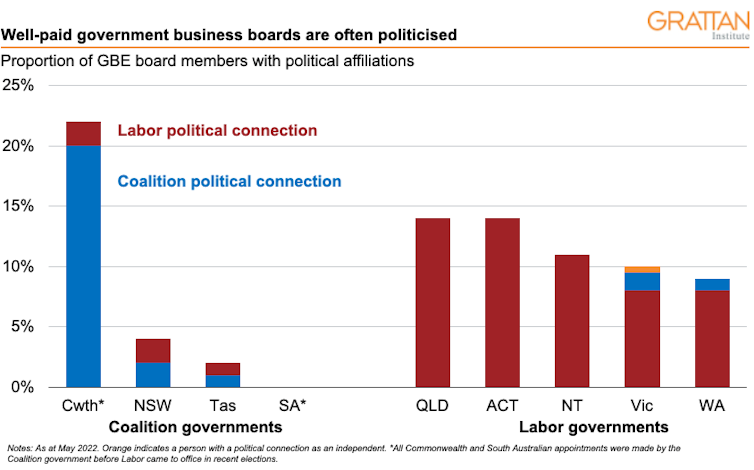
The boards of powerful independent government bodies, including regulators and commissions, are also filled with political appointments. Half of the members of the Productivity Commission board, for example, have a connection to the Coalition.
While skills established in a political career might be valuable, most political appointees are from the same side of politics as the government that appointed them. The signs are that mateship is prevailing over merit.
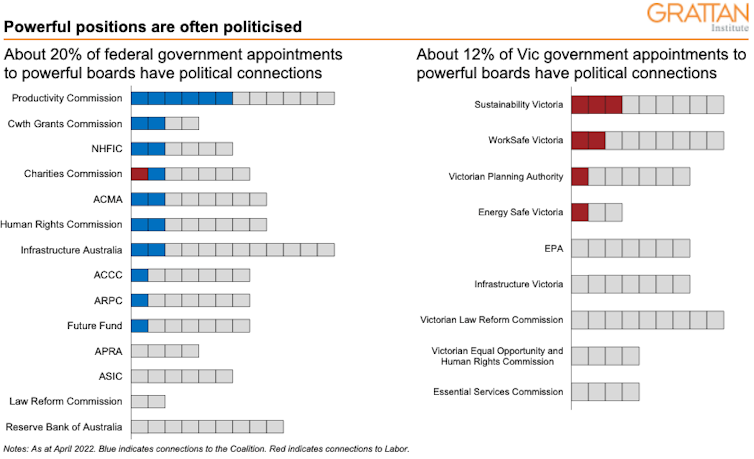
Political stacking is especially evident on the Administrative Appeals Tribunal (AAT), an independent expert body that reviews government decisions on everything from child support to migration status.
The AAT has become an attractive destination for political appointments, offering the full trifecta of powerful, prestigious and well-paid (AAT member salaries range from nearly $200,000 to nearly $500,000). A staggering 20% of the AAT’s 320 tribunal members have a direct political connection to the government that appointed them.
And the problem seems to be getting worse. Political appointments to the AAT have grown substantially in the past five years. Many of these appointments were made in the lead-up to the 2019 and 2022 federal elections.
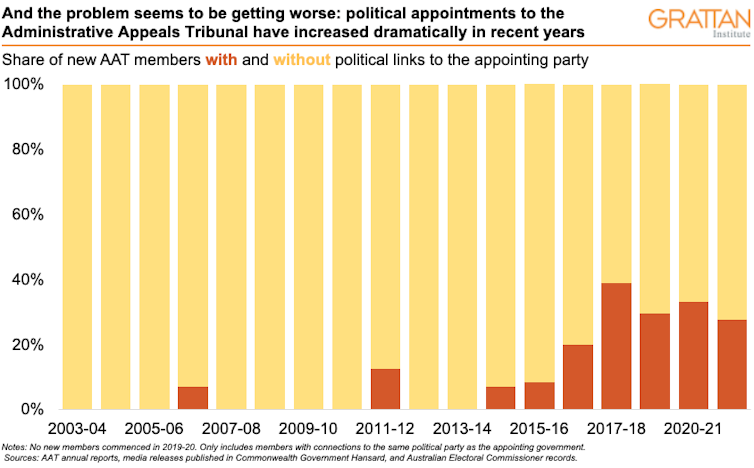
Political Appointments Damage Institutions And Trust
Public appointments shouldn’t be regarded as “nice things to give to mates”. People in these roles make important decisions that should be kept at arm’s length from government. In some cases, political appointees have significant influence over public policy.
Politicising public appointments can compromise government regulation and oversight, promote a corrupt culture and undermine public trust in the institutions of government.
“Captain’s picks” don’t always have the skills and experience needed to carry out their responsibilities effectively. A Grattan Institute analysis of performance data shows AAT members with political affiliations perform worse on average than those without. Almost a quarter (24%) of political appointees fall well short of their performance targets, compared to 17% of non-political appointees.
Even if the person appointed is fully capable of doing the job, their presence can compromise the perceived or actual independence of the institution. These appointments promote a culture of patronage in which loyalty is assumed to be more important than merit. A culture of this kind can have a chilling effect on non-political candidates and appointees too – they may fear that rocking the boat or providing frank and fearless advice will be career-limiting.
A Better Way
If Australia had a better process for making public appointments, we could be confident appointees were there on merit, whether they are politically affiliated or not.
This problem has an easy fix. Federal and state governments should establish a transparent, merit-based process for all public appointments. As the chart below shows, the new process should be legislated and overseen by a dedicated public appointments commissioner. The commissioner’s work would restore public confidence in appointees and lift the performance of public sector boards and tribunals.
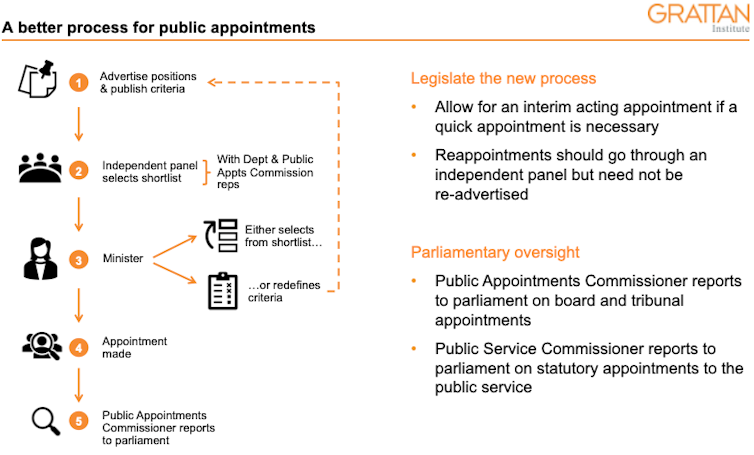
This process could help change the culture: seeking the best person for the job would become the only consideration ministers bring to bear on their decisions. If the new federal government is serious about doing politics differently, this is an easy change that would make a real difference.![]()
Kate Griffiths, Deputy Program Director, Grattan Institute; Anika Stobart, Associate, Grattan Institute, and Danielle Wood, Chief executive officer, Grattan Institute
This article is republished from The Conversation under a Creative Commons license. Read the original article.
Officials resisted Morrison government’s attempt to have them ‘amplify’ election day boat arrival
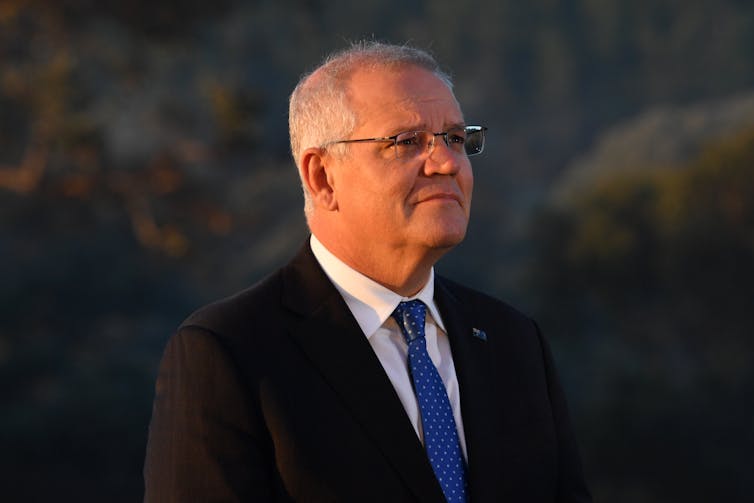
Federal public servants resisted the Morrison government’s attempt to have them amplify an election-day announcement that an asylum seeker boat had been intercepted, according to an inquiry into the incident.
The government hoped publicity about the boat would reinforce its argument a Labor government would trigger the reopening of the people smuggler trade, swaying some voters at the last moment. The Liberal party sent millions of texts about the interception.
The Labor government ordered the Secretary of the Home Affairs Department, Mike Pezzullo, to investigate the events of the day. The report was released by the government late Friday.
A timeline documents how the Morrison government wanted the statement about the boat’s interception sent directly to journalists and posted on social media, but officials declined to do so.
Late morning on May 21, the Minister for Home Affairs’ Office (MHAO) told the bureaucracy the Prime Minister’s Office had asked for a statement to be published about the interception. The statement was to be issued urgently.
Also, “MHAO requested for the statement to be emailed to a list of journalists identified by them. The Department advised that this was not likely a possibility and not something that has been done in the past,” the report said.
“The Department relayed the direction from MHAO to the Secretary [Pezzullo] about emailing journalists. The Secretary directed this is not to occur.”
The department told the minister’s office of Pezzullo’s position.
The minister’s office “directed that the statement be urgently published on the website and requested that the ABF [Australian Border Force] tweet the statement. The Department declined to tweet and advised that arrangements would be made to publish the statement.”
Pezzullo then directed the department that “under no circumstances” was it “to drop the story to selected journalists”. He told it the release “is to be posted to our news and media site – no more and no less”.
Just after 1pm, Morrison commenced a news conference where he was asked by a journalist about the statement – minutes before it appeared on the official website.
In a June 1 letter to Home Affairs Minister Clare O'Neil, accompanying the report, Pezzullo writes it was the responsibility of the minister (who was Karen Andrews) to determine whether it was in the public interest for the interception to be made public.
“The legitimate purposes for previous publications of interceptions have been considered to be for transparency and deterrence,” he writes.
“It was for the Minister to determine the purpose of the announcement.”
“The apolitical character of the public service was preserved in this instance by the refusal on the part of departmental officials to amplify the public statement by sending it directly to journalists and to post it on social media,” Pezzullo says.
“The transparency and deterrence effect was already available from the original public statement.
"Any domestic amplification was judged by officials to be primarily for political purposes. Accordingly, they declined the relevant requests.”
Pezzullo writes that had ministerial instructions been given for amplification, such action could have been contrary to the legal provision for public servants to be apolitical.
“But this potential conflict between the exercise of ministerial authority and that provision in the Act did not arise as the requests to amplify were not pressed”.
In his letter, Pezzullo suggests amending the caretaker conventions that operate during election campaigns. This would specify “that sensitive information that is potentially politically significant should not be released publicly during the caretaker period unless a threat to life exists or some other urgency concerning public safety and security is involved.”
O'Neil said in a statement that the Morrison government had “sabotaged the protocols that protect Operation Sovereign Borders for political gain”
“The report found uniformed Border Force and Defence Force members, and public servants, acted with integrity and at the highest standards at all times. They should be commended for doing so.
"The profound compromise of a military-led operation is without precedent in Australia’s history. It was disgraceful, shameful, and characteristic of a national government which frequently pursued political interests above the national interest,” she said.![]()
Michelle Grattan, Professorial Fellow, University of Canberra
This article is republished from The Conversation under a Creative Commons license. Read the original article.
Extra Cheers For The Green And Gold
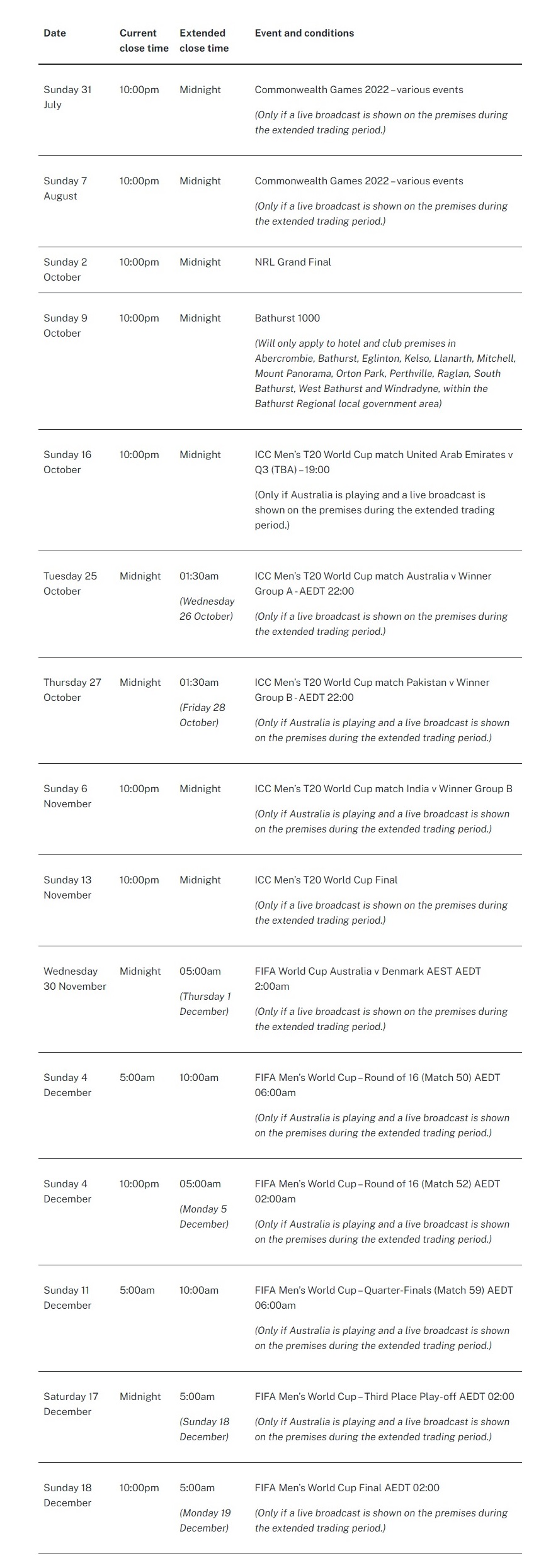
UNSW Multilingual Graduates Set To Help The State's Diverse Communities
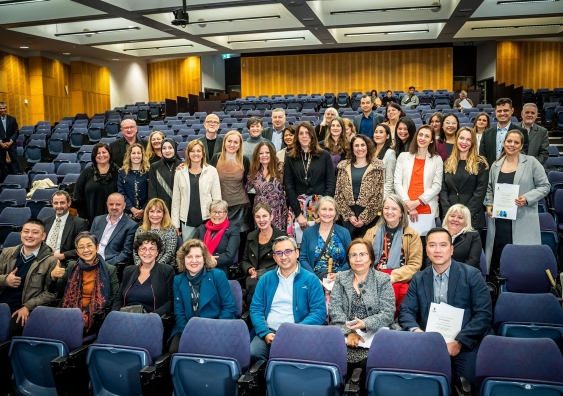
New Tool Uncovers 'Elegant' Mechanism Responsible For Antibiotic Tolerance In Golden Staph
New Study Challenges Old Views On What's 'Primitive' In Mammalian Reproduction

Weak Handgrip Strength May Signal Serious Health Issues
University Of Melbourne Researchers Discover Gene That Promotes Muscle Strength During Exercise
The World's Largest Omnivore Is A Whale Shark
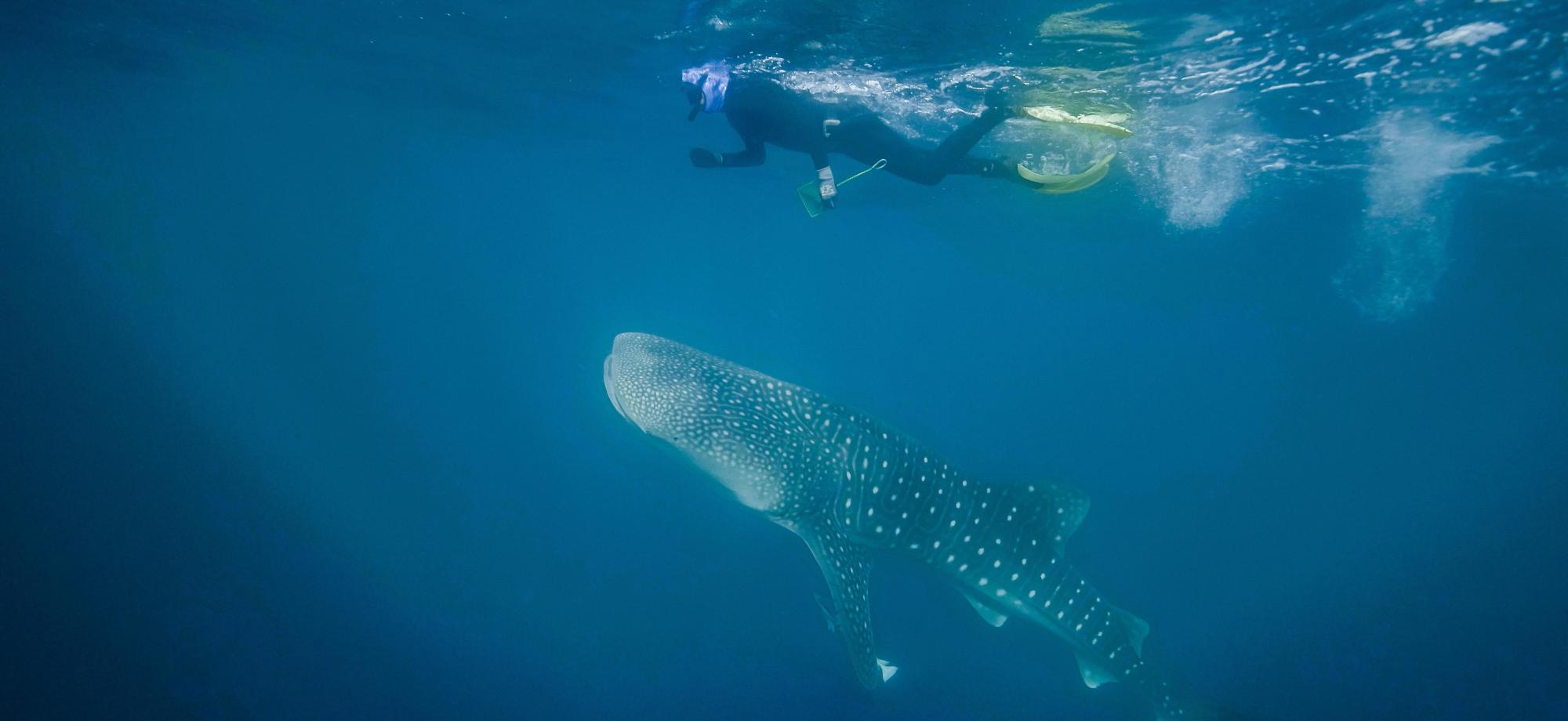
Disclaimer: These articles are not intended to provide medical advice, diagnosis or treatment. Views expressed here do not necessarily reflect those of Pittwater Online News or its staff.